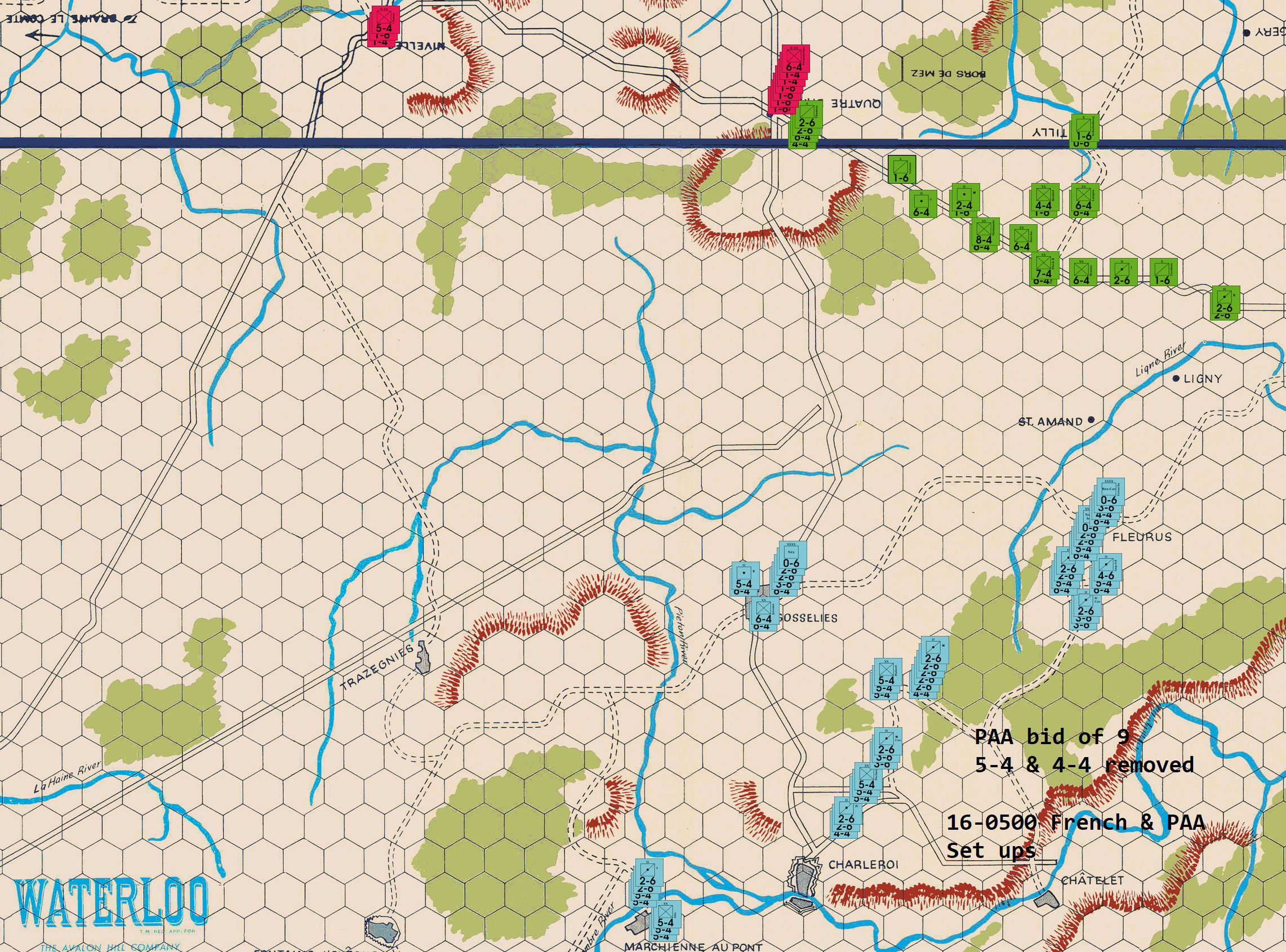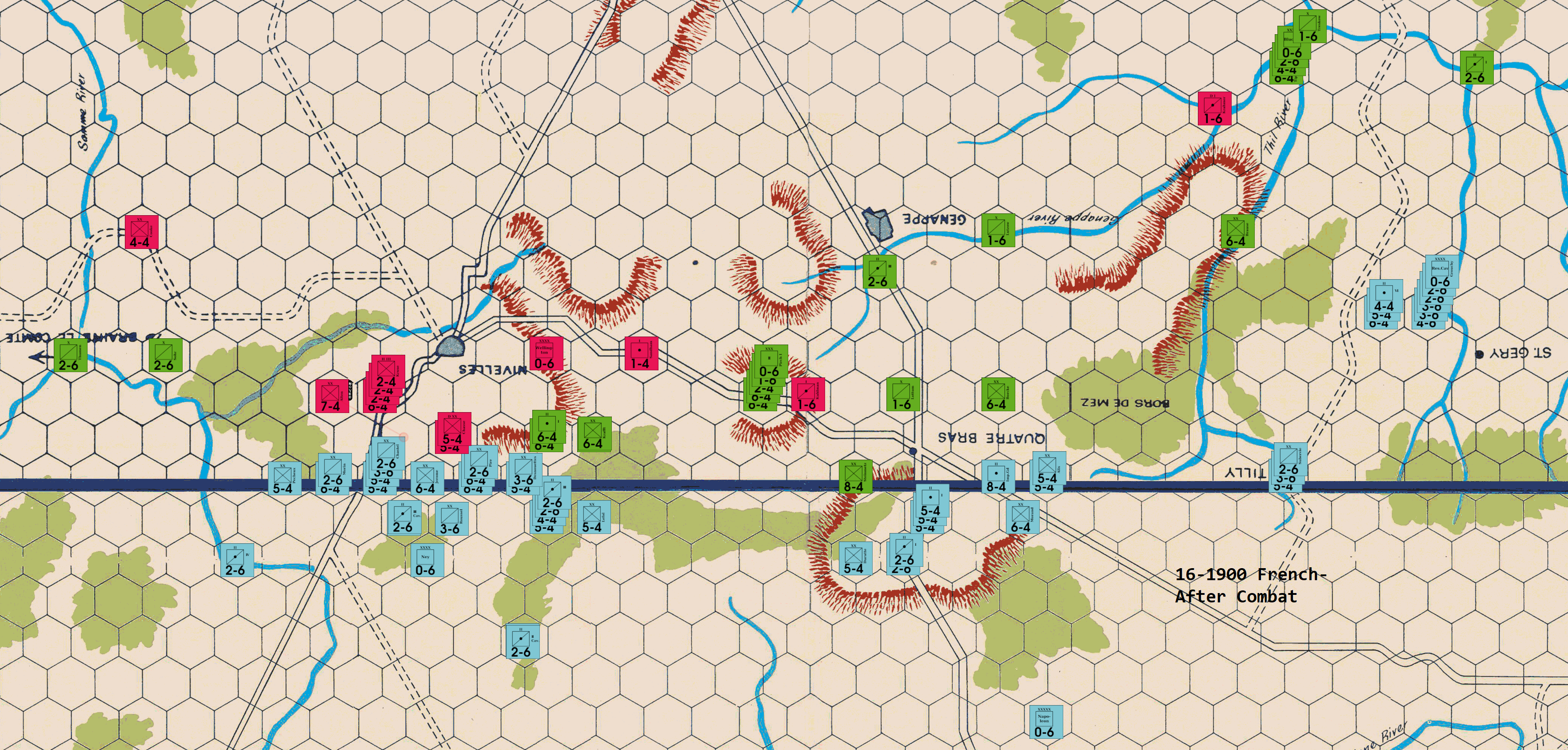
Updated March 13, 2021. Home
Sadly I don't see a mathematical chance for the PAA at this point. I am 1 turn short of space. The La Lasne river worked against me with advance after combat, and I should have perhaps fought a turn or two earlier on the 18th. I must concede.
Congratulations Joe, an interesting match to say the least. You are a very good French player.
Thank you for running the tournament Ed. Looking forward to the next one.
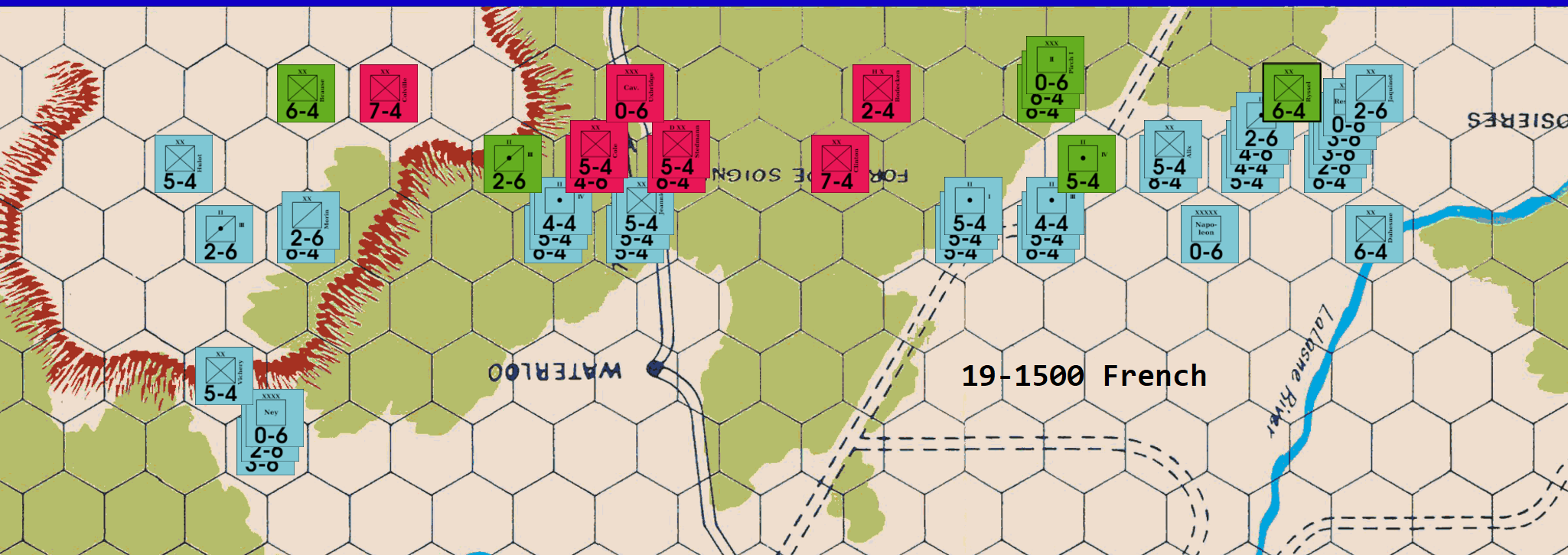
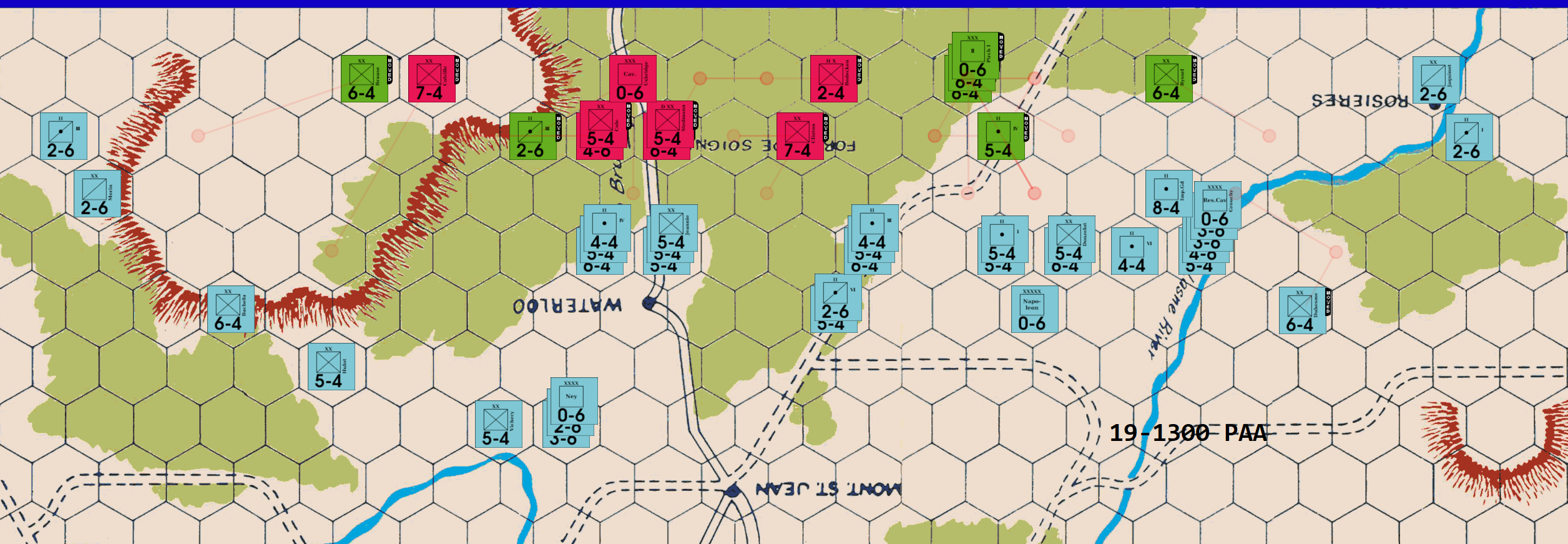
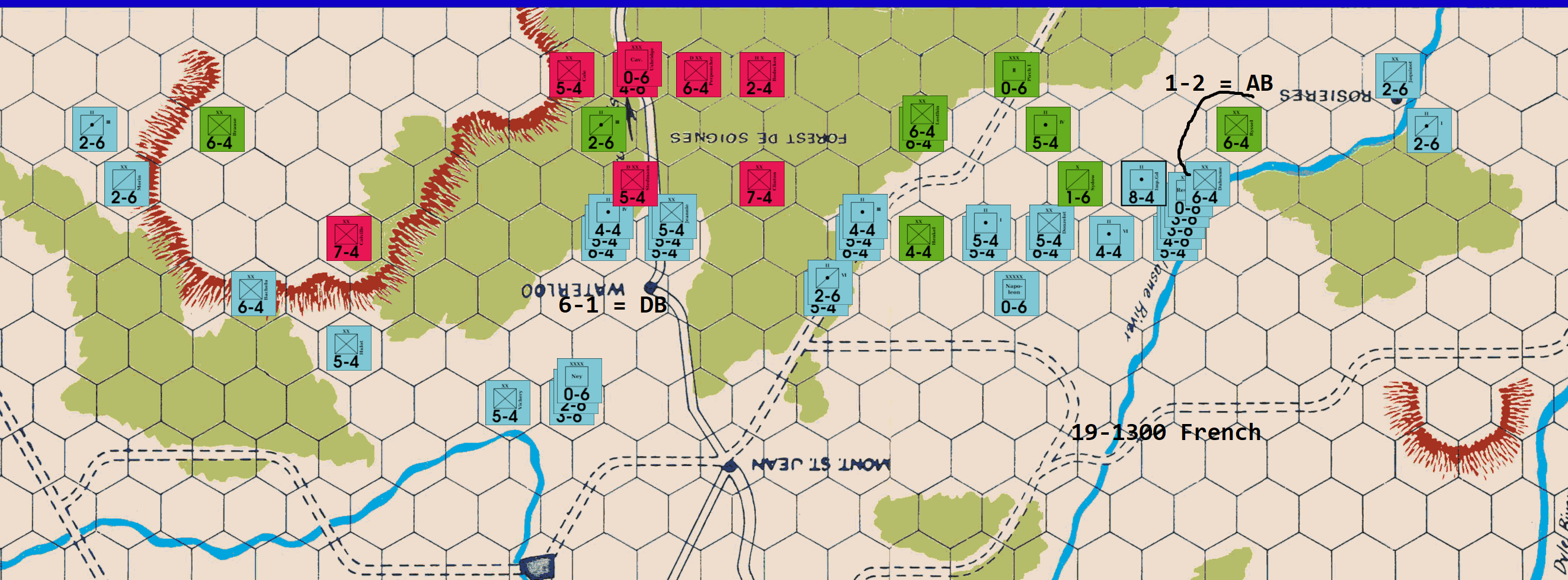
Einstein once observed that: "Repeating the same action over and over again, and expecting a different result is the very definition of insanity." That may well be true, but I still feel compelled to attempt yet another 1-2 (I'm currently zero for five) , as the benefits of a success -- however unlikely -- substantially outweigh the penalty of another failure. Of course, the best case scenario would be to roll a DB2 which would trap Ryssel and force the Prussian 6-4 to attack out while surrounded. However, given my low-odds luck in this game, I am really not counting on it.
So far as the other action in this turn: The French move is pretty much textbook for this phase in the game. In the west, part of Ney's force pursues the retreating Allies as they abandon their defense of the northwestern plateau and fall back on the main Brussels road exit hex. In the center, the remaining units of the French Left Wing attack Stedmann at 6-1: a D Elim would be advantageous, but, given the number of high-odds DB2s that I have rolled in this game, I'm not counting on it. Not surprisingly, the important action is in the east where the French army methodically clears the two Prussian blockers that Richard has put out to impede Napoleon's advance, but these two sacrifices will only barely slow L'Aremee du Nord as it pushes forward towards the eastern Brussels road. I should note that, if the attack against Ryssel is successful, then the game will pretty much be over, if it is not, then a couple of additional rounds of combat will be required to clear the road exit hex.
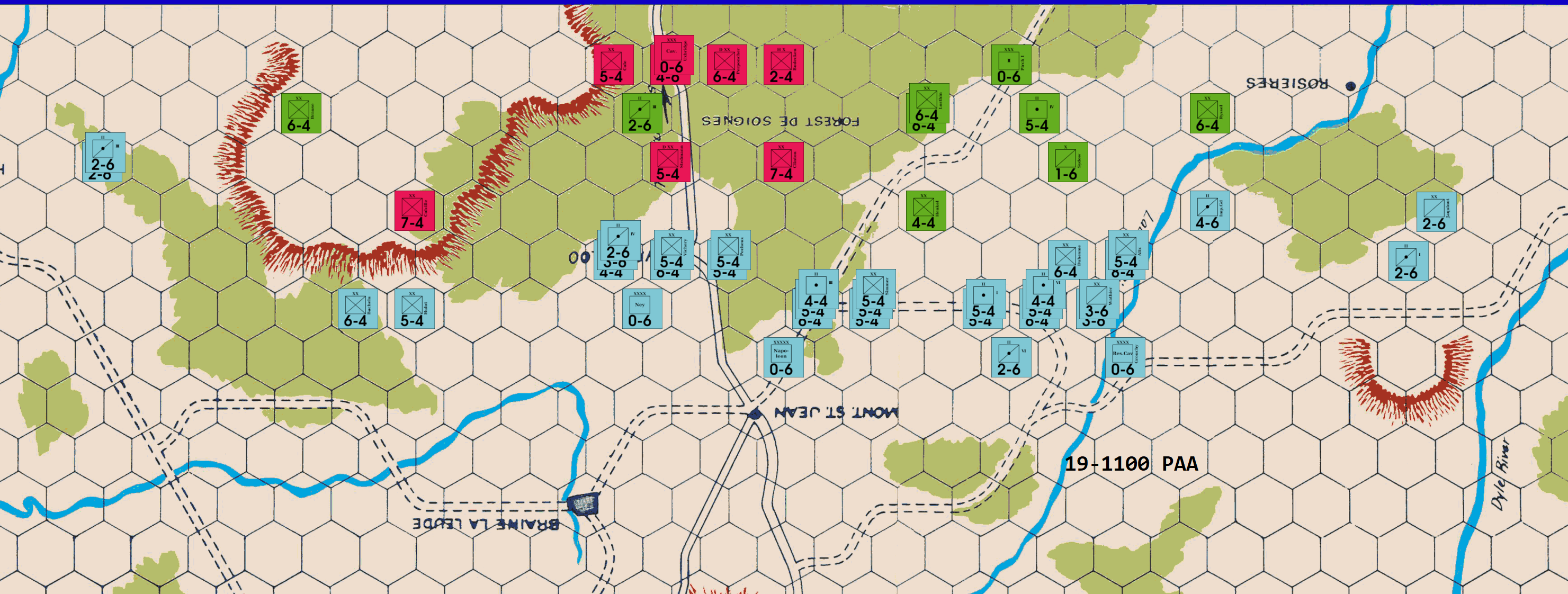
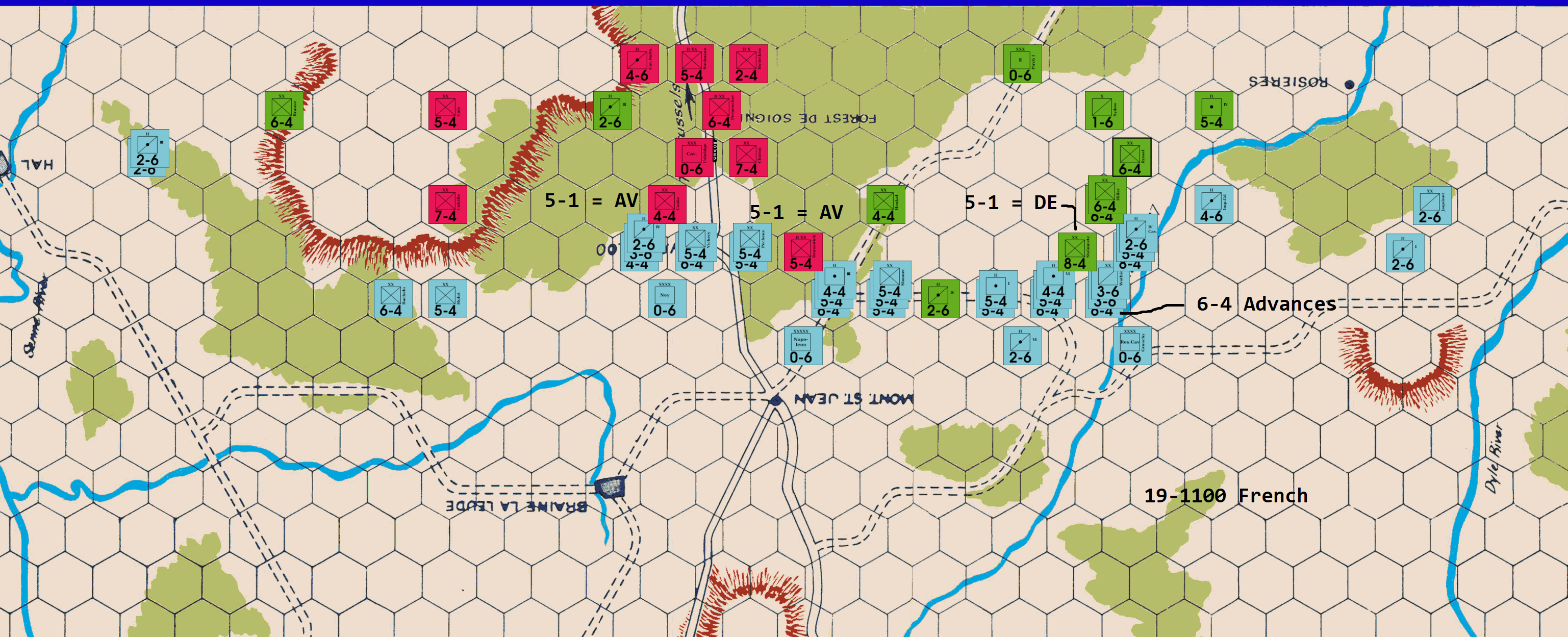
In view of the fact that there are still four game turns remaining, I have decided to dial back on the risky low-odds attacks for a turn to see how things go with this round of combats. Obviously, a key French variable going forward will be the fate of Steinmetz: if the Prussian 8-4 survives yet again, then I can see the necessity of more low-odds French attacks; if, on the other hand, Steinmetz makes the trip to the "dead pile," then L'Armee du Nord should be able to grind down the remaining Prussian resistance in the east without having to revisit the "low-odds well" again. Interestingly, had this been the 1300 game turn, then I would have been obliged to do things very differently, especially in the eastern sector of the battle area; to whit: I would have opened with a 1-2 attack (using cavalry) against Brause, hoping for a DB2 to B35 so that a 2-6 could advance; I would then have attacked Steinmetz at 3-1 or 4-1 and advanced Duhesme after combat; the final attack would have been a 1-2 (hopefully surrounded) against Hiller and Losthin with the 13 factors of Alix and the Imp. Gd. Foot Arty. Thankfully, given my record of zero for five on my 1-2s, I'm actually relieved that I didn't feel compelled to make those attacks on this turn.
So far as my 19 June 1100 French move is concerned: Napoleon's army continues with the late game strategy outlined earlier. In the west, a token force demonstrates against the northwestern plateau so as to pin as much PAA combat power as possible in what is, for all intents and purposes, a strategic "side show." In the center, Ney's main body drives north along the main Brussels road, tying up the bulk of Wellington's army and eliminating Anglo-Allied blockers as it advances. And in the east, the "real" campaign proceeds pretty much as planned. The main French effort in this sector is directed towards prying the Prussians away from the banks of the eastern La Lasne and pushing the whole French battle line within one turn's march of the eastern Brussels road exit hex by the 1500 game turn. Now, all the Emperor can do is await the verdict of the battlefield, and Blucher's defensive response to these latest French moves.
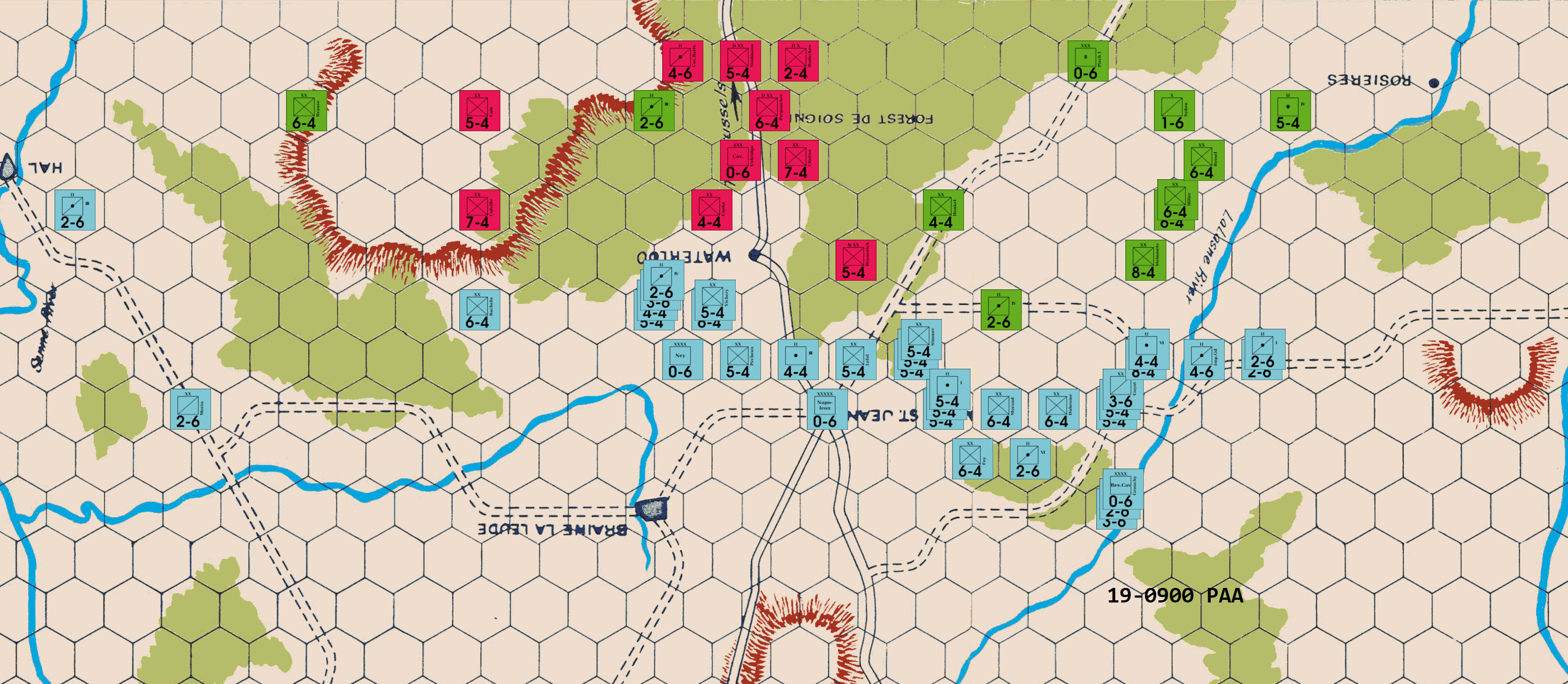
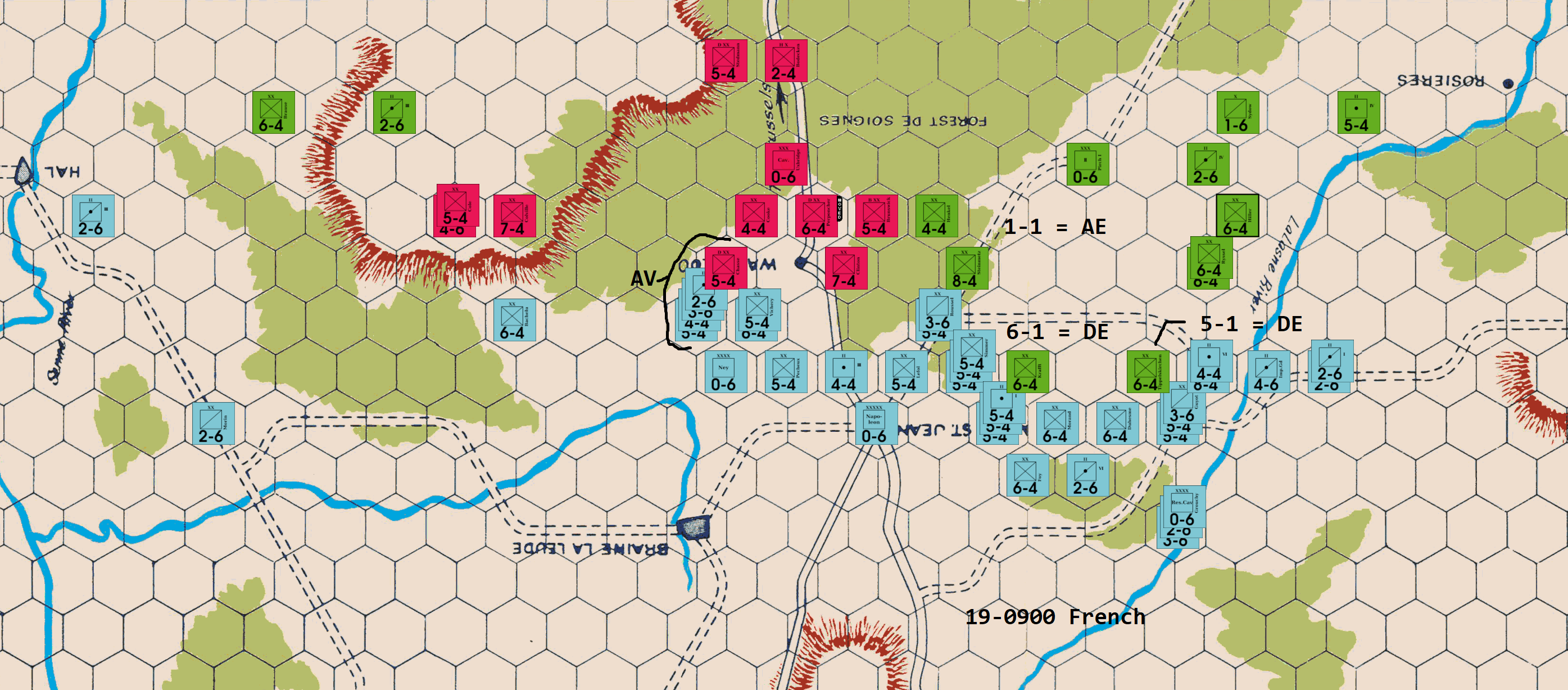
With this game turn, the French problem has now been distilled to its basics, and Napoleon's strategy has also; to whit: continue to apply pressure against Wellington in the west and center, while striving to eliminate enough Prussian units in the east so as to make the defense of the Brussels forest road exit hex indefensible. That said, the French move pretty much makes itself: an AV versus Chasse; a speculative 1-1 (the third one, I should note) against Steinmetz; a 6-1 versus Kraft; and a 5-1 against Tippelskirchen. Obviously, Napoleon's task will be a lot easier if L'Armee du Nord gets a "clean sweep," but the really critical attacks are against Kraft and Tippelskirchen. If both of these attacks should misfire, then the French will have a very difficult time of it, indeed, defeating the Prussians in the east, and exiting the map, in the time still remaining.
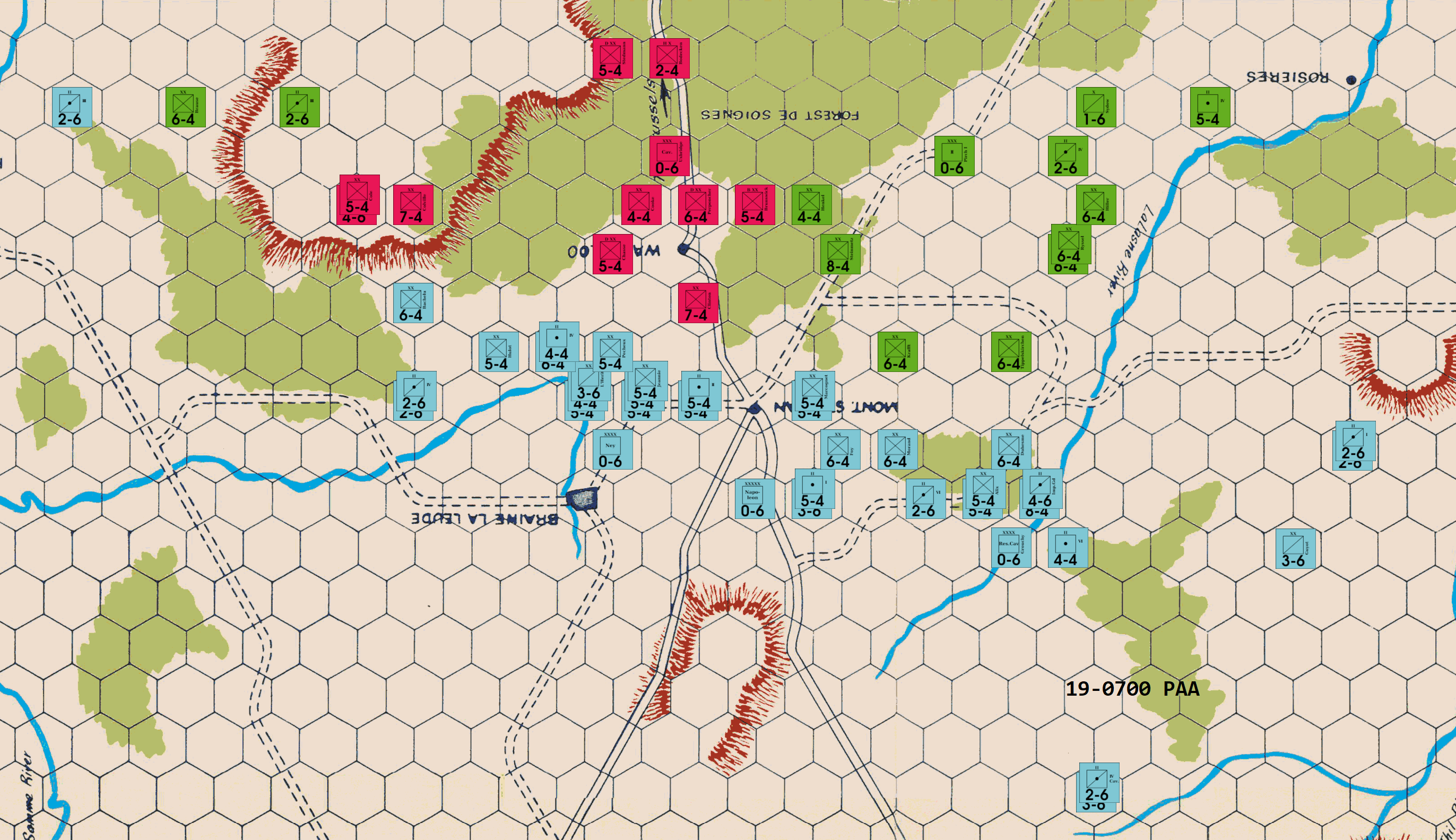
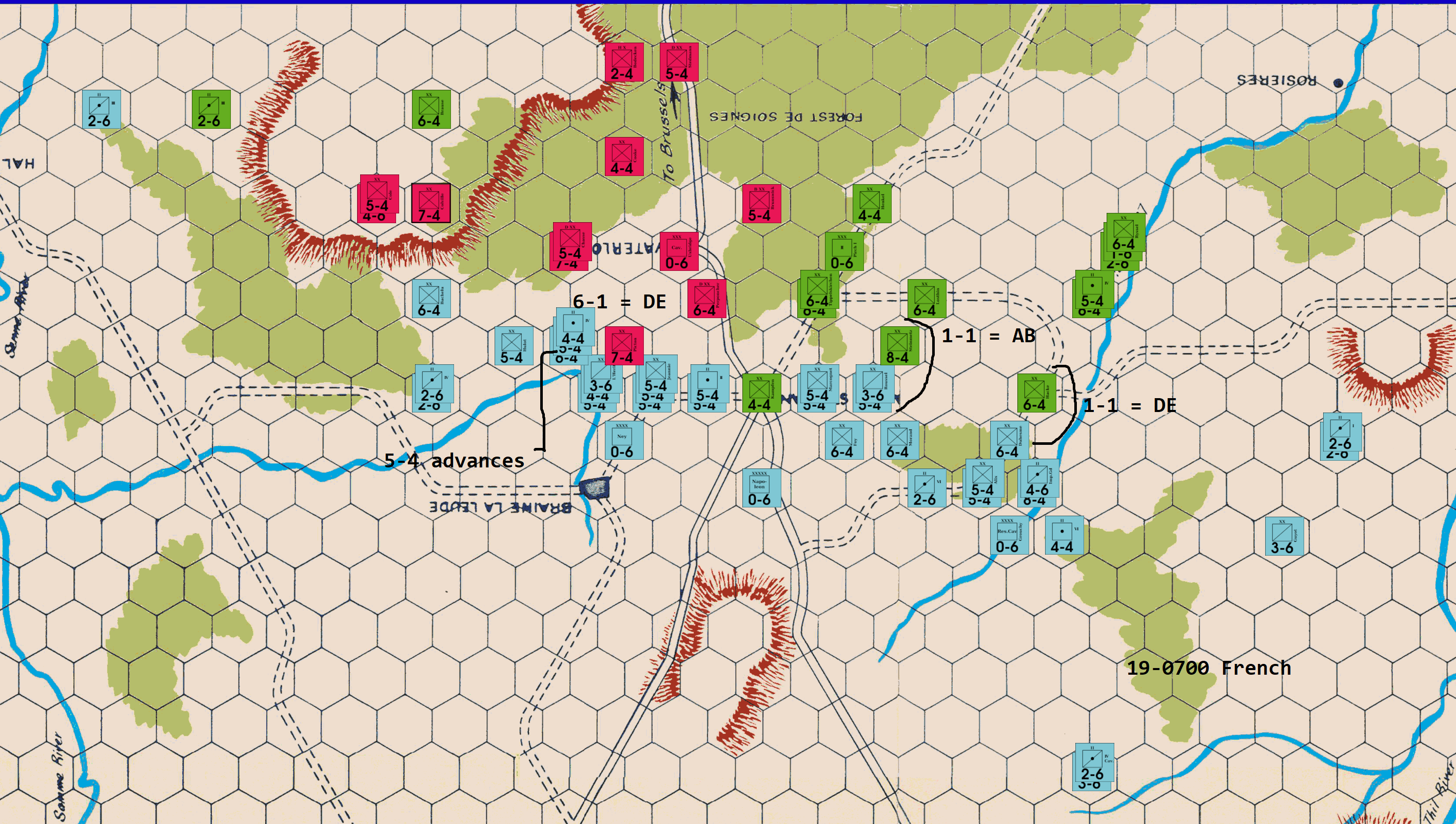
The combat results from the 1900 round of six French attacks were, to say the least, a bit disappointing; the failure of both 1-2s to cause any discomfort at all to Blucher was bad enough (that is now six low-odds misfires in a row), but the escape of both Anglo-Allied 7-4s ( a 9% chance) was especially frustrating. But what's done is done, and as the old saying reminds us: "what cannot be changed must be endured." Of course, to be fair, not all of the French assaults were failures: two Prussian 6-4s were eliminated, and that means that the Allied commander will have very little slack when it comes to the late game defense of the eastern Brussels forest road.
Since I have already described my late game plans a few turns ago, this first French move of the 19th will probably seem pretty obvious, especially as it is completely consistent with the French strategy for the last day of the campaign that I previously outlined.
So far as this move is concerned: The French army now has no choice but to begin taking a few more chances, and although it would be nice to launch a whole flurry of attacks, the paucity of worthwhile PAA targets, and the fact that L'Armee du Nord only outnumbers the combined Allied armies by a mere twenty factors at this point, really limits French offensive opportunities to four attacks: a 6-1 versus Picton; a 5-1 (Surrounded) AV versus Kampfen, and 1-1s versus Steinmetz and Hacke. In the case of Hacke, I would have preferred to attack this unit at 2-1 (so that the French would retain possession of I35 in the case of an exchange) but, unfortunately, I did not have a second 6-4 within range. In any case, with time rapidly running out for Napoleon, French prospects, going forward, will really depend on the dice.
Epilogue: While I was finishing up this commentary, the die rolls hit my "inbox." Surprisingly, given my earlier luck, the combat results for this turn, while not perfect, were actually pretty good for the French. The 1-1 versus Steinmetz resulted in an AB2, but all three of the other PAA units were eliminated with D Elims. Certainly, these are not game winning results, but they are still very favorable to Napoleon, nonetheless.
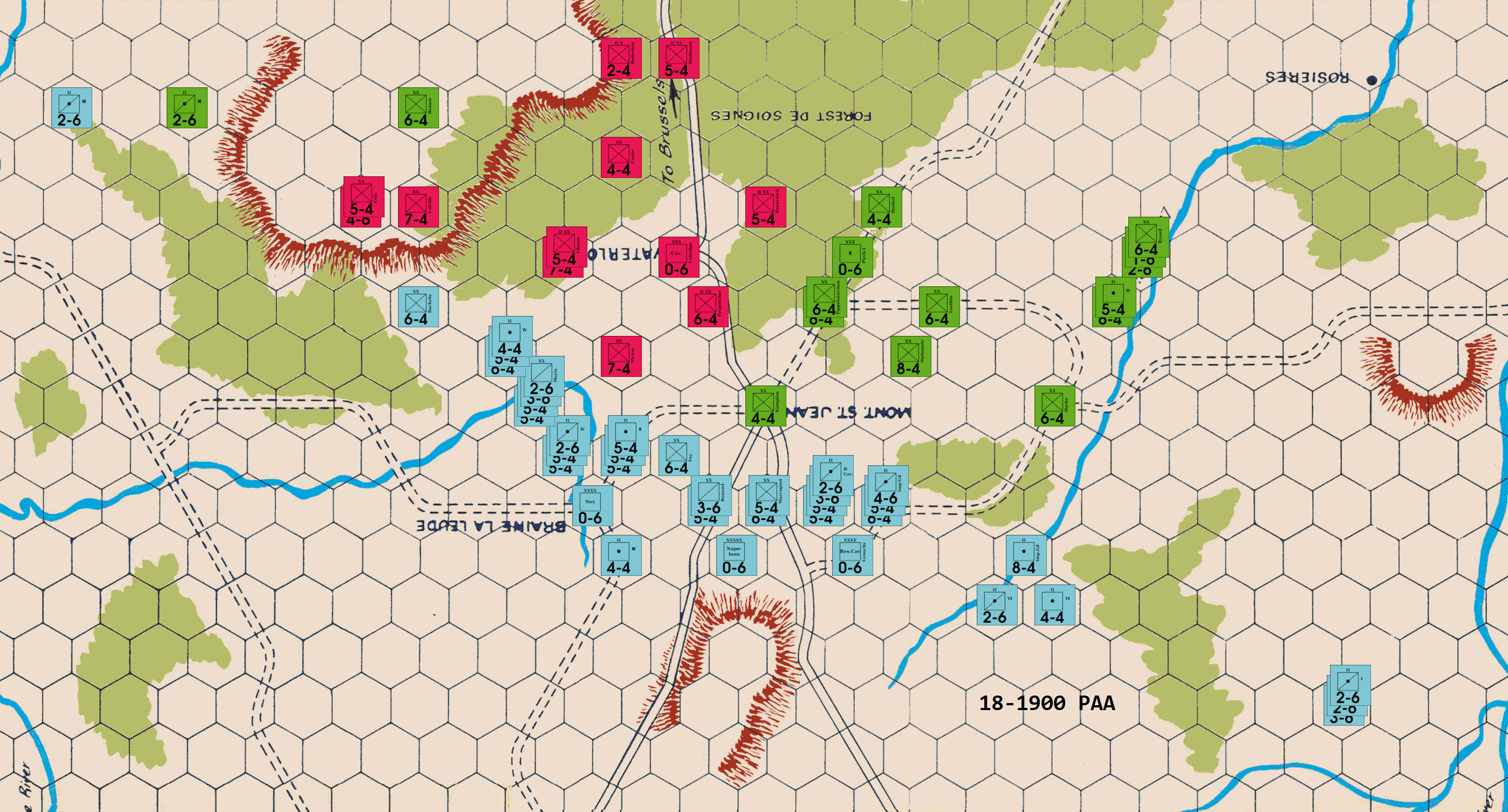
The PAA strategy is clear. Keep the French from Brussels for one more day. There are still lots of Exchanges and D Elims on low odds attacks available to the French. Suddenly D Back 2 results on 1:2s don't seem so bad anymore. I'm running out of space fast though. The dice have been kind to the PAA in the form of several D Back 2s on the 18th. It does seem like a rather silly situation at this point. Hopefully the slow burn of the PAA forces can run out the clock. If the French goes too wild on low odds attacks the PAA might be able to do some limited counterattacking however. Which low odds attacks where, that is the question for the French on the 19th.
Uxbridge HQ
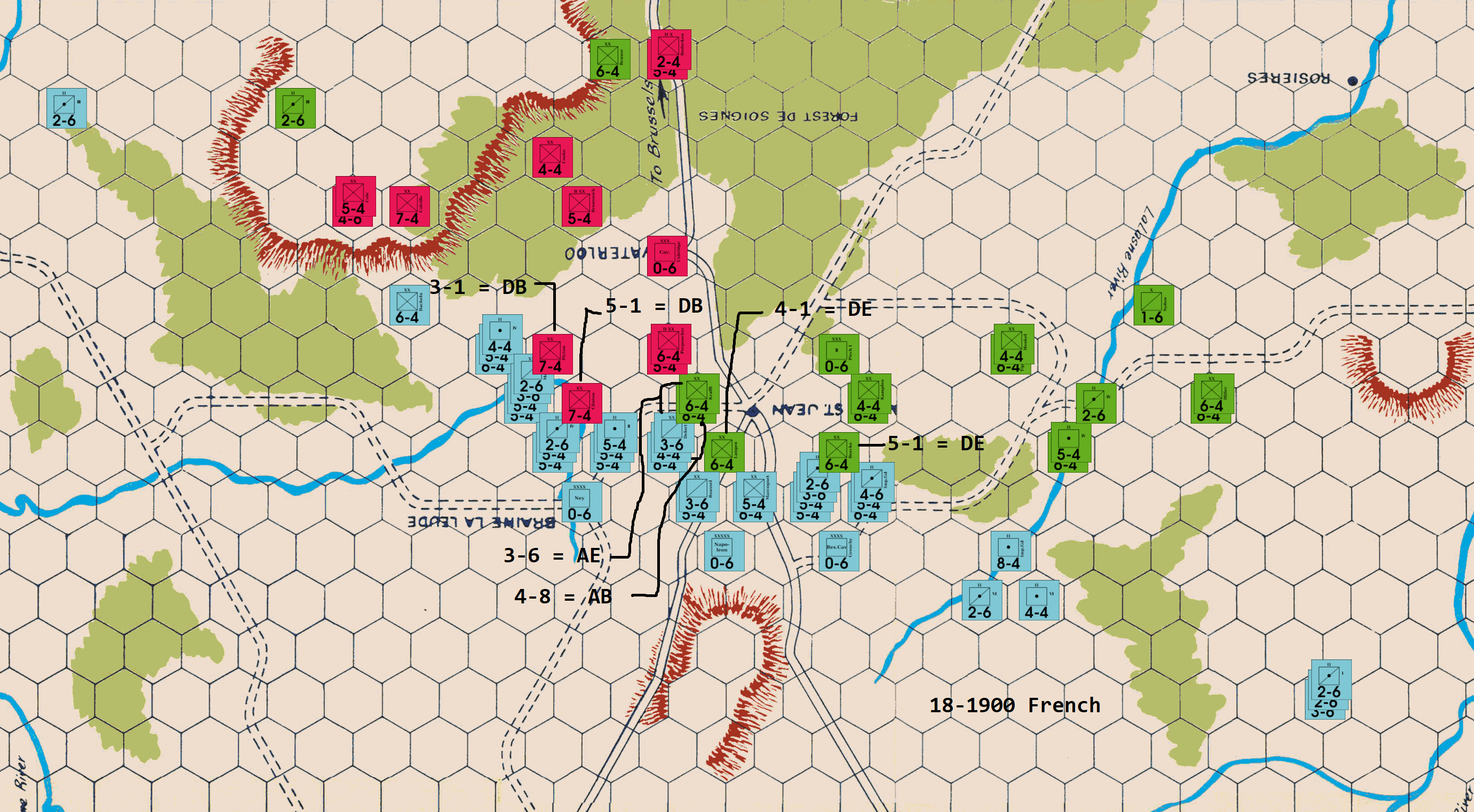
It is now, as Richard so aptly noted, really getting to be "nitty-gritty" time in our match. Needless-to-say, the cumulative "misfires" on my earlier low-odds and 5-1 attacks have definitely come back to haunt me, as the game moves into it's last few turns. That said, the combat results over the next three game turns will, even more than usual, probably determine whether Napoleon's campaign has a chance of success, or whether a French victory has been put out of reach.
So far as my last move of June 18th is concerned: I would have preferred to organize this turn's French combats somewhat differently, but Richard's spoiling attack against Pire has required a strong response, both to begin to open a path towards Waterloo, and also to screen the rear of any units that I may decide to use, on future turns, against the PAA defenders on the northwestern plateau. By the way, for those observers who might be wondering why I opted for a 3-1/5-1 combination against Picton and Clinton instead of two 4-1s, the reason is quite simple: exchanges against 7-4s are especially awkward for the French, and two 4-1s yields a 64% chance of avoiding an exchange, while the 3-1/5-1 combination yields a 70% chance of dodging that particular bullet.
In the center, L'Armee du Nord essentially attacks every Allied unit that it can reach. The French occupation of I41 is essential, as French possession of this hex, at the end of the combat phase is absolutely necessary, both to provide a retreat route for the units in I42, and also to split the front southwest of Mont. Ste.-Jean. Richard's decision to deploy both Steimetz and Kraft at H41 was – at least in my opinion – a mistake. If it were me, I would probably have settled on Steinmetz only; as things now stand, the French get two 1-2s against French units, instead of only one. If I weren't so far "behind the curve" when it comes to PAA casualties, I would have attacked both 6-4s at 3-1, rather than at 4-1 and 5-1. Unfortunately, the Prussians still have a lot of 6-4s available, and I need to preserve as many French 6-4s as possible for later 1-1s and 2-1s.
On the right, I really agonized over whether or not to gamble on a pair of 1-1s versus the Prussian stack at I34. Unfortunately, I just did not have the combat power necessary both to make those attacks, and to back them up with reserves, if either of them were actually successful.
Finally, a word about the French cavalry: had Richard not attacked my Samme position this turn, then I had planned to send a couple of 2-6 cavalry units northwest to reinforce the III Corps Hrs. Arty. Alas, the unexpected battles on the Samme required virtually every local unit that I could lay my hands on. In the east, the Prussian threat has obliged me to pull Guyot and company back a couple of hexes. Hopefully, after this turn, I will finally be in a position to dispatch more cavalry to reinforce this small seven-factor contingent of horsemen.
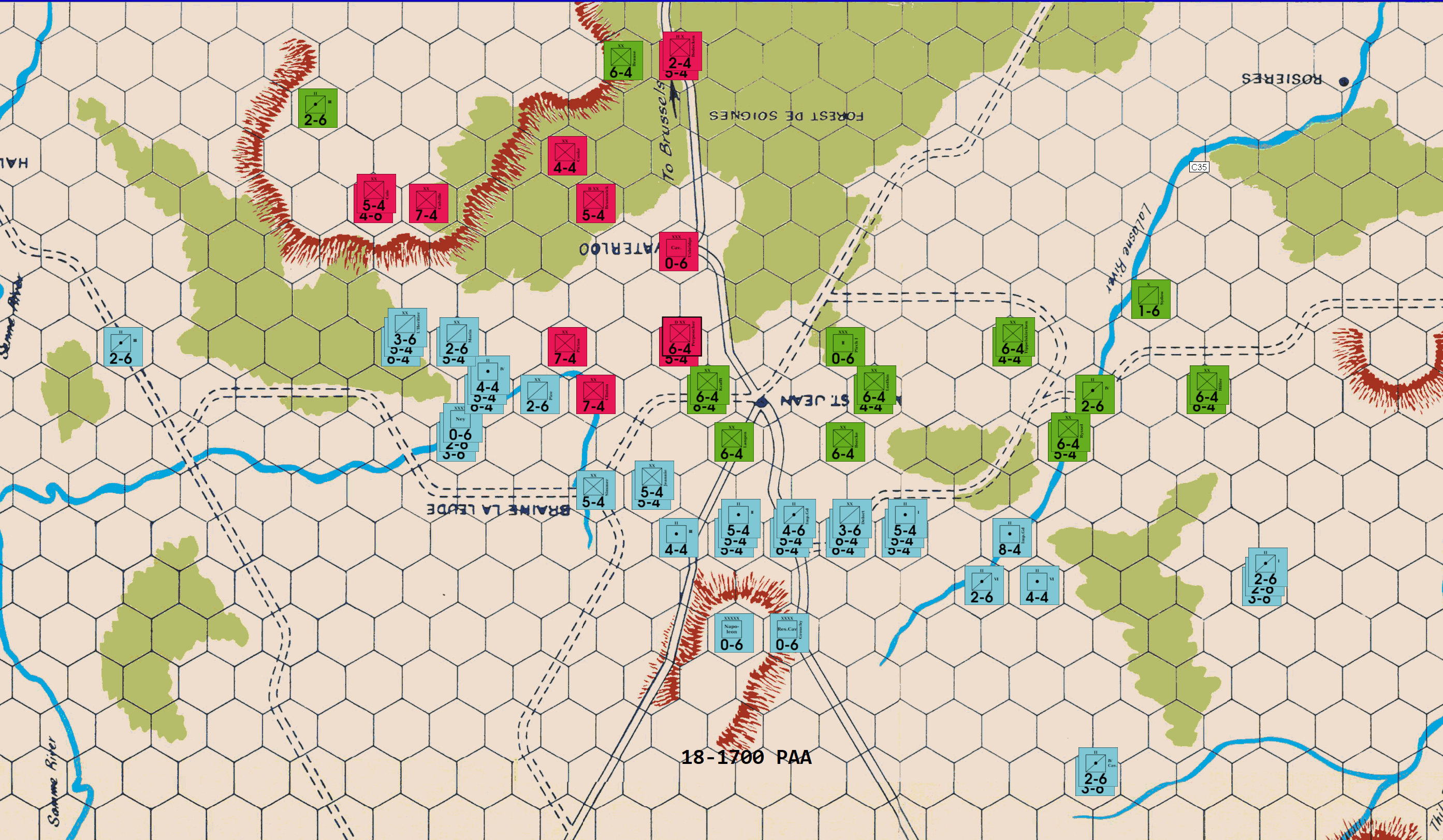
The PAA has to start fighting at least a little bit. Running out of units as fast as the French are running out of time. The French may need to pick a risk to take soon, before the clock runs out though.
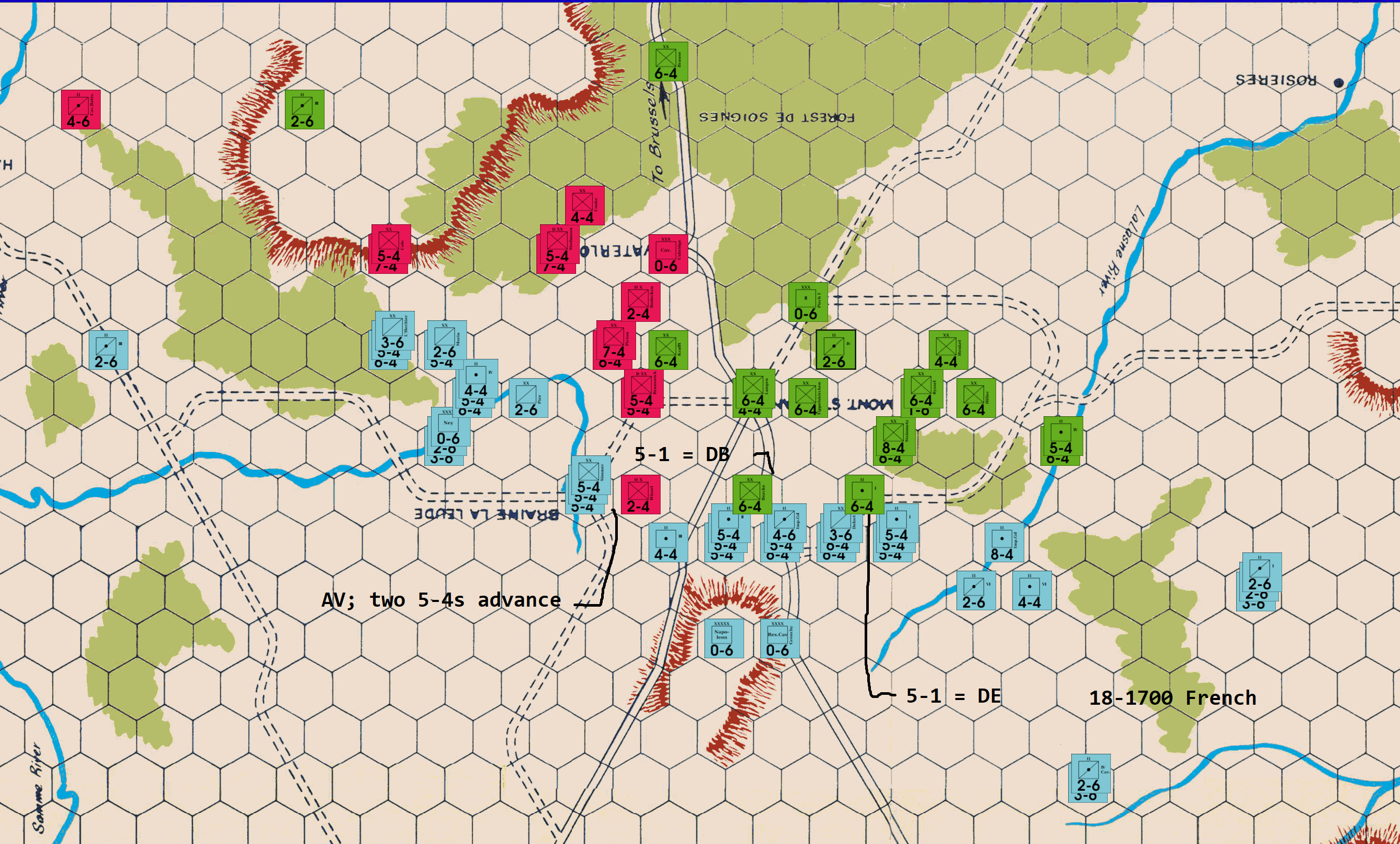
It has become increasingly apparent, in the course of the last couple of game turns that, given the current French and Allied unit tallies and the two sides' respective battlefield dispositions, it will be arithmetically impossible for the French player to win in the time remaining – either by opening up access to one of the Brussels roads exit hexes, or by eliminating all of the Allied units on the map – if all Napoleon's troops manage to do is eliminate three or fewer PAA blockers per turn for the remainder of the game. This, of course, is the logical underpinning for Richard's Allied "delay to victory" strategy in our present tournament match. Not surprisingly, the obvious (and only effective) French response to such an Allied defensive approach is for L'Armee du Nord to eliminate enough PAA combat units to make this Allied strategy unworkable. Unfortunately, eliminating more than the expected compliment of three PAA delay units per turn – most likely via the use of low-odds attacks – is both a challenging and a highly unpredictable project at the best of times, but it is especially so in a game like this one, in which the French army currently enjoys only a modest advantage in combat power. That said, with only nine turns remaining in this game, finding and executing an offensive approach that actually has a reasonable chance of overcoming this Allied "delay to victory" strategy has now become the central challenge facing Napoleon, as the action rapidly moves towards and into the last day of the campaign.
Speaking more generally, when confronted by the battlefield "time-distance" problem posed in this particular match, it is fair to say that individual players will each have their own preferred way of dealing with this type of game situation. Some French commanders will adopt what I call the "Bruno Sinigaglio" approach, and assault virtually every PAA unit within reach that can be attacked at 1-2, or better odds. Other players, when confronted with the "delay to victory" defense, will patiently chip away at Allied combat units through the first few turns of the 19th, and then attempt to swamp the PAA line with massed low-odds attacks during the last three or four turns of the game. For my own part, I prefer a somewhat different "phased" French approach on those rare occasions when I encounter the "delay to victory" Allied strategy. I won't claim that mine is necessarily the best method of tackling this problem, but I will say that I have faced this PAA "rope-a-dope" defense twice in the last two years, and I that was able to (barely) eke out a French victory in both cases.
In simplest terms, as the French commander, I really try to tackle the "delay to victory" strategy in three phases. During the first phase – which usually comes into play early on the morning of the 18th – I largely eschew low-odds attacks and, instead, concentrate on high-odds combats that I hope will gradually increase the French army's advantage in both combat power and in unit count, while also driving the Allies back towards Mont. Ste.-Jean. The second phase goes into effect – typically on last turn or two of the 18th – once the PAA battle line has been driven far enough north that the Allied front breaks at the center. The goal of French operations during this phase – besides continuing to eliminate PAA units, of course – is to force the Allied commander to divide his units between four separate fronts: the northwestern plateau; the main Brussels road; the expanse of open ground between the La Lasne River to the east, and the northern forested terrain in the center; and the west bank of the La Lasne River. If the PAA commander is going to counterattack the French advance, it will probably be at this stage in the game, and it will usually be either to postpone the breaking of the Allied front in the center, or to stall a French push through the eastern forest hexes between Mont. Ste.-Jean and the southern stretch of the Las Lasne River. The third and final phase of the French offensive will be directed at pressuring (or at least pinning) PAA units in all four sectors of the battle space, but with special emphasis on applying concentric pressure against the Allied units defending the eastern Brussels road. It is during this phase of the offensive that low-odds French attacks will really become a crucial part of Napoleon's endgame strategy.
So far as this match is concerned, everything really depends on what the PAA commander does over the next few turns. If he does not counterattack in the center, then French operations will pretty much continue to follow the course outlined above. To that end, Ney's Left Wing has established itself across the eastern Samme so that it can threaten both the northwestern plateau and the main Brussels road; at the same time, the major part of the French army has been positioned both to fight in the center and to begin pushing through the forest terrain bordering the southern La Lasne River; and finally, the first of several cavalry detachments has just been dispatched to threaten the river crossings in the northeast. Now, all I can do is wait to see what Richard chooses to do.
The PAA has to start fighting at least a little bit. Running out of units as fast as the French are running out of time. The French may need to pick a risk to take soon, before the clock runs out though.
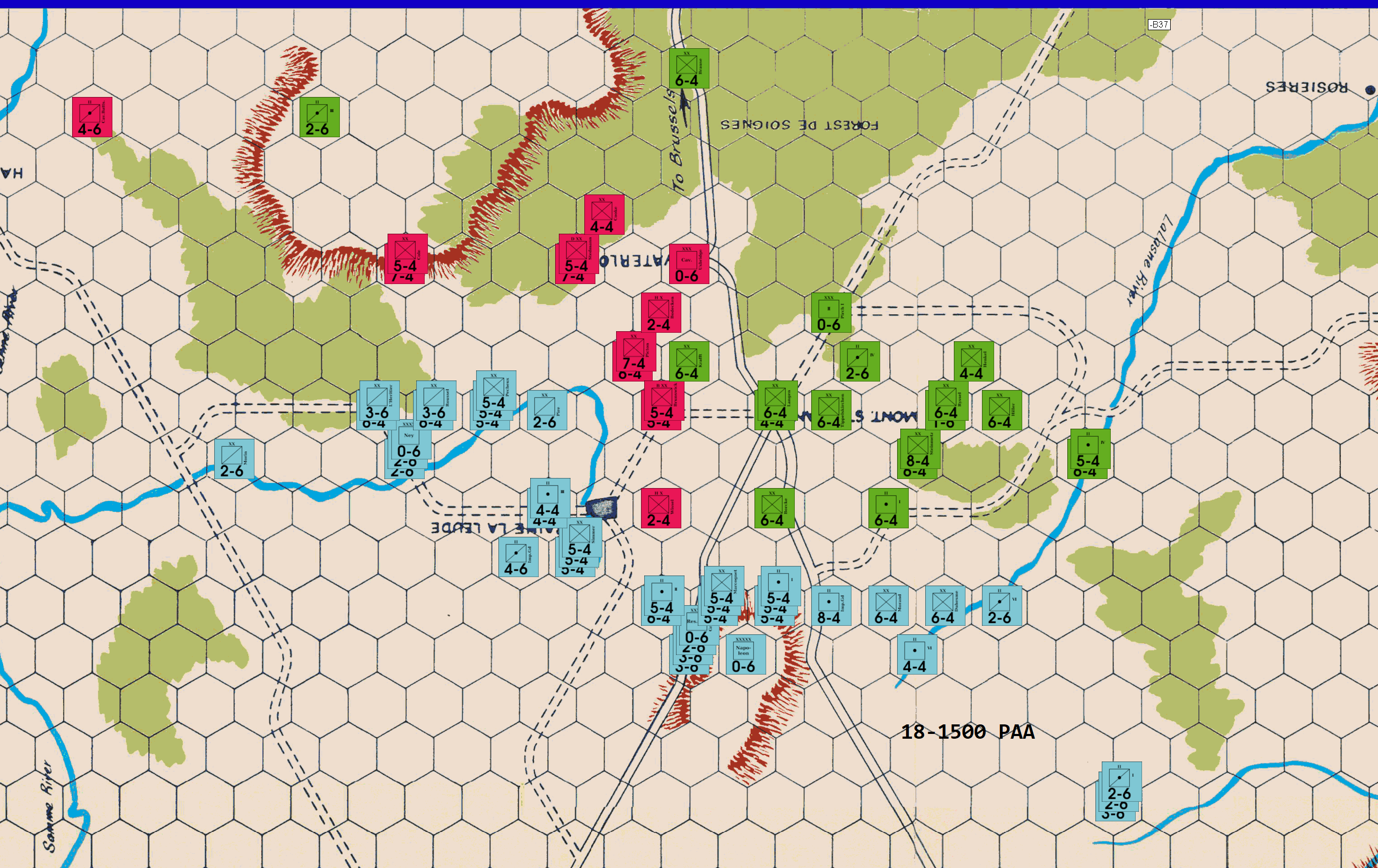
This is definitely the first time in probably 80+ games I've ever been fighting near the hill in the N/NW sector of the map. The French have lots of options this turn if they are willing to roll some dice! I wouldn't want to deprive you of some late game excitement if you are so inclined. No attacks this turn, over to you for 1700 18th.
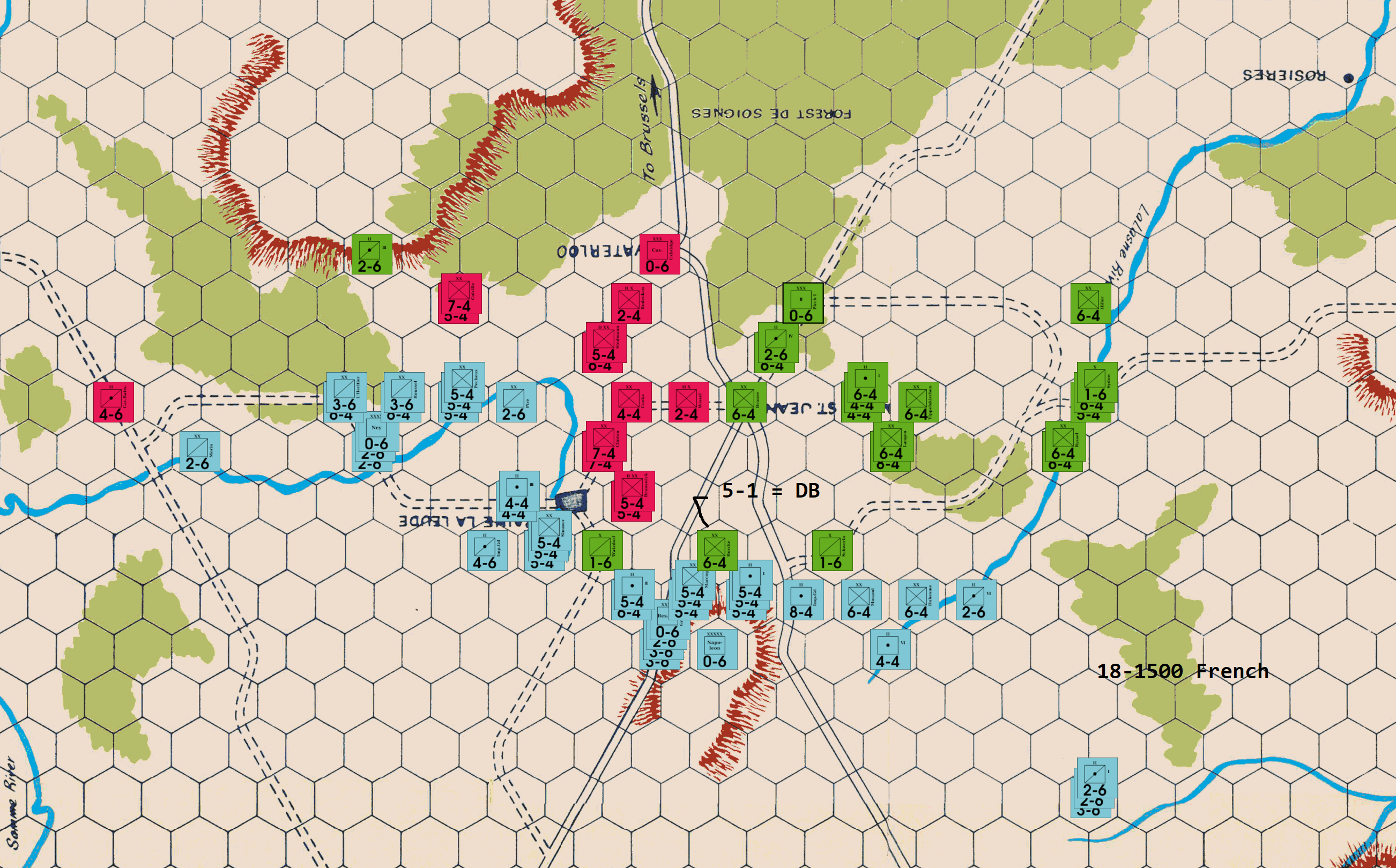
If it were a little later in the game, then I would have gambled with a few low-odds attacks against the British guarding the Samme near Braine La Leude. However, I still have a couple of turns left on the 18th, so I will restrain myself for a bit longer. Of course, now that I see the disappointing outcome of the French attack against Borcke, maybe restraint was the wrong call.
So far as the game goes: I personally would have garrisoned G45 with a British 7-4 just to keep the French off of the river – barring a low-odds attack, of course – for another game turn. I understand why Richard avoided the hex: the forest behind the river makes this very dangerous ground for a defender; nonetheless, I think that the hex should have been defended. As it is, the failure of the PAA player to defend this section of the Samme has allowed Ney to position a substantial force astride the river and, although Pire is virtually certain to be eliminated, the French contingent in this sector should oblige Richard to retreat Colville and Cole back onto the ridge line to the west. The other good news for the French is that Cav. Batts has been dispatched west to screen the river and then the heights. Tis effectively puts this unit out of the fight for quite awhile.
Farther to the east, the battles in the center were, obviously, a bit disappointing; on the other hand, I actually expected the Allied player to switch gears and begin using only his "heavy" infantry to delay on his turn. The fact that he didn't, did allow the French to destroy two more Prussian 1-6s, so that's something, I suppose.
Looking forward, I expect to see divisions defending in the center from now on. Richard could, of course, always counterattack, but I think having used up almost all of his soak-off units, that such a course of action has more risk than benefit for the Allies, at this point in the game.
Time to circle the wagons. Some interesting terrain in this part of the board that I don't usually interact with. We will see what happens. No attacks.
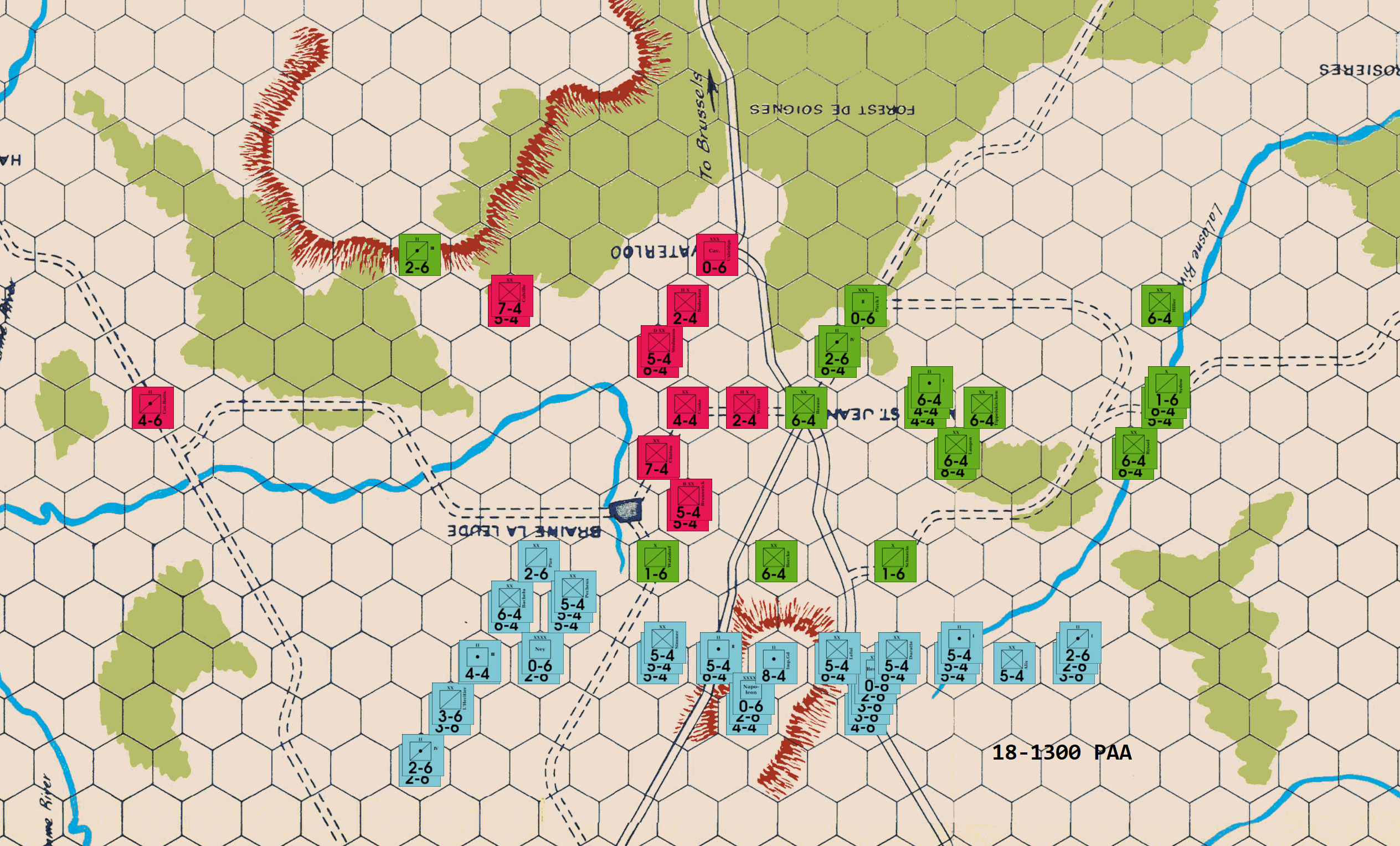
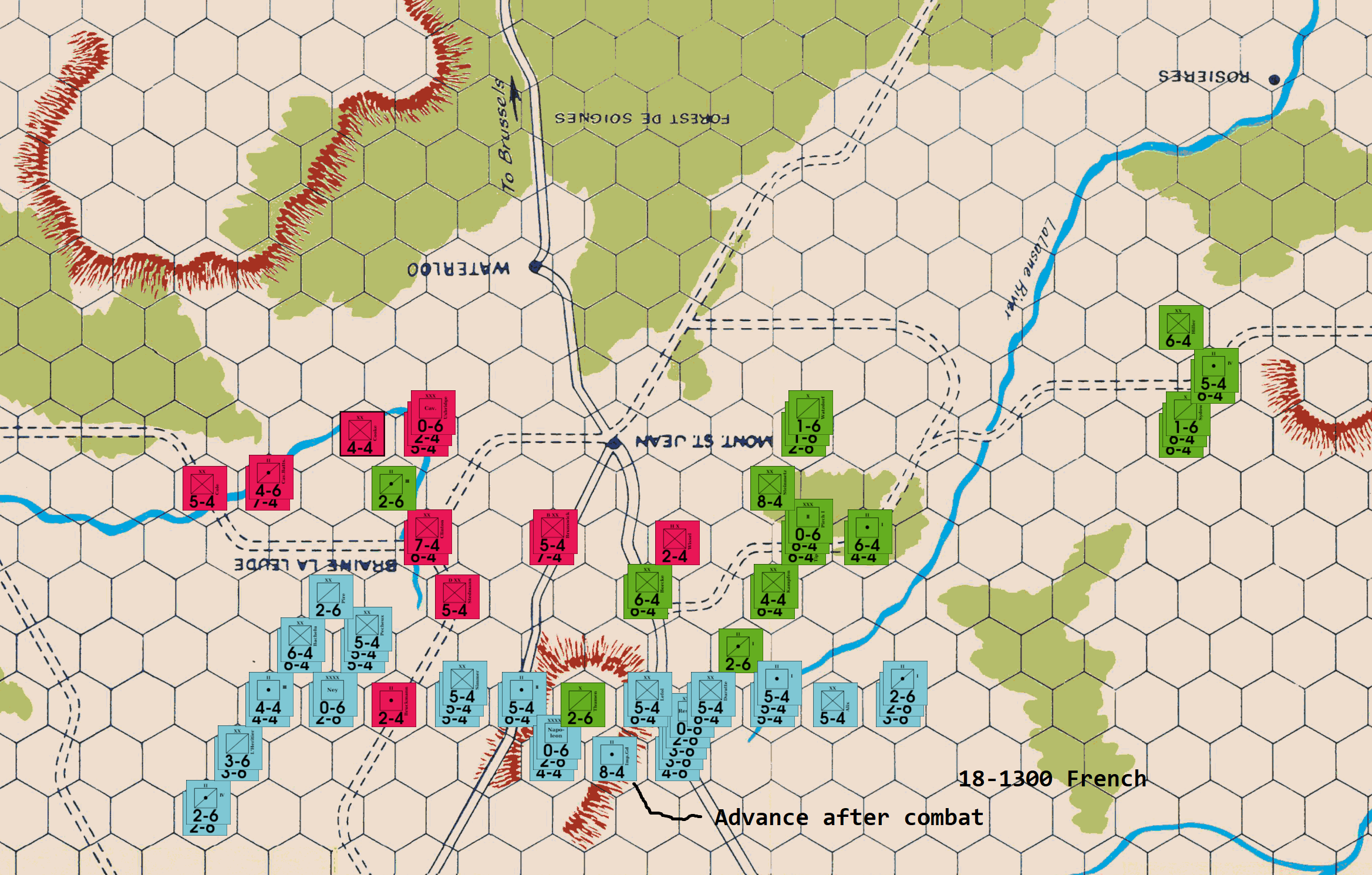
As I expected, Richard has again elected to avoid any major combat and has, instead, chosen to delay this turn's French advance with yet more sacrificial blockers. As a consequence, the surviving infantry of both the Anglo-Allied and the Prussian armies continue to remain virtually out of reach, so, since Napoleon can do little else, he contents himself with eliminating three more Allied units, and with occupying the central hilltop at M38. At the risk of stating the obvious, there are no only ten game turns remaining and the Brussels Roads exit hexes are still a long way off. That said, the French army will still enjoy a substantial advantage both in units (thirty-six to twenty-five) and combat power (150 factors to 117) on the 1500 game turn, but that edge will diminish significantly when the remainder of the Prussian IVth Corps finally arrives in the battle area.
So far as this French move is concerned: L'Armee du Nord presses ahead where it can, against the Allied right. No matter what either of us does over the next few game turns, French progress in the center is going to be painfully slow. Hence, if Napoleon is going to dislocate the Allied defense during the next few turns, it will initially have to be in the west around Braine La Leude and points north. There is still a decent amount of game left, but time is definitely running out for Napoleon.
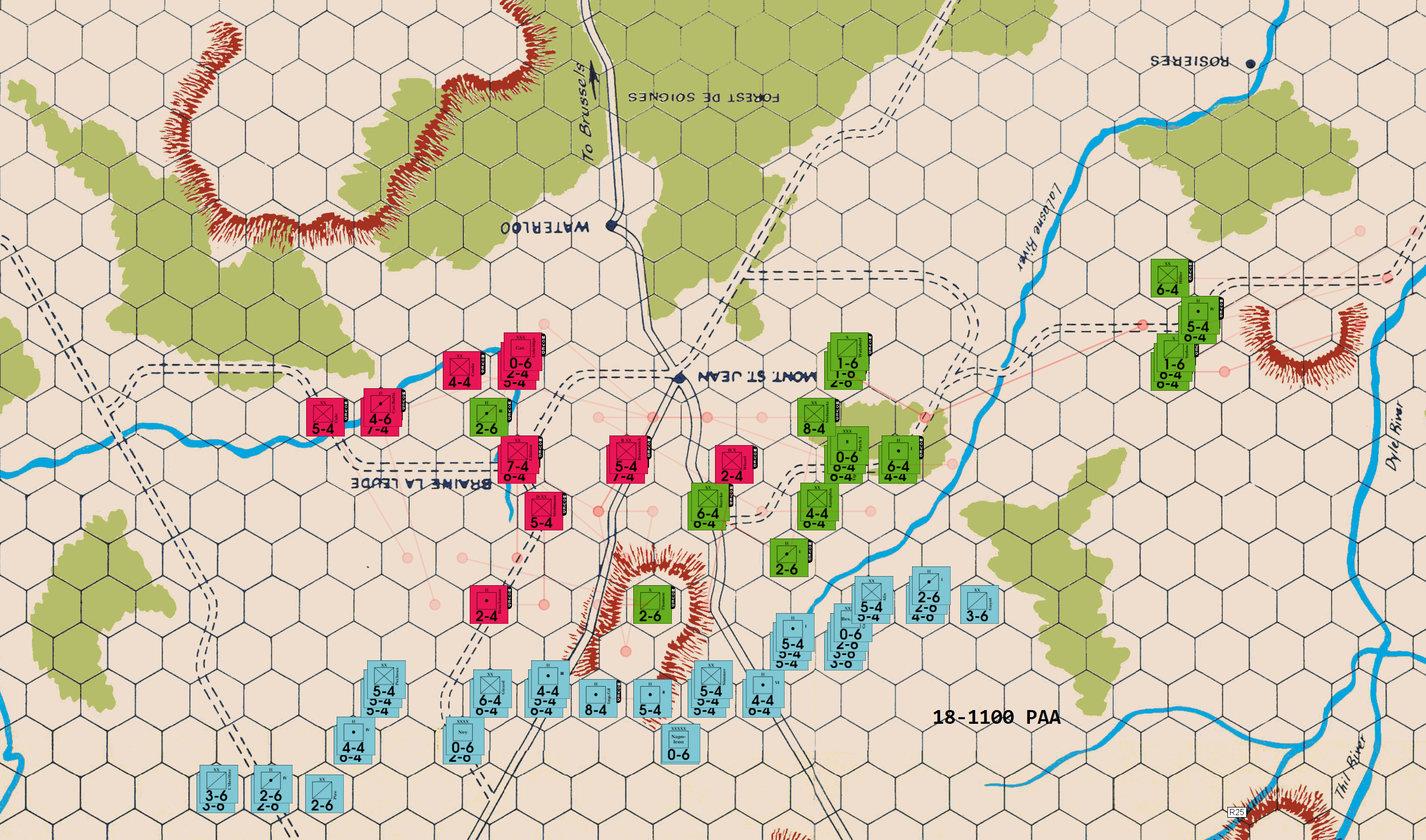
Onto the afternoon of day 3. The French wave washes north. The IV Corps has almost arrived, no more reinforcements. No attacks this turn. The grand battery is setting up on the hill just south of Mont St Jean. I think the mud has dried out finally.
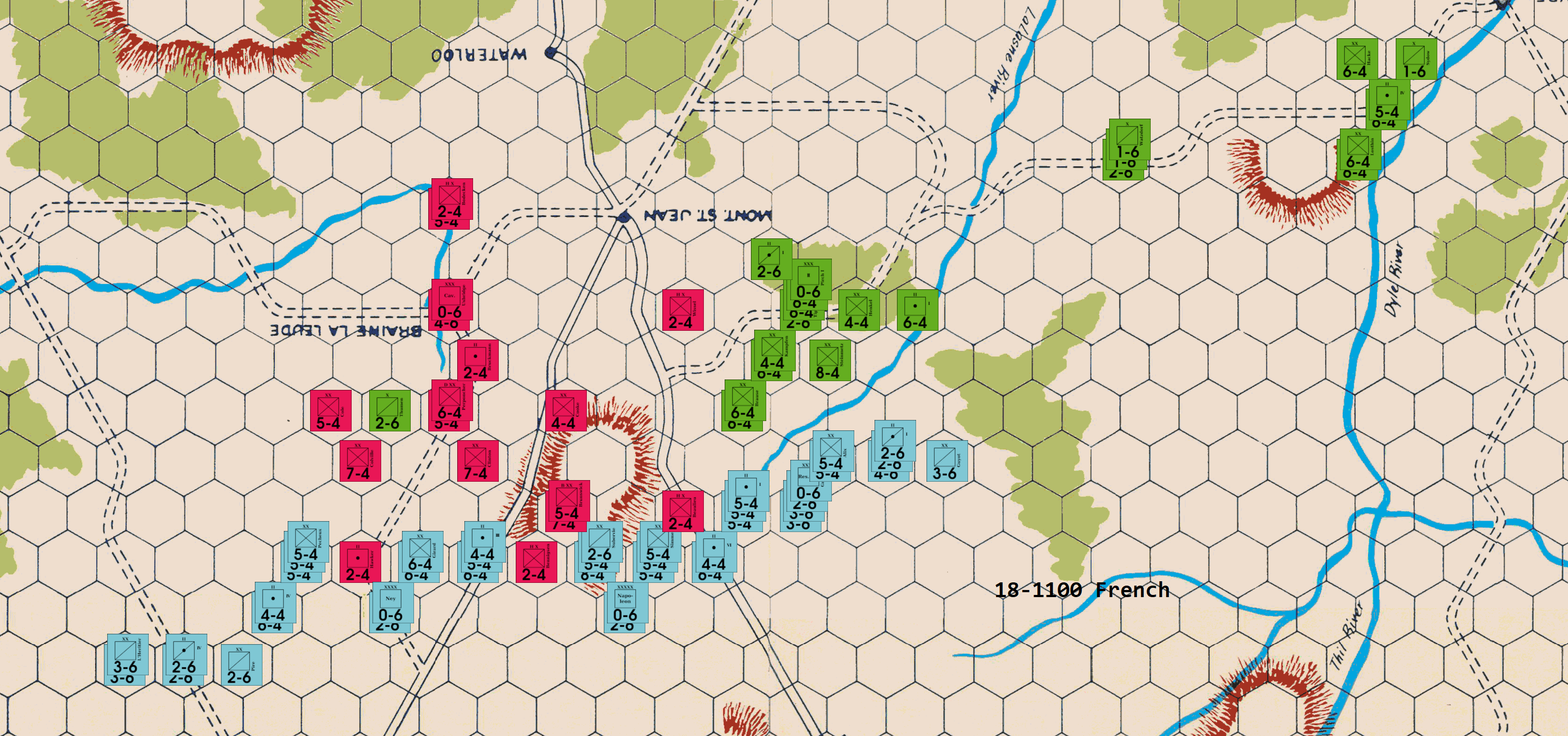
The general outline of the PAA player's endgame plan has now become clear: delay on the right and in the center with Wellington's army and then, once the Prussian IVth Corps arrives on the Allied left, to fight with the now-reinforced Prussians to deny the French possession of Mont. Ste.-Jean which would both threaten the roads to Brussels, and would also split the Allied front. In addition, the Prussians are virtually guaranteed to fight in order to prevent Napoleon from widening the front by pushing east along the banks of the La Lasne River, a battlefield development which would create a potential French threat against the eastern Brussels road. The other reason that I think that my opponent will probably delay for another turn or two is that the arrival of the IVth Corps cavalry, on the 1300 game turn, will allow the Allied player to form two Prussian stacks of fifteen factors: something that he has not been able to do for much of the game. Of course, since I am facing Richard, I could be wrong, but until I see something to change my mind, I will plan accordingly.
So far as this move is concerned: the French really don't have that many attractive options other than the elimination of the three PAA blockers. The majority of the Anglo-Allied army is out of reach, except for the stack in N38. And a low-odds attack against this position is distinctly unappealing; on the other hand, a soak-off attack denies Wellington occupation of N38 next turn unless, of course, he is willing to fight for it, so that is what I have done. The only other French offensive option is a low-odds attack against Steinmetz: such an attack is certainly possible, but – even if I were to decide to chance such an attack – I personally prefer to clear the Prussian infantry out of L36 first.
Looking ahead, I expect one more turn of Allied delay, and then with the IVth Corps infantry only one march away from the front, I expect things to heat up considerably, especially on Napoleon's right.
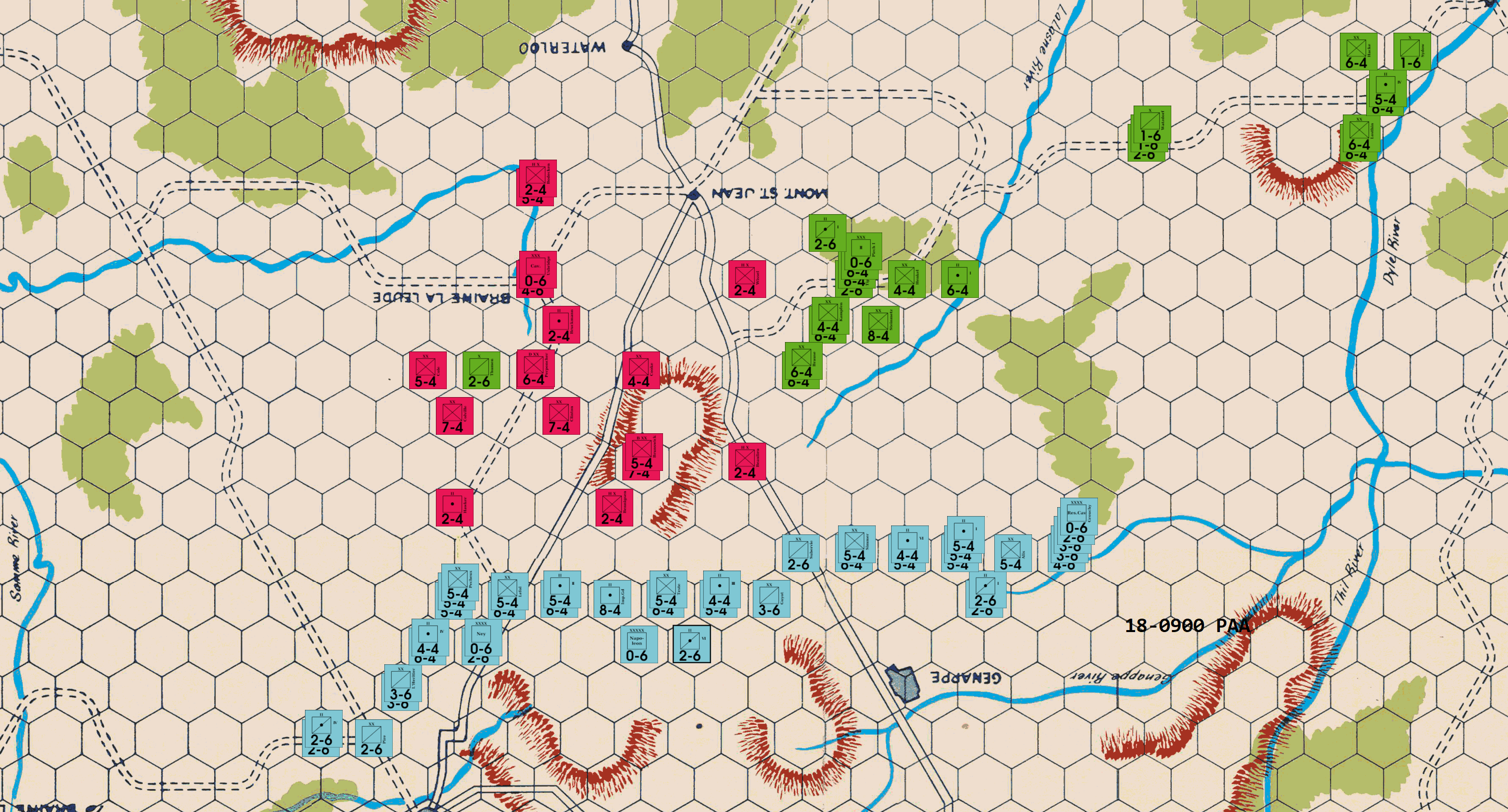
All of these Belgian troops were so eager to see some combat so Allied command is happy to oblige. No attacks this turn. It might be time to circle the wagons soon.
It will be close, and perhaps I am being too optimistic, but I believe the French will have to take some chances soon before the PAA is able to run out the clock. Of course Joe is right to be patient I believe, because each loss of 3-4 delay units makes a counterattack against exposed units from a A back 2 more difficult. The French have several tools in their toolbox to deal with full delay tactics by the PAA. Which one will Emperor Joe pull out to use over the next few turns? The clock is ticking.
PAA HQ
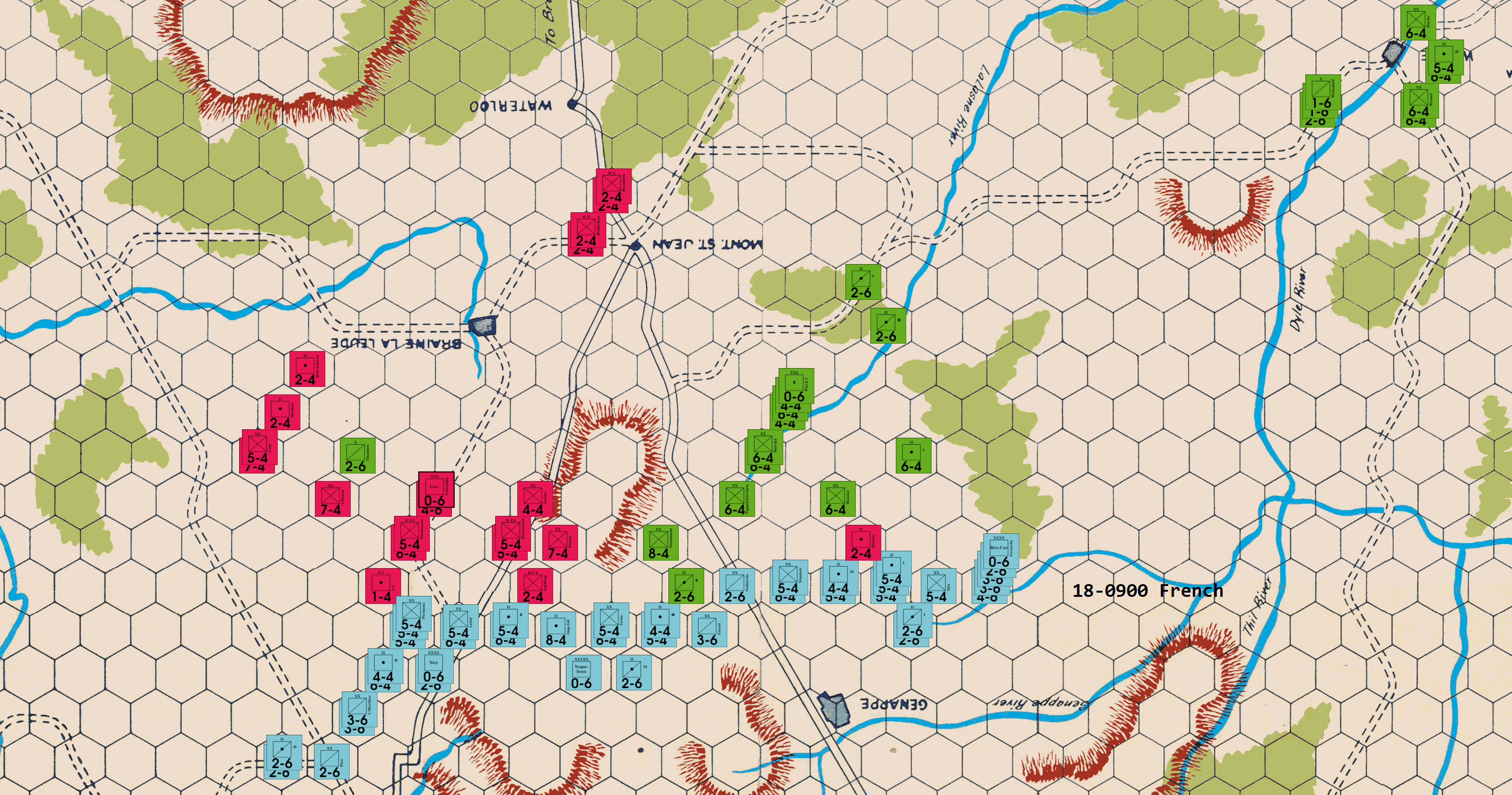
Although I was a little puzzled by my opponent's use of four delay units to cover last turn's Allied retreat from the Nivelles-Genappe Line, I decided that this unexpected PAA profligacy probably derived as much from the lucky survival of Treskow as it did from Richard's desire to hold the French army as far south as possible, at least for a turn. Now, having seen the PAA commander again sacrifice four unts to delay Napoleon's advance this turn, I'm not so sure. Ordinarily, if the Allied player intends to slug it out with the French at Mont. Ste.-Jean, then he will pull back so that his flanks are covered by the eastern branch of the Samme in the west, and the western end of the La Lasne River in the east; this way, he can concentrate the bulk of his combat power in a relatively constricted area in the center where a French army that is both more numerous in terms of units, and more powerful in terms of raw combat power, will – because of stacking limitations – have little, if any, battlefield advantage. Choosing to form for battle in the clear terrain south of the aforementioned defensive positions, on the other hand, either requires the PAA player to use up a lot of sacrificial blockers, or, alternatively, to expose the Allied line to numerous high-odds attacks by the French. That said, when I encounter this line of PAA play in the early stages of a WATERLOO endgame, I usually conclude that, for whatever reason, my opponent has decided to adopt a "delay to victory" strategy, rather than go for a decisive battlefield win over L'Armee du Nord. As things currently stand, Richard could still elect to pursue a "fight the French to the bitter end" strategy, but – one way or the other – the next Allied move should pretty much "tell the tale."
Looking forward, the French army currently outnumbers the combined Anglo-Allied/Prussian force in the immediate Mont. Ste.-Jean battle area by some nine units and twenty-seven combat factors. The arrival of the units of the Prussian IVth Corps will, of course, change that combat equation, but for the time being, the French army has a clear battlefield advantage where it counts most. So, at least for the time being, the "ball is in the Allied player's court," and all Napoleon can do is wait to see what he does, and then react to the next PAA move with as much French offensive elan as is possible.
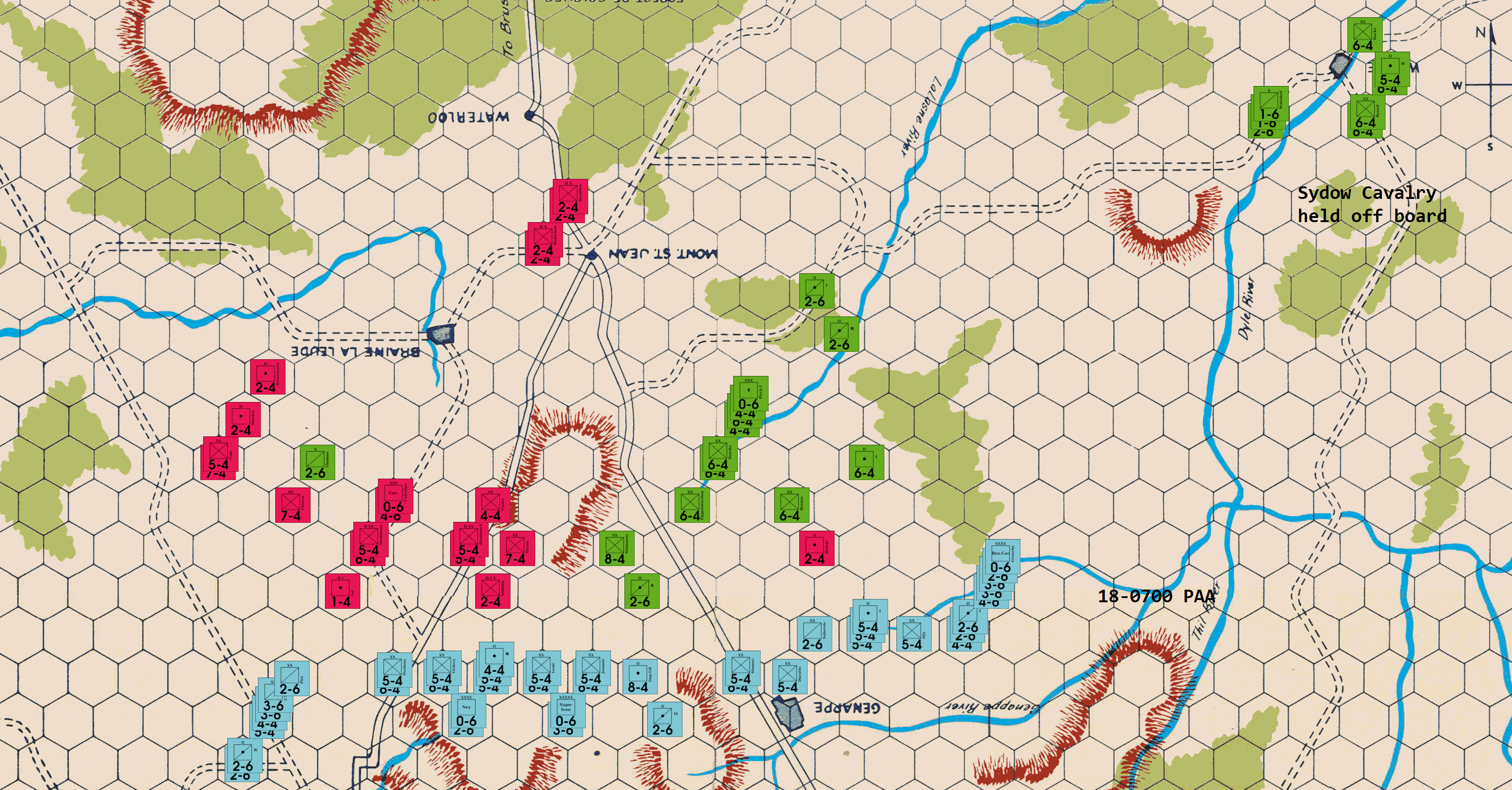
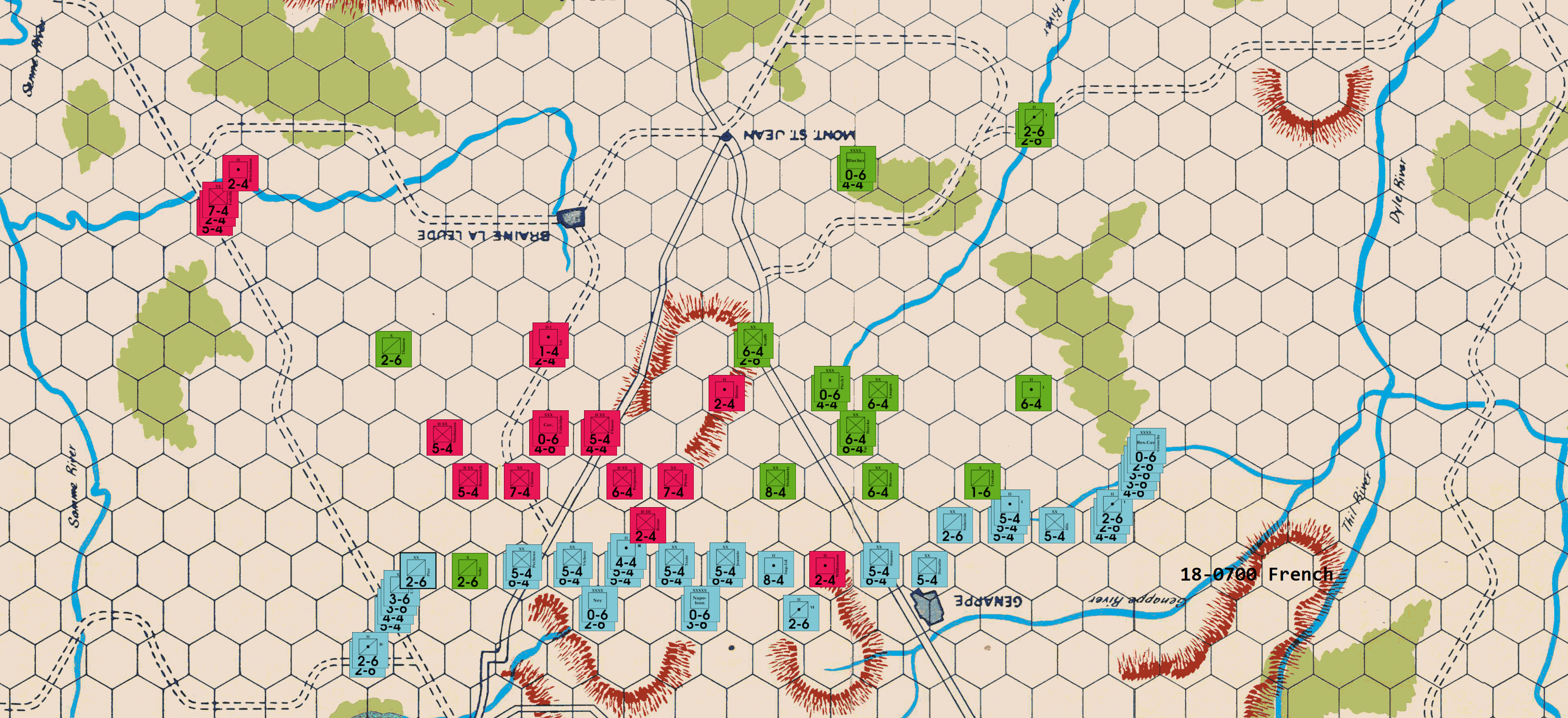
This turn of Allied retreat and French pursuit pretty much marks the end of the middle game phase of this match; next comes the endgame fight for Mont. Ste.-Jean and the Brussels Roads to the north. Moreover, in the case of the critical endgame battles, Napoleon is going to find himself in a race against time to destroy enough PAA combat power to negate (or at least to neutralize) the effect of the soon-to-be arriving Allied reinforcements. Of course, where the powerful Prussian IVth Corps enters the map will directly influence the flow of the game. Richard could elect to bring the IVth Corps in on the Quatre Bras east-west primary road, but I have found that such a move usually leads to disappointment for the Allied playe,r unless the French army is either still stuck south of the Nivelles-Genappe Line, or is already teetering on the verge of collapse. That said, I expect the PAA commander to play it safe and bring this powerful Prussian contingent in at Wavre.
The French Left: Ney's force will initially face the cream of Wellington's army for the next few game turns, and this fact argues for circumspection, as the "Iron Duke's" force contains a stable of powerful infantry divisions, as well as three local soak-off candidates, and all of these units could well be used to support an attack against part of the French battle line, even before the arrival of additional Anglo-Allied reinforcements. In the short term, Ney's goal will be to push Wellington's forces back behind the eastern branch of the Samme River so that his French Heavy Cavalry can gain freedom of maneuver, while his infantry threatens the Allied Right west of Braine la Leude. Ultimately, of course, like the rest of L'Armee du Nord, Ney's force will be aimed at clearing a path to the Brussels Road.
The French Center: This force will be obliged to do most of the early fighting. As the front moves north, additional units should become available from Grouchy's detachement on the French right but – at least in the early going – Napoleon's units in the center will be the force that powers the French offensive. Needless-to-say, the early combat results (for both the French and the PAA) of the battles in the center, will go a long way towards shaping the trajectory of the game during the last two days of the campaign.
The French Right: Once the Allies abandon the Genappe Line, Grouchy's force will advance towards the western end of the La Lasne River while, at the same time, it also continues to maintain some sort of cavalry threat against the La Lasne River crossings farther to the east. Of course, as the fighting rages on in the center, it is more than likely that part of Grouchy's detachment will ultimately have to be fed into the center to replace Napoleon's losses. Nonetheless, this part of the front will probably remain something of a strategic "sideshow," at least until the Allies have been driven away from the river and ridge line in the center.
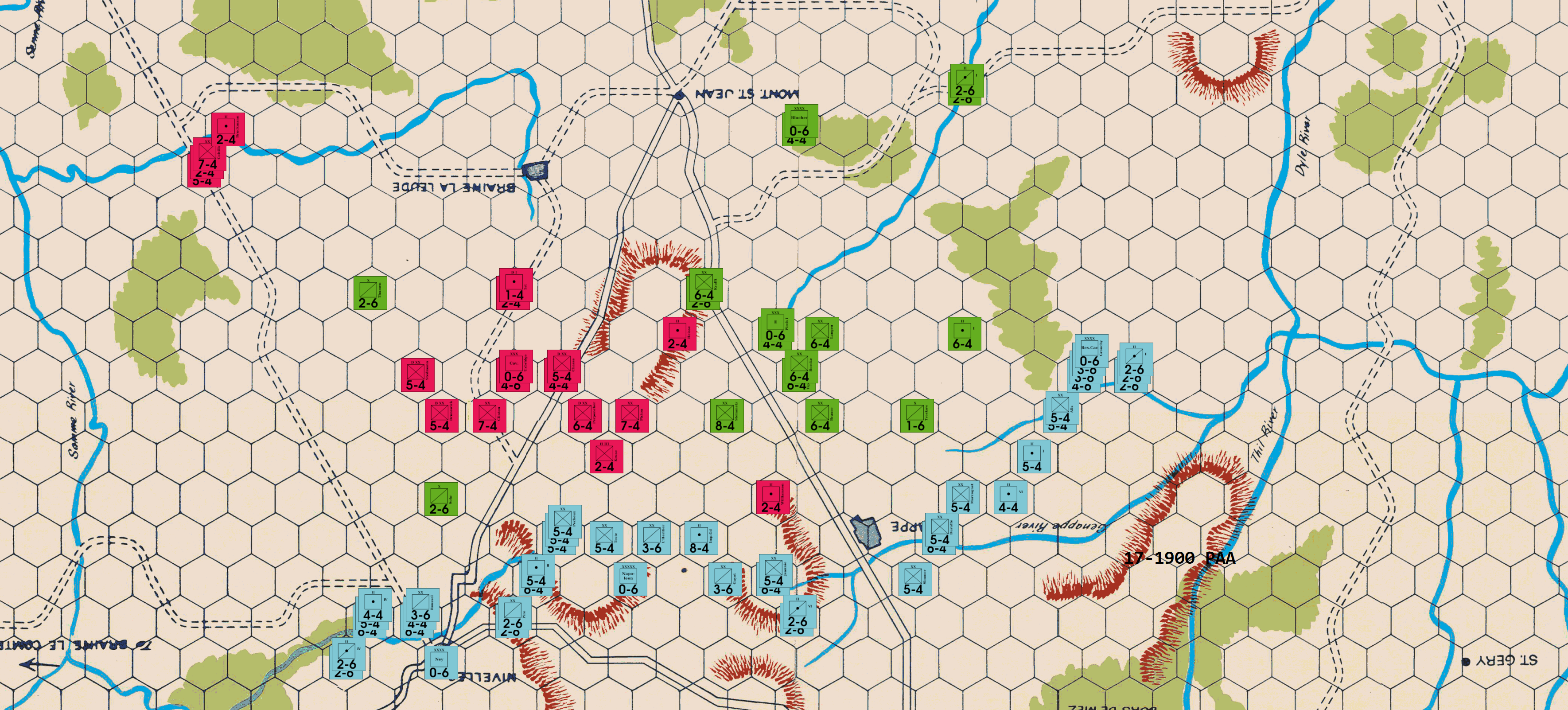
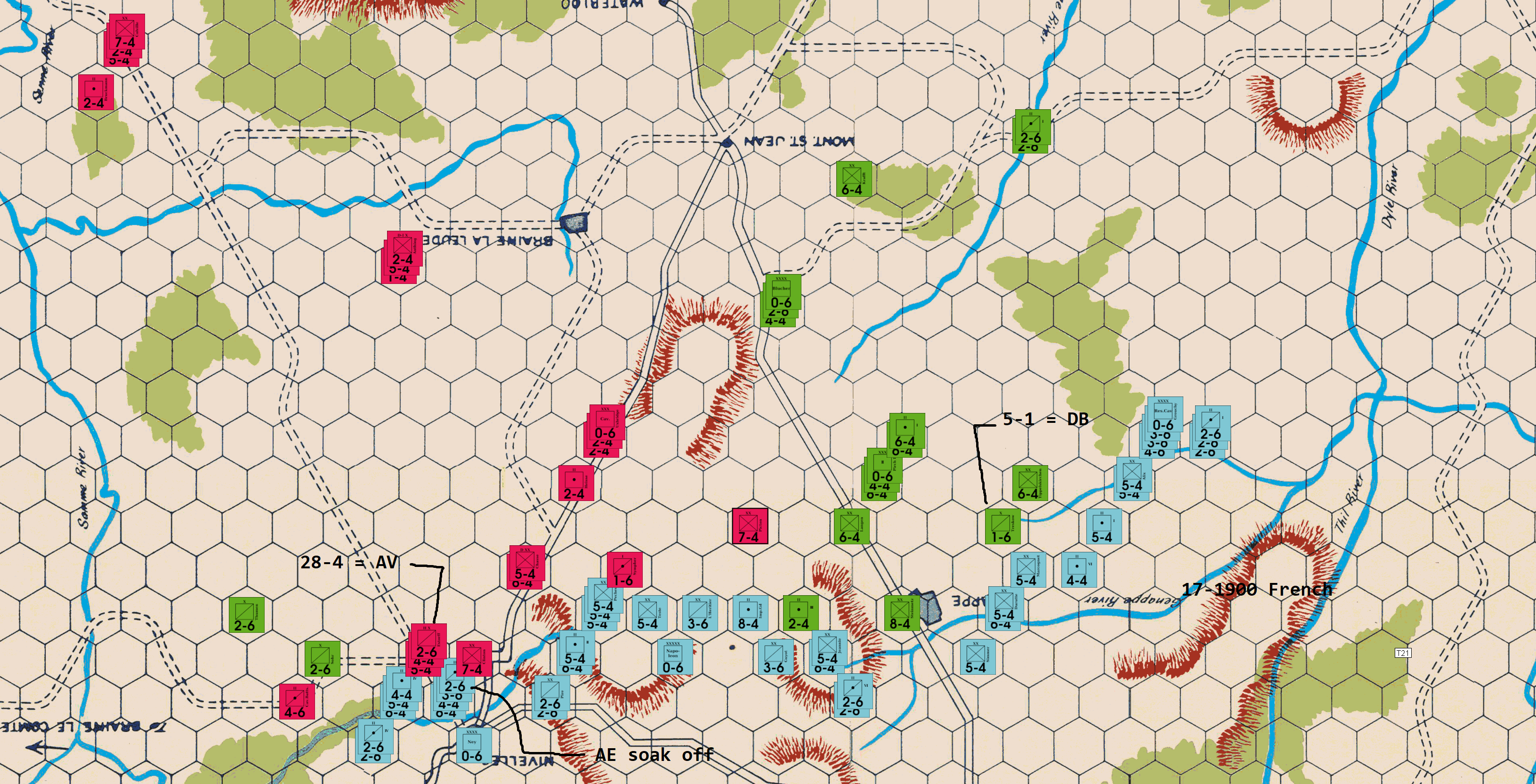
I confess that – although I actually thought that it would probably be a mistake on Richard's part – I fully expected a one or two round fight in the center. And to be honest, had I not rolled a D Elim versus Alten, then I think that we probably would have had just such a battle. As things have actually turned out, much to my surprise, it looks like the Allied commander has decided to retreat so as to conserve his strength for a major toe-to-toe slugging match at Mont. Ste.-Jean. And, if that's the case, then the French Army is in for a real slog, once it moves north towards the Brussels roads.
The Nivelles Front: In view of the French capture and occupation of T36, it is probably not unexpected that Richard has fortified T40. I suspect that he did this to, as much as possible, discourage Ney from launching a low-odds encircling attack against Clinton at T39. In this instance, however, by reinforcing T40, he has inadvertently weakened it: I say this because I almost certainly would not have made the attack against Clinton this turn – especially after having just dodged the doubled exchange against Alten at T36 last turn – as the risk/reward calculus, in my view, was simply too heavily weighted in favor of the PAA. On the other hand, trading 2-6s, and also ending the French player turn with stacks adjacent to T41, T40 and T39 simply seemed like too attractive an opportunity to pass up. Granted, Richard can always counterattack, but such a response will draw a fairly significant Anglo-Allied contingent away from Mont. Ste.-Jean, and it will also require the expenditure of soak-off units, of which, he currently has relatively few in the immediate battle area.
The Central Front: The French move in this sector virtually makes itself this turn. The only challenge for Napoleon is to not expose his advancing line to undue risk; and this is something that – in theory, at least – can presently be accomplished by advancing in a linear formation, so as to maximize the Allied player's soak-off costs should he attempt to attack some part of the French vanguard.
The Genappe Front: Had Richard not moved to reinforce the La Lasne Crossings this turn, and had last turn's French 1-2 against Clinton (at T39) not produced yet another A Elim, then I would have handled this front very differently. Unfortunately, the Allied player opted to decline combat in the center and, instead, send a few units rushing back to bolster his river defenses, so Grouchy was held back and ordered not to make a dash for the La Lasne River this turn; and, in addition, my usual French attack (from Q29, thereby allowing an advance) against a Prussian block at Q30, had to also be tabled, as Napoleon was in no mood to trade a French unit of any size (as a soak-off against Tippelskirchen), for a Prussian 1-6. And finally, of course, Grouchy still lurks at O28 and O27 with a portion of the French Cavalry Reserve, should the Allied commander not continue with his plans to reinforce the PAA river defenses in the northeast.
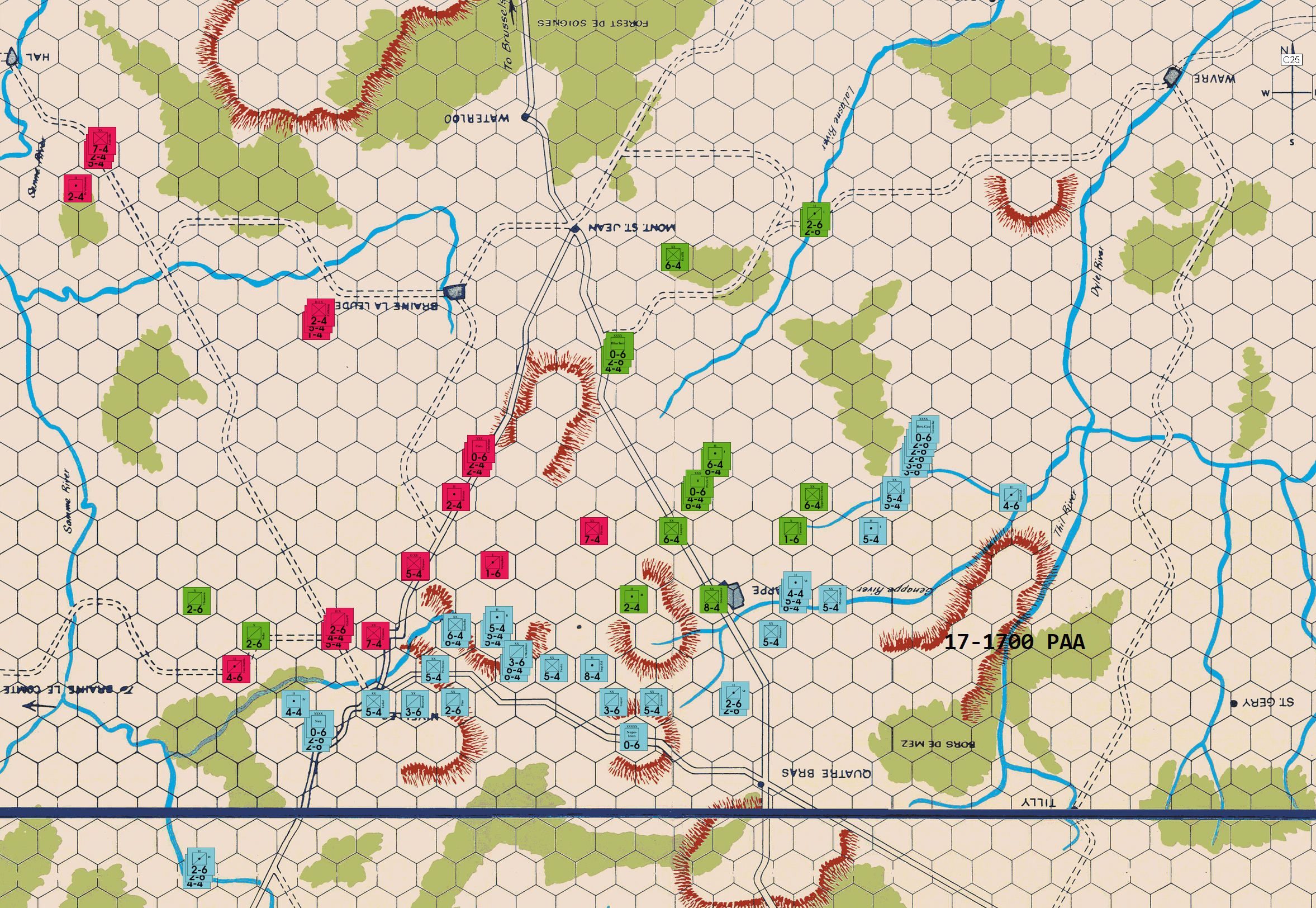
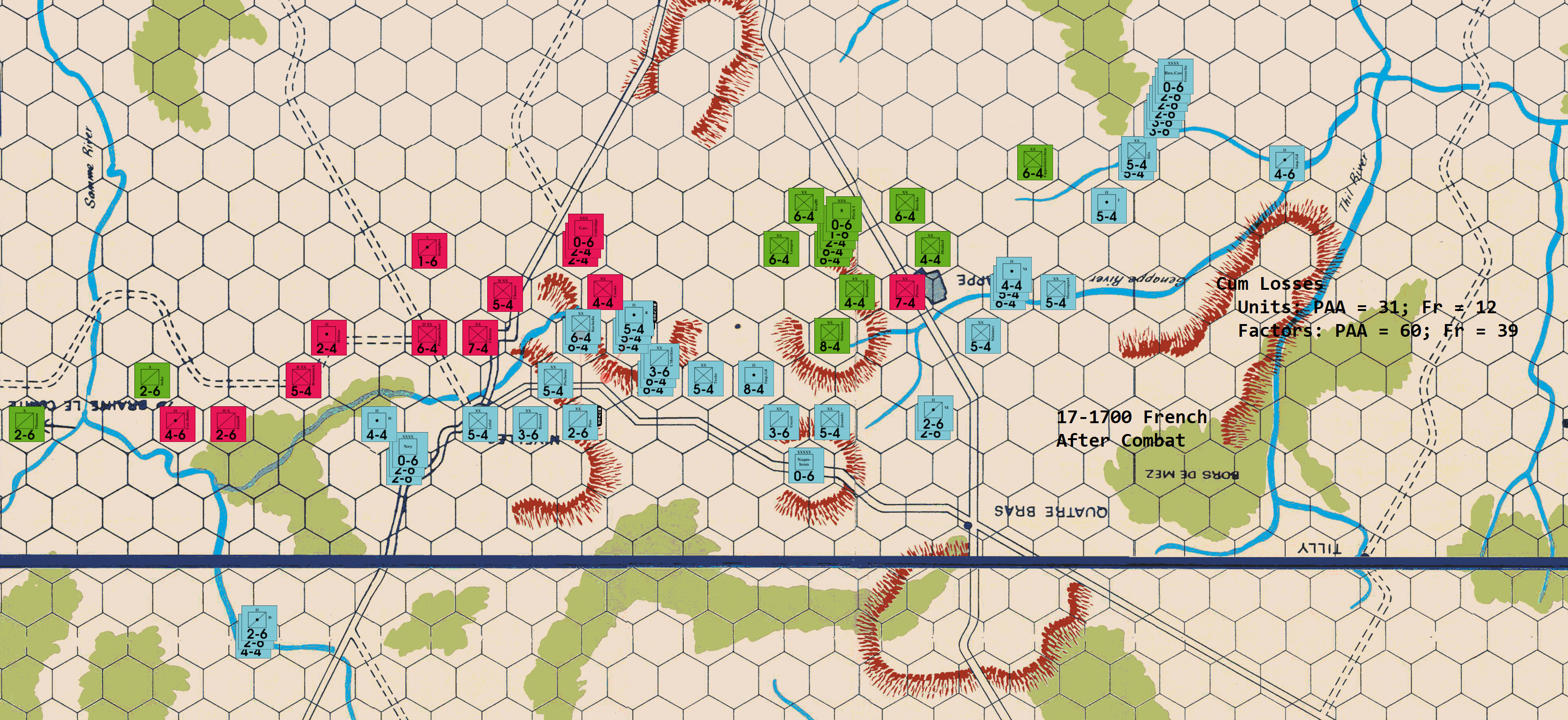
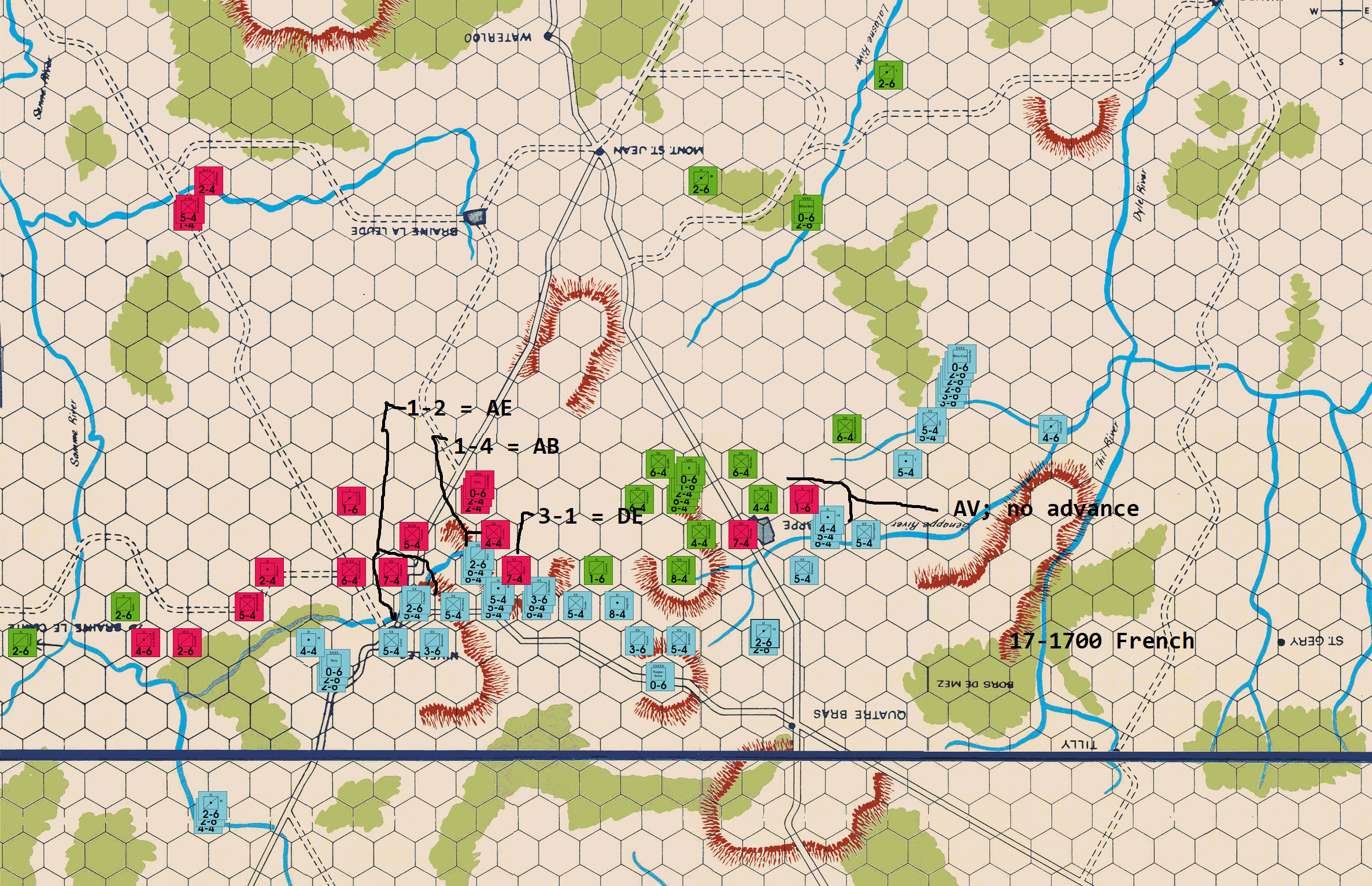
The time for middle game maneuver is pretty much over: the Allies have taken shelter in the Nivelles-Genappe Line, and the French army now has no choice but to try to pry them out of their doubling terrain and into the open. And to add to Napoleon's woes, a torrent of Allied reinforcements has begun streaming onto the map, and this means that L'Armee du Nord – unless it can inflict substantial damage on the PAA forces over the next few game turns – will find itself badly outnumbered on the afternoon of the 18th.
Nivelles Front: After a relatively uneventful series of moves and countermoves, this front has finally come to life. In the west, the threat posed by the units at AA40 and W39 has had its desired effect, as Richard has seen fit to move a couple of units to shore up the 4-6 at V44. Needless-to-say, I could still have attacked the river bend, as a 3-1 was possible against Estroff, but I deemed a major action this far from where the real battles would soon be taking place to be a colossal waste of time, and a poor use of local French combat power. That said, I have decided to redeploy several of the units from AA40 and W39 closer to Nivelles so that they can be used as flank protection; however, I have, at least for the time being, continued to maintain token forces at AA40 and W39 with which to threaten the western river line. Clearly then, there will be no attacks against V44 this turn; instead, I have decided to attack a little farther to the east by assaulting Clinton (on T39) at 1-2. Since possession of both T39 and T36 are critical to the Allied defense, I probably should explain why I am choosing to attack Clinton at 1-2 rather than at 3-1. The main reason is that T39 – because of the river and the mob of Anglo-Allied units close by – can be expensive to capture, and exceedingly hard to hold onto once it has been captured. That said, the attack versus Clinton is highly speculative; on the other hand, if it succeeds – either with a DB2 or an exchange – then, along with the major offensive effort in the center against Alten, this small-scale assault will go a long way towards seriously disrupting the British defensive arrangements on the Allied Right.
The Central Front: If the 1-2 against Clinton is intended primarily as a "spoiling attack," the higher-odds assault by the French forces of the Central Front is far more ambitious, mainly because it is focused on permanently dislodging Alten from T36 through a 3-1 attack and an advance after combat. [It is important to note that, had Pirch II not been eliminated earlier, then Picton would almost certainly not be defending S31, but would, instead, very likely be stacked with Alten in T36]. If this position can be captured, by the French, and held, then the Allied defensive line in the center should begin to crumble. Granted, a Prussian counterattack in the center is a real possibility, but with the elimination of Lutzow this turn, Blucher will have only two soak-off units available (a 1-6 and a 2-4), so that should at least temporarily limit Prussian offensive options in the center. Moreover, since the Imp. Gd. Foot Arty occupies U33, Richard's offensive options should be even more limited.
The Genappe Front: The elimination of Ponsonby this turn will, at last, uncover the eastern flank of S31. This development, however, will likely be answered by the PAA commander swapping the positions of Picton and Steinmetz, and by also positioning a 6-4 in S32, another in Q31, with the last remaining Prussian 1-6 going into Q30 as a blocker. The advantage of this Allied move is that it will free up enough Prussian infantry to attack the Imp. Gd. Foot Arty at 3-1 (with the 2-4 soaking off against Teste at 1-3). Unfortunately for the Allied commander, the Prussian 2-6s are all either in the far west along the Samme River, or they are deployed in the northeast on the lookout for a sudden French cavalry dash towards the La Lasne River. I should probably note that – at least during this part of 17th – the main purpose of the French cavalry in this sector has been to convince the PAA player to dispatch the local Prussian 2-6s away from Genappe, and towards the La Lasne. To reinforce this threat, I just moved the Imp. Gd. Hrs. Arty to P25. I actually have no real intention of staging a surprise cavalry raid against the La Lasne crossings, but with sixteen factors of French horsemen now lurking within a couple of bounds of the La Lasne River, I'm hoping that Richard will decide to hold his own Prussian cavalry in the northeast just to be safe.
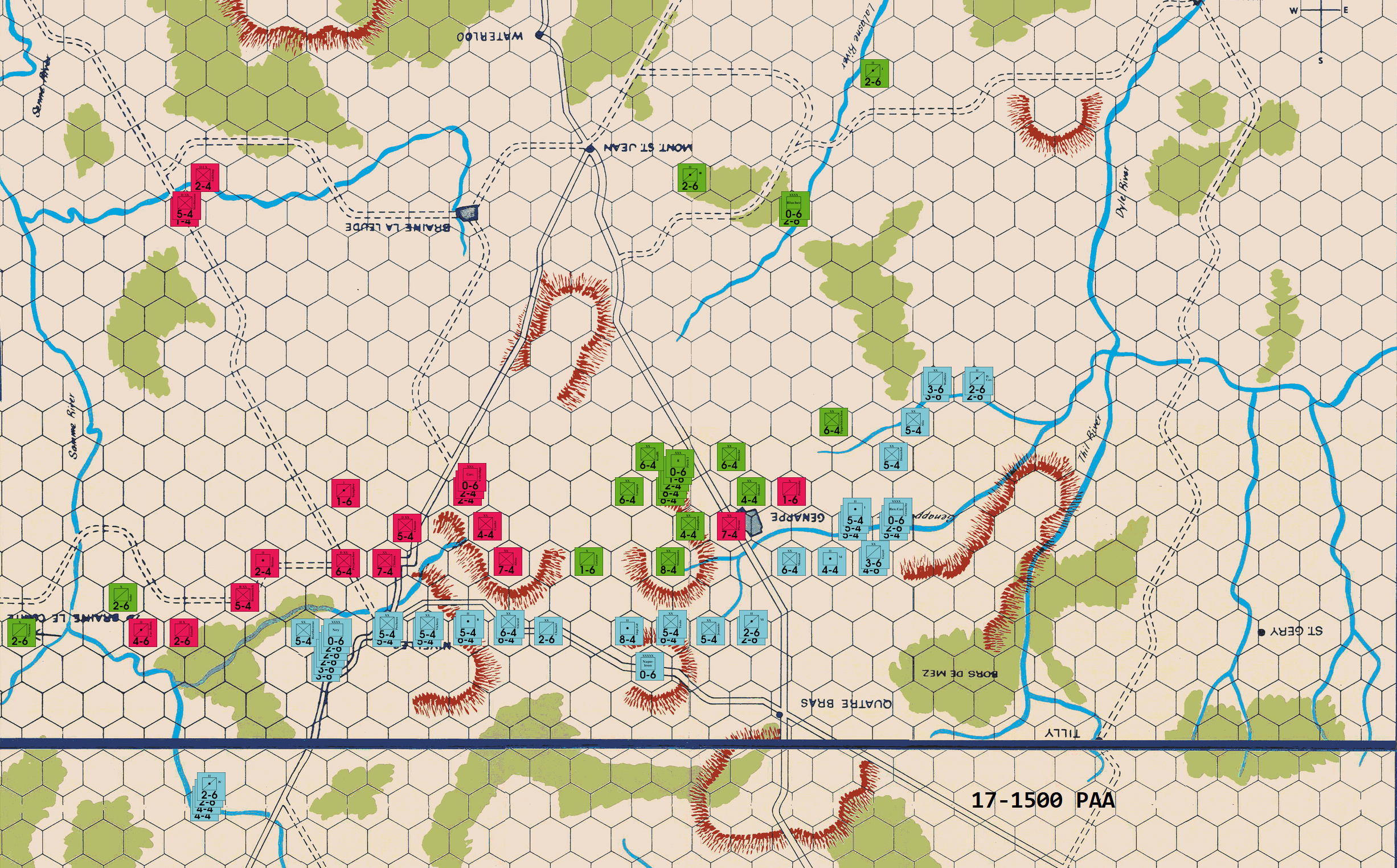
The PAA debates a counter attack, but it is a turn too early. The French almost have to make a move on the 5pm turn coming up, so we will see how that goes. The center defensive terrain is quickly developing holes and we won't be able to delay there for much longer very cheaply without counterattacking. It will be interesting to see if the French bring a significant amount of cavalry to the flanks. The French do not have an extensive amount of 2-6 soak off units left. The PAA is really short on 1s as well, so soon the PAA will be soaking off with 2s. It is starting to look somewhat grim for the PAA tactically. Fortunately the sun is soon setting on day 2 for the French, and the clock keeps ticking.
Uxbridge HQ
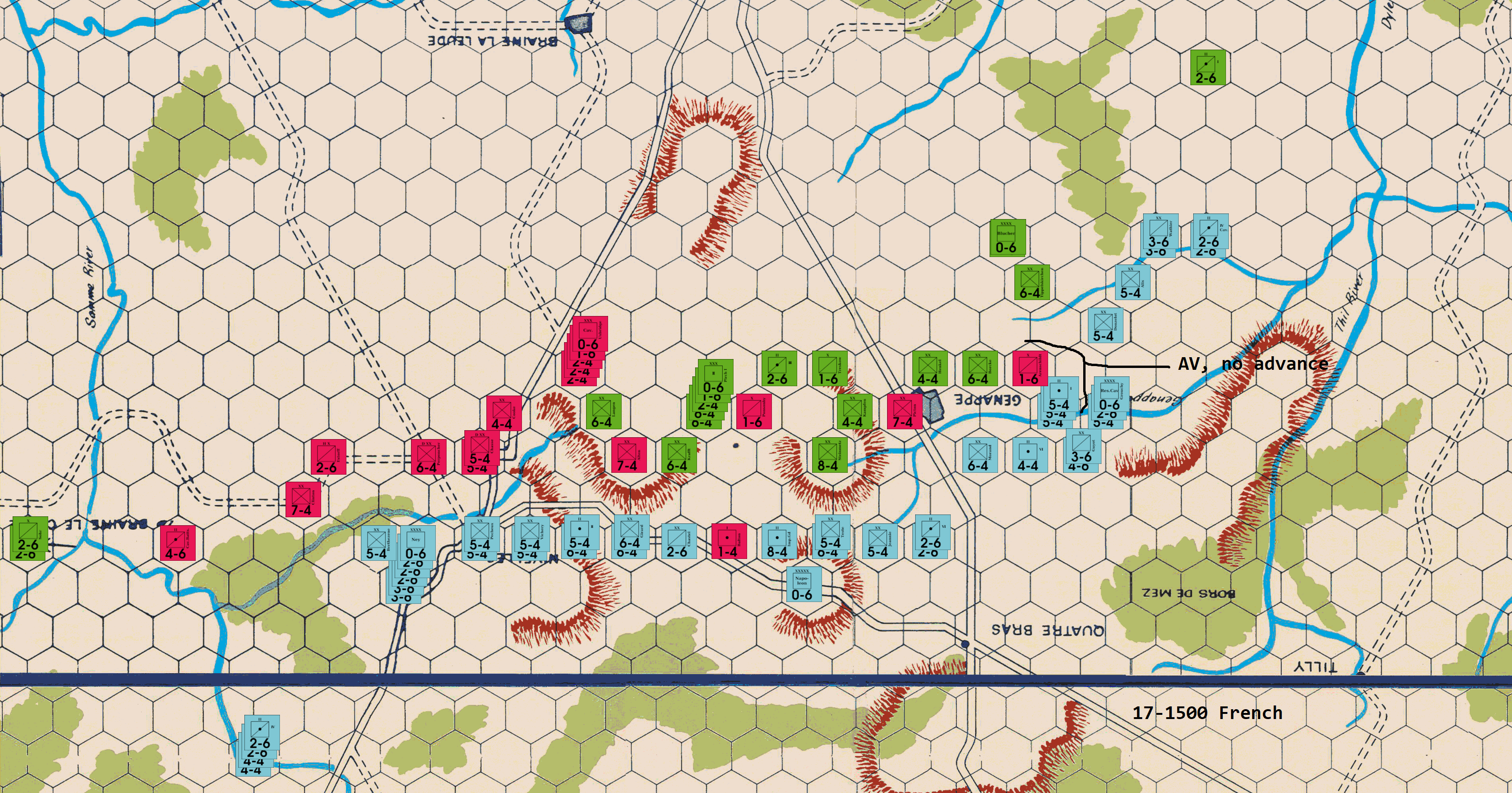
Much to my disappointment, Richard has – wisely, in my opinion, considering the potential wastage of PAA soak-off and delay units, not to mention other possible losses – decided not to embroil the Prussian reserves in a fight to protect the southern flank of Steinmetz at W31. I have no idea how such a melee might have turned out, but, at the very least it would probably have been both quite exciting (and potentially bloody) for one, or both of us. In any case, the PAA commander has chosen discretion over valor, and has opted to withdraw Steinmetz north into the Nivelles-Genappe defensive line, rather than try to hold onto W31 any longer. This Allied move actually alters the game's dynamic because it changes the operational flow of the match and – somewhat unexpectedly – channels the action, going forward, towards a much more conventional (and familiar) middle-game line of play.
In view of the above, and as I now examine the current strategic situation, purely from the French vantage point, there are, notwithstanding the significant pro-PAA "casualties differential" which is still quite worrisome, a few developments that – because I am a "glass half full, rather than a glass half empty" kind of guy – I actually find modestly encouraging.
The first is that, because Richard has opted not to initiate combat on this turn, Ney's Left Wing has been allowed to regain its lost tempi, and the two totally separated contingents of L'Armee du Nord will – once the block at V33 has been cleared – finally be able to reestablish contact with each other. What this means, in a nutshell, is that the French battle line will, as soon as next turn, be in a position to threaten all four of the most important doubled positions in the PAA middle-game "Main Line of Resistance." These defensive positions, for those observers who are relatively new to WATERLOO, are: the bridge hex at T39 (Nivelles); the ridge position at T36; the hillock at T32, and the bridge hex at S31 (Genappe). Granted, the Allies have concentrated enough combat power in the center that the PAA commander could, if he wanted to, certainly launch a spoiling attack against the newly-forming French line; however, given the length of the front between Nivelles and the hillock at T32, I personally find such an Allied adventure unlikely.
Second, the greater part of the east-west primary road will very soon come under French control, and this is no small matter. Among other things, this welcome increase in lateral mobility means that a significant number of French units – when the fighting actually starts – will be able to switch much more easily, from one section of the front to another, than their PAA counterparts.
Finally, the French Right Wing, under Marshal Grouchy, is continuing to successfully develop its position both astride and across the Genappe River in the east. Realistically speaking, Grouchy's detachment – although its cavalry contingent is poised to raid northeast towards the La Lasne River crossings – is not yet in a position to seriously menace either S31 or the northern section of the Quatre Bras-Mont. Ste.-Jean primary road; that, however, could well change in the next turn or two.
So far as this latest French move is concerned: I have, besides eliminating the two PAA "speed bumps" left in the path of the French advance, elected to use the 17 Jun 1500 game turn mainly to reorganize L'Armee du Nord in preparation for the battles that are almost certain to come.
Nivelles: In the west, a small force has been assembled at AA40 which, if the Allied player does not react to it, could – when combined with the cavalry stack at W39 – actually attack the 4-6 in V44 at 3-1 next turn. I don't actually expect anything to come of this, but if Richard dispatches even a unit or two towards this sector, then I will consider this maneuver to have been a modest success. Farther to the east, the Anglo-Allied dispositions in and around Nivelles are a little more interesting. Needless-to-say, the 7-4 at T36, and the two 5-4s in T39 are each of them vulnerable to French 2-1 attacks, which probably explains the heavy concentration of Prussian units around T36. Interestingly enough, I did briefly consider assaulting T39, but the attack that I had in mind would not have been a "big" 2-1. Instead, my plan would have required fifty-one factors [instead of the minimum of forty-four required for the 2-1], and would have required three separate attacks. The first attack would have been an assault versus Perponcher at T40 at 1-1, with twelve factors (a 6-4, a 4-4 and a 2-6 in U40) and, if successful, would have called on the 2-6 to advance. The 1-1 would have been followed by a 1-2 against Chasse and Cooke, using nine factors in T38. This second attack would have given the French a 40% chance of capturing T39 in one turn, because both a DB2 and an exchange would have removed Chasse from T39; as an added bonus, these units would only have remained exposed at T38, at the end of the French player turn, if they had actually won their battle. The third assault in this trio of attacks would have required thirty factors (at U39 and U38) and would have taken on Brunswick at 3-1. Unfortunately, with the east-west primary road still blocked by Balton, and twenty-nine Prussian factors lurking close by (and a couple of dozen Anglo-Allied factors also in the neighborhood), I decided that, even if Ney's forces got phenomenally lucky and they actually succeeded in capturing T39, there was probably a very good chance that they would not have been able to hold it long enough for help to arrive.
The Center: This turn's French dispositions in the center really have only one goal: to grab as much real estate as possible, but to do so without exposing Napoleon's units in this sector to undue risk. The easiest way to do this, I have found, is to adopt a linear formation while also deploying the French battle line in such a way as to make any Allied spoiling attacks awkward to execute. That said, next turn, I expect a single Anglo-Allied 1-6 to be sacrificed at T34 but, at the same time, I also look for the Allied positions in the rest of the Nivelles-Genappe Line to be almost unassailable.
The Genappe Line: When I first saw Richard's dispositions in this sector, I was a little surprised: I had thought, prior to actually seeing the PAA move, that my opponent would probably commit at least two 6-4s to the defense of the northern fork of the Genappe River. Instead, he has decided to make do with only one. I suspect that this choice was probably motivated by his desire to mobilize as strong a force as possible within supporting range of T39, T36 and T32. And, I must admit, that all things considered, this choice makes more than a little sense: the French threats against T39, T36 and T32 are immediate, while the threat posed by Grouchy's methodical push west along the banks of the Genappe River will – barring a sudden shift to low-odds attacks – probably take a couple of turns to produce meaningful results. Of course, the complete abandonment, by the Prussians, of the defense of the confluence of the Genappe and Thil Rivers, does mean that the small compliment of French cavalry at O28 and O27 will – if the situation to the northeast seems promising – be able to make a dash for the La Lasne River Crossings. In any case, this sector will probably continue to be a strategic "side show," at least for the next couple of game turns.
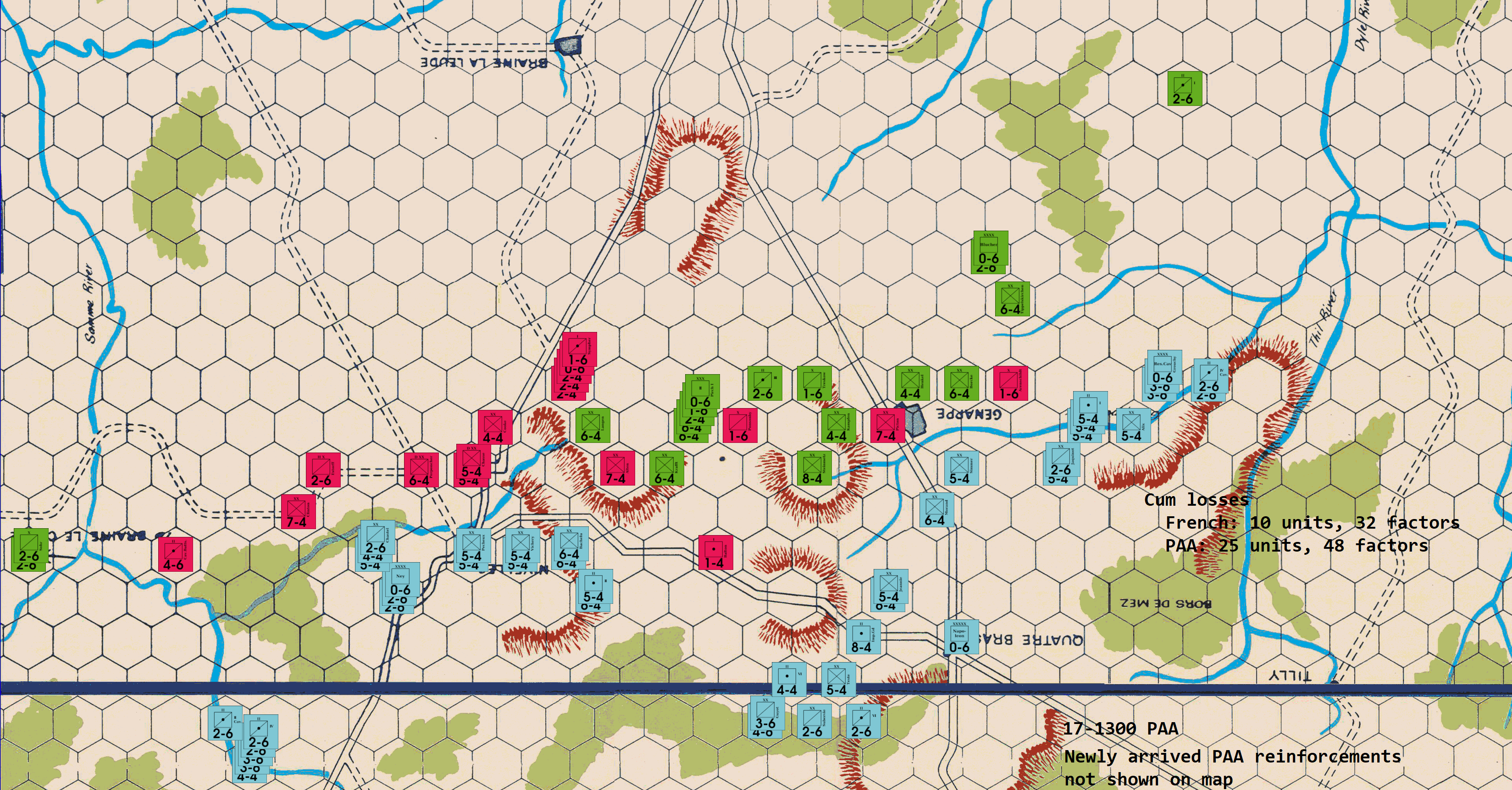
The PAA considers 2 units a turn an ok price at this juncture for slowing the French advance. The good defensive terrain in the center can't be held forever at this price however. The PAA considers where and when to make a stand, at least for a few turns, against the French onslaught. Joe's patience is remarkable. The 2nd day is coming to an end soon though.
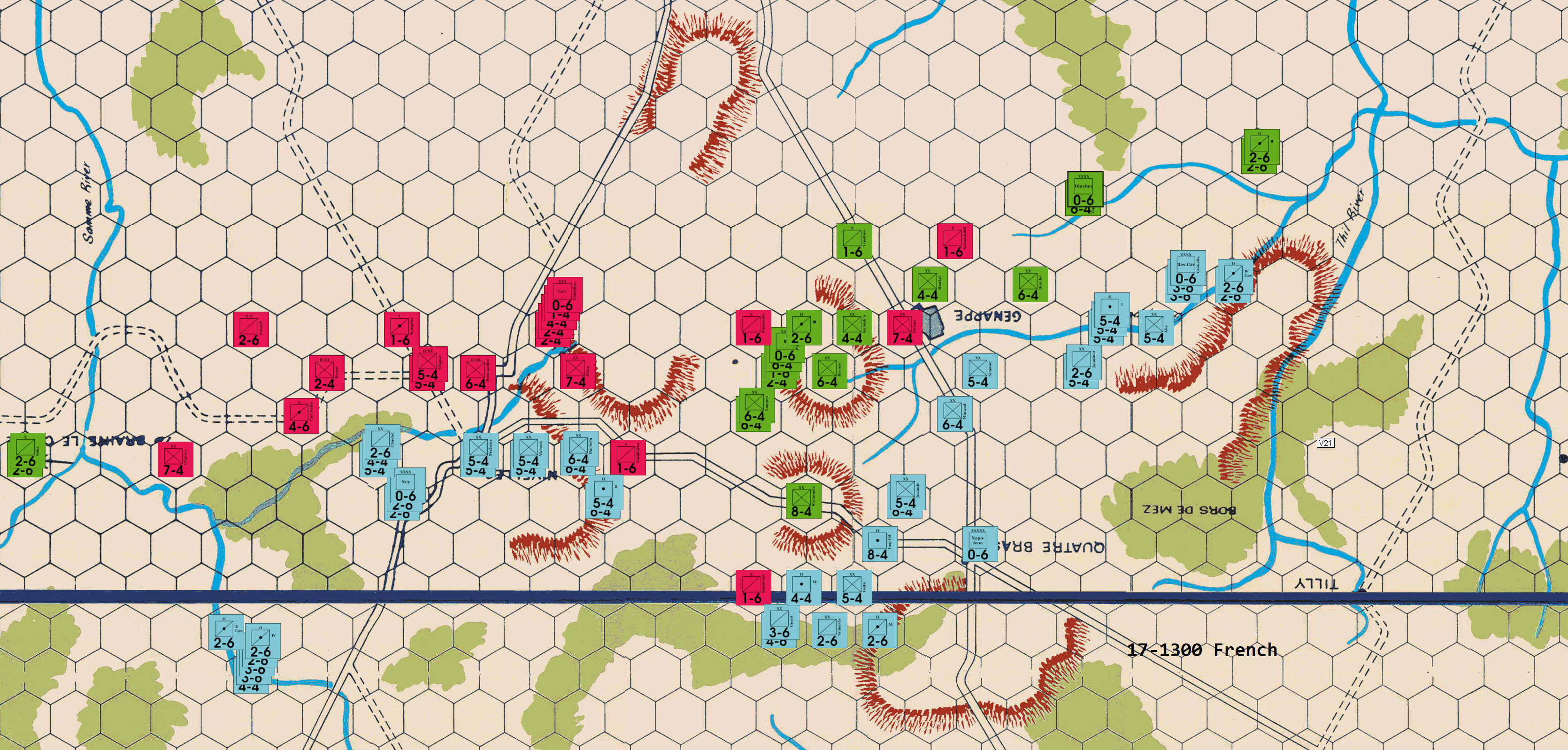
Richard's and my WATERLOO Tournament match is now very close to a crucial inflection point: at present, the French Left Wing is two turns behind schedule, and the "casualties differential" separating the two armies currently favors the Allies by some fifteen to twenty combat factors. Obviously, unless the L'Armee du Nord can both regain its offensive momentum and, at the same time, also start to eliminate more than one or two Allied delay units per turn, then the Emperor's campaign will inevitably sputter to a halt, probably by the morning of the 18th, if not sooner. For the time being, the front line French Army still enjoys both numerical (forty to thirty-three units) and combat power (161 to 122 factors) superiority, and although a fresh batch of Anglo-Allied reinforcements (three units and eight factors) will enter the map on the Road to Hal entry hex on this game turn, they will not be able to reach the Nivelles battle area until the Allied 18 Jun 0700 player turn. What all this means, as Richard noted previously, is that the French Army really only has four or five game turns left in which to turn things around. In my view, this means that L'Armee du Nord needs to break the PAA's Nivelles-Genappe Line while, at the same time, also substantially reducing the current Allied "casualties differential" by the 18 Jun 0900 game turn, at the latest. A tall order, but hopefully, not yet beyond reach. The most obvious route to achieving such a near-term positive French outcome – short of winning lots of low-odds battles (not impossible, but unlikely) – is for Napoleon to lure the Allies into a major fight in the open during the next few game turns. Unfortunately, the PAA player is as keenly aware of the current strategic situation as I am, so it remains to be seen whether Richard will take the bait and either attack the exposed French units east of Nivelles, or opt to strike at one or more of those French units in the center which have just now pushed forward in a somewhat awkward attempt to turn the southern flank of Steinmetz at W31. Whatever the Allied player decides, the next half dozen game turns should be critical to the ultimate outcome of our match.
The Nivelles Sector: In spite of the several disappointments of the first day, Marshal Ney's forces have at long last gained enough ground in the west that they are finally able to compel the PAA commander to begin spreading out his Anglo-Allied defenses in the Nivelles sector. With multiplying French threats, and with Picton at S31 and Clinton at V44, Wellington should – at least temporarily – find it difficult to marshal enough units to both cover the Samme river line and, at the same time, to also mount a worthwhile counterattack against any exposed French units to his immediate front. So far as promising targets for French attacks on this turn are concerned, there were only two that recommended themselves: Vandeleur at V35, and Alten at T37. The AV against the 1-6 blocker, not withstanding the substantial Prussian forces lurking near T32, was a given; a 1-2 versus Alten (using the III Corps Foot Arty) was also exceedingly tempting. In the end, I reluctantly decided to hold the French 4-4 back so that – once the Allied player made the expected swap of the positions of Clinton and Cav. Batts. next turn – the III Corps Foot Arty could be dispatched to AA40, thereby contributing to the possibility of a 3-1 versus the British 4-6 at V44.
The Center & Genappe Sectors: The delay, by Ney's Left Wing, in being able to start a French drive east along the Nivelles-Quatre Bras primary road (along with the unfortunate survival of Steinmetz on the 16th) has allowed the Allies to hold onto the hilltop at W31 several turns longer than usual. Needless-to-say, the doubled Prussian 8-4 could immediately have been assaulted at 2-1 on the French 17 Jun 1100 player turn, but two considerations dissuaded me from ordering such a risky attack that early in the day. The first was the (at that time) still unresolved, but potentially fluid situation around Nivelles: Until French forces could clear V37, it was unlikely that I would be able to organize an effective French drive east to link up with the main army in the center. In this situation, a French reversal against W31 would make such a Nivelles-based drive problematical, to say the least The second consideration had to do with the French dispositions around Quatre Bras at the start of the 17 Jun 1100 game turn; to whit: L'Armee du Nord – not having any units astride the eastern Genappe River at the beginning of the turn – was simply in no position to mount an immediate and believable threat against any of the Prussian defenses on the Allied Left. On the other hand, once a sizeable French contingent had been able to establish multiple bridgeheads across the Genappe River (specifically in the area around S26), then such a force would conceivably be able to menace Allied positions from N24 in the east, to S31 to the west. And there was another consideration in play as well: Since the French would be across the Genappe River a couple of turns earlier than usual, I decided that this extra time might as well be used in trying to outflank the Steinmetz position at W31. If such an attempt were to fail – and there is, regrettably, a good chance that it will – then the low-odds option will still be available. And, better late than never, all of this prologue brings us, at last, to the current French move.
As noted above, the French have now managed to put thirty factors astride the Genappe River east of the town of the same name. In light of this fact, I expect to see Richard respond by dispatching a couple of Prussian 6-4s to keep Grouchy's units on the "safe" side of the northern fork of the Genappe River, and also by inexpensively screening Picton's eastern flank by interposing a British 1-6 on the north bank of the Genappe River between S31 and the French. In the center, Napoleon's attempt to "winkle" Steinmetz out of his hilltop fortress is spearheaded by the VI Corps Foot Arty. The 4-4 was chosen – instead of a 2-6, for instance – because, although it is not a particularly valuable unit to most French players (in fact, any that survive to the end game, often see service as soak-offs), it does require the Allied player to commit at least twenty factors (plus a soak-off or two) to achieve a "safe" 5-1 (surrounded) attack. But, of course, along with the units maneuving against Steinmetz, there are also the French units bearing down on W31 from the west. How much combat power is the Allied commander prepared to invest in fighting in either of these advanced positions? I confess that when it comes to Richard's reponse either to the French advance east from Nivelles, or to the flanking move south of the hillock at W31, I really have no idea what he'll do, especially with the French threatening the Allied positions east of Genappe. I guess that I'll just have to wait and see.
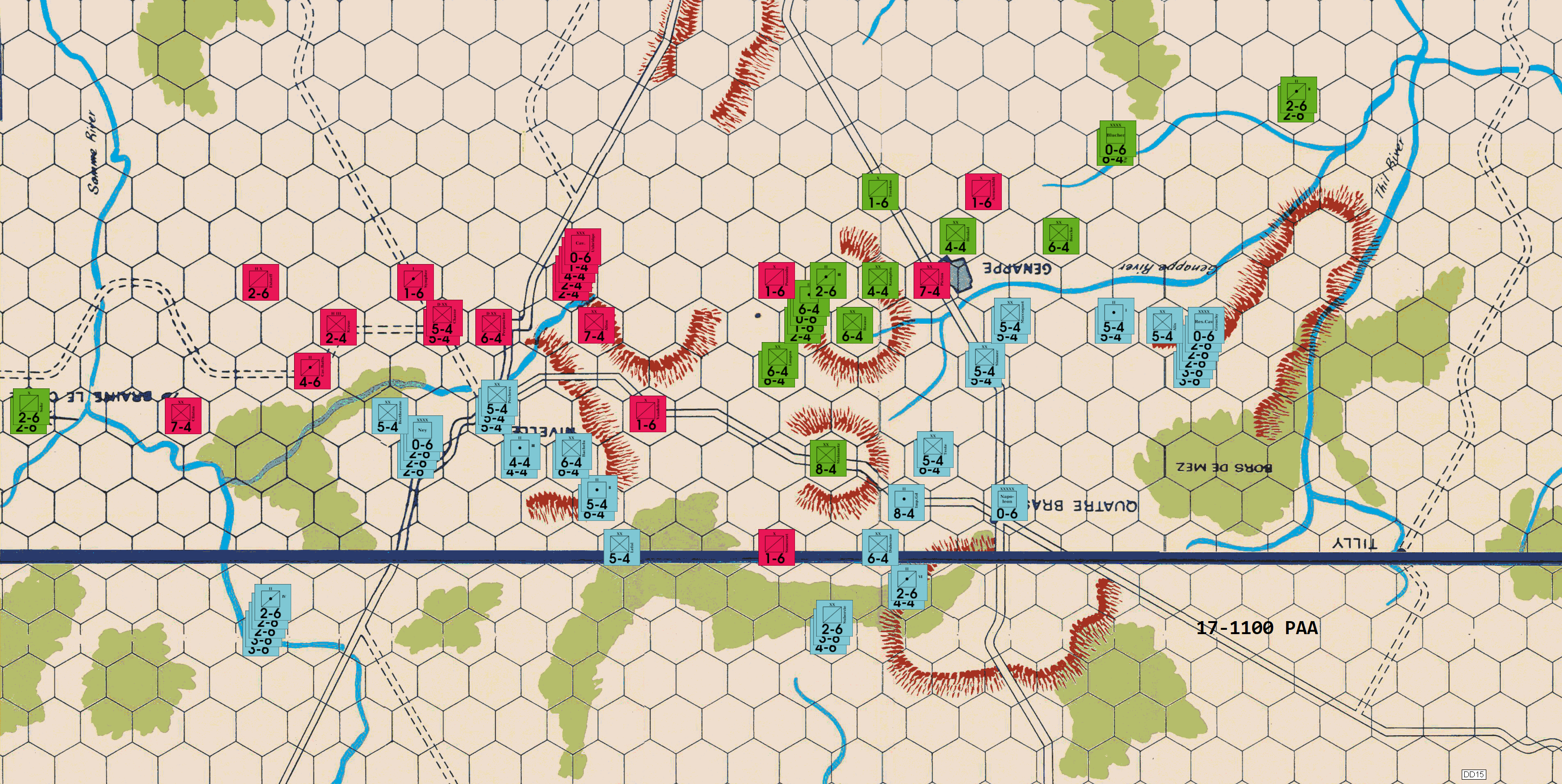
With the French a bit more patient on the 2nd day than I anticipated, we will have to stretch out our line some. The defense at Y31 becomes interesting because the French have threatened a 3:1 against any unit I could put there, so the PAA elects to put a delay unit there. However any French attack on that hex will open the French up for a possible surrounded counterattack. The Prussian reserve shifts towards that position, ready to spring into action to wallop a French division. No doubt Joe is aware of the French vulnerability here.
The French cavalry heading towards the flanks is starting to stretch the line some. I really don't like letting the French cross the rivers on the flanks uncontested this early in the game, so the PAA shovels a 7-4 into the bend west of Nivelles to shore it up for the moment.
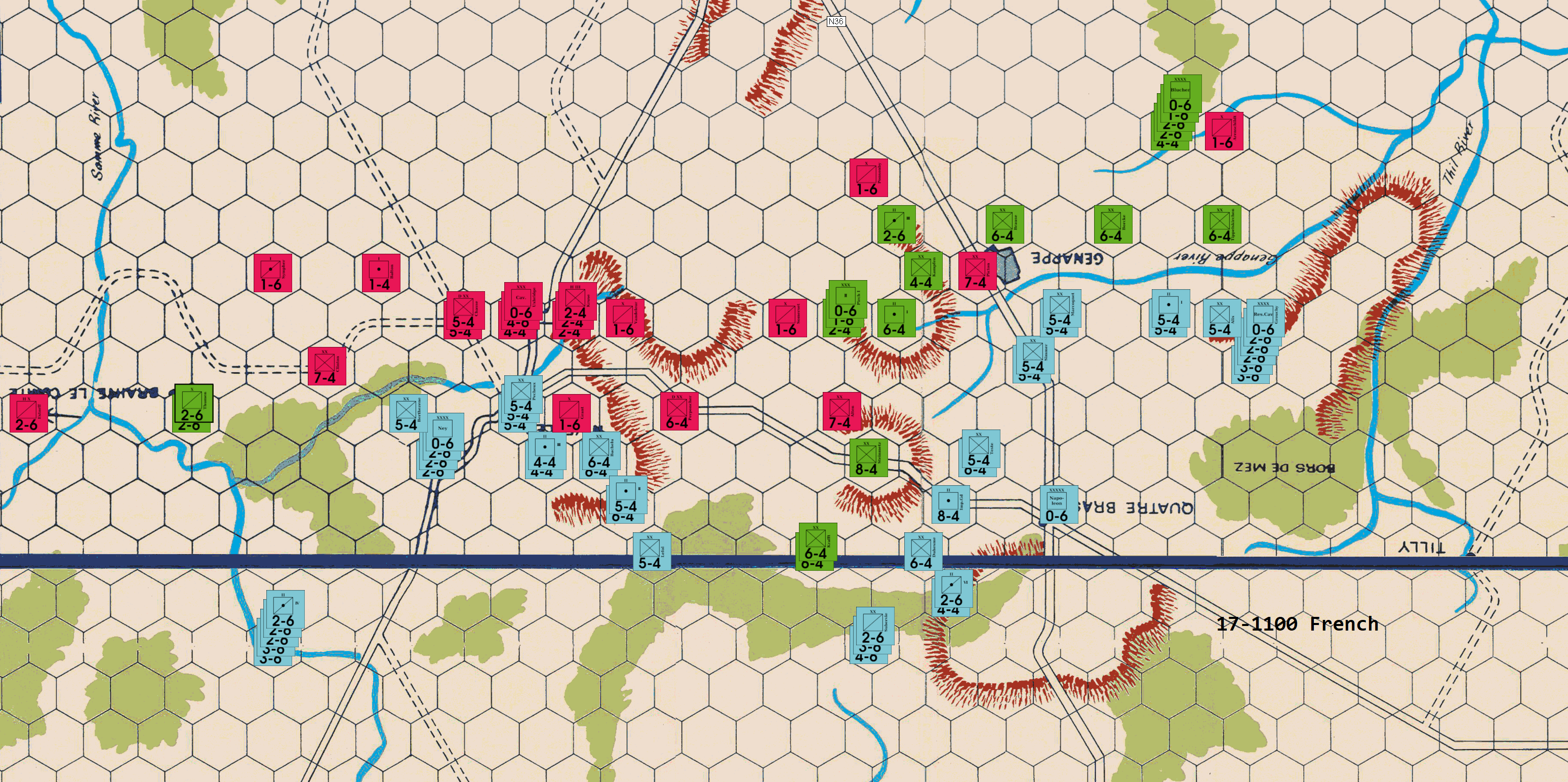
This turn's Allied dispositions are pretty much "text book," when it comes to correct PAA play during the early middle game. The only modestly good news for the French, on this turn, is that the force around Quatre Bras has been allowed to close up on the Genappe River a little earlier than expected; but, other than that, events are proceeding about as expected. The bad news is that the French failure to eliminate the Prussian 8-4 with a 1-1 on the 16th, now means that linking up the two Wings of L'Armee du Nord is going to be both time-consuming, and potentially risky. And, of course, as Richard and I both know only too well, Napoleon is going to have to "throw the dice" and make one or more low-odds attacks at some point on the 17th. Like it or not, taking a few risks is currently the only way for the French Emperor to restore his army's offensive momentum in time to give his campaign some chance of ultimate success. Brussels is still a long ways off and, as Richard previously noted: the game clock is ticking.
Nivelles: Not surprisingly, the Allied player has opted to deploy a single sacrifice unit at V37 (Grant), while positioning Perponcher at V35 [This hex, barring French interference, will almost certainly be occupied by an Anglo-Allied 1-6 next turn], so as to prevent French occupation of W35, unless, of course, Ney is willing to attack Perponcher at low-odds. As it turns out, he is not: the risk/reward calculus is simply too skewed in the Allies' favor. Hence, instead of attacking the British 6-4 this turn, Ney opts to strongly occupy V38 [so as to block the bridge at U38], to eliminate the Anglo-Allied blocker, and to position his units so as to be able to weather an Anglo-Allied counterattack, should one come. Needless-to-say, the French Left Wing is is still behind schedule, but at least it is finally pushing forward, albeit at a glacial pace.
Quatre Bras: As expected, Richard has offered very few attractive Allied targets in the center – low odds, or otherwise – for L'Armee du Nord to attack this time around. Granted, Steinmetz (W31) can be attacked at 2-1, but such an attack – given the overall battlefield situation – is currently at least a bit premature. Certainly a solid victory against the Prussian 8-4 would be quite welcome, but it would not really be a "game changer" so far as this match is concerned. It is better, I think, for the French to use this turn to maneuver so as to be positioned to threaten multiple Allied targets on future turns, rather than to concentrate the bulk of Napoleon's central combat power against one or two enemy-occupied hexes this early on the second day. The French Emperor is going to have to gamble at some point on the 17th, however, until Ney's forces can push a little farther north and east, this is probably not yet the time. That said, Napoleon contents himself with tidying up his front lines, while he awaits the Allied response to the latest French move.
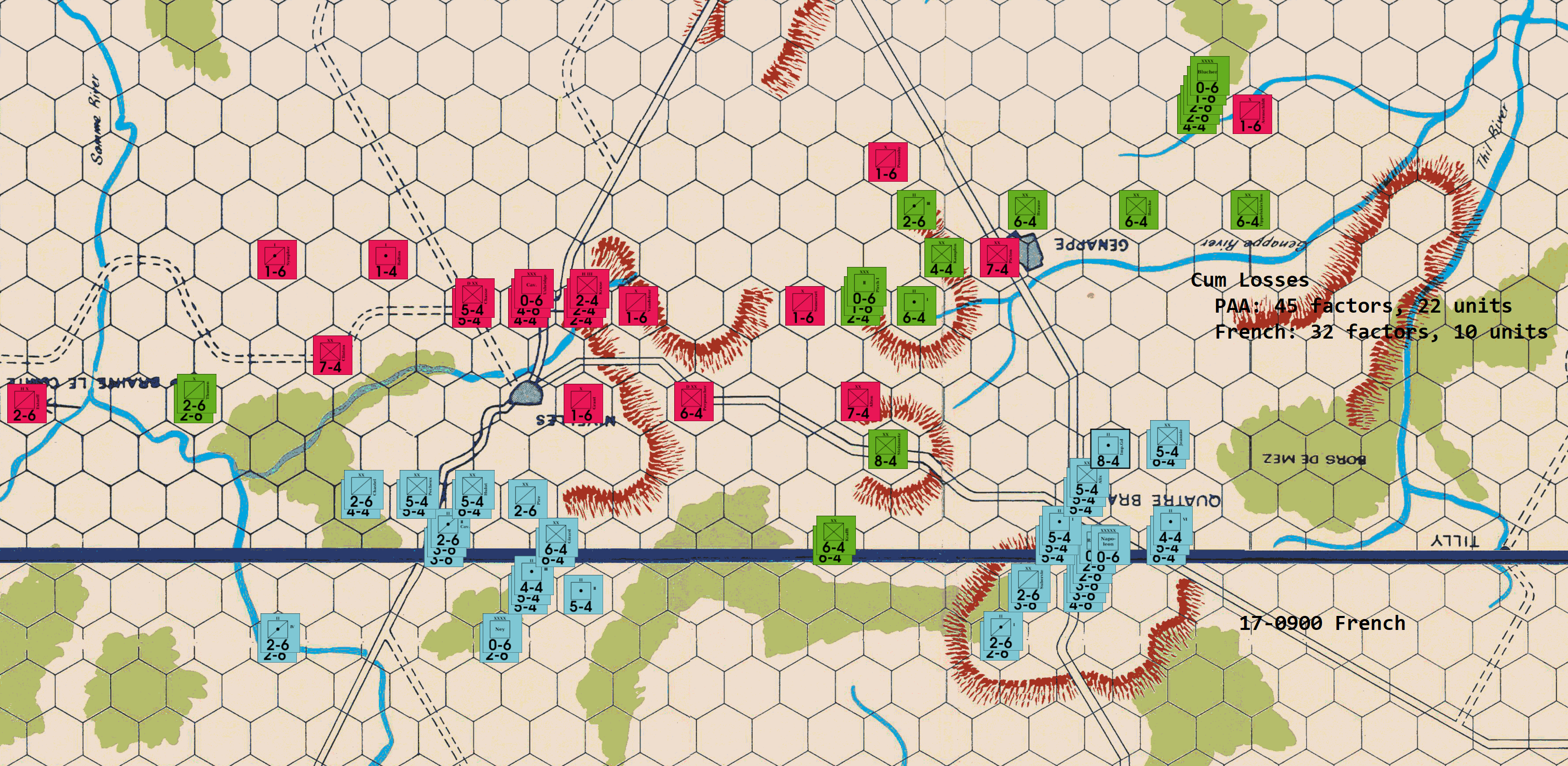
The PAA has a slight edge at this point. With strong defensive terrain in the middle of the board, the PAA digs in and waits to see if the French are willing to gamble to push the envelope with the clock ticking. A calculated French risk is likely to be taken at some point over the next few turns, so low grade panic permeates the PAA line as we await the inevitable French charge. The French have about 5-6 turns to make something happen besides killing 1 or 2 delay units a turn. All Blucher can do at this point is review the line each turn to make each option for such a low odds gamble as unattractive as possible.
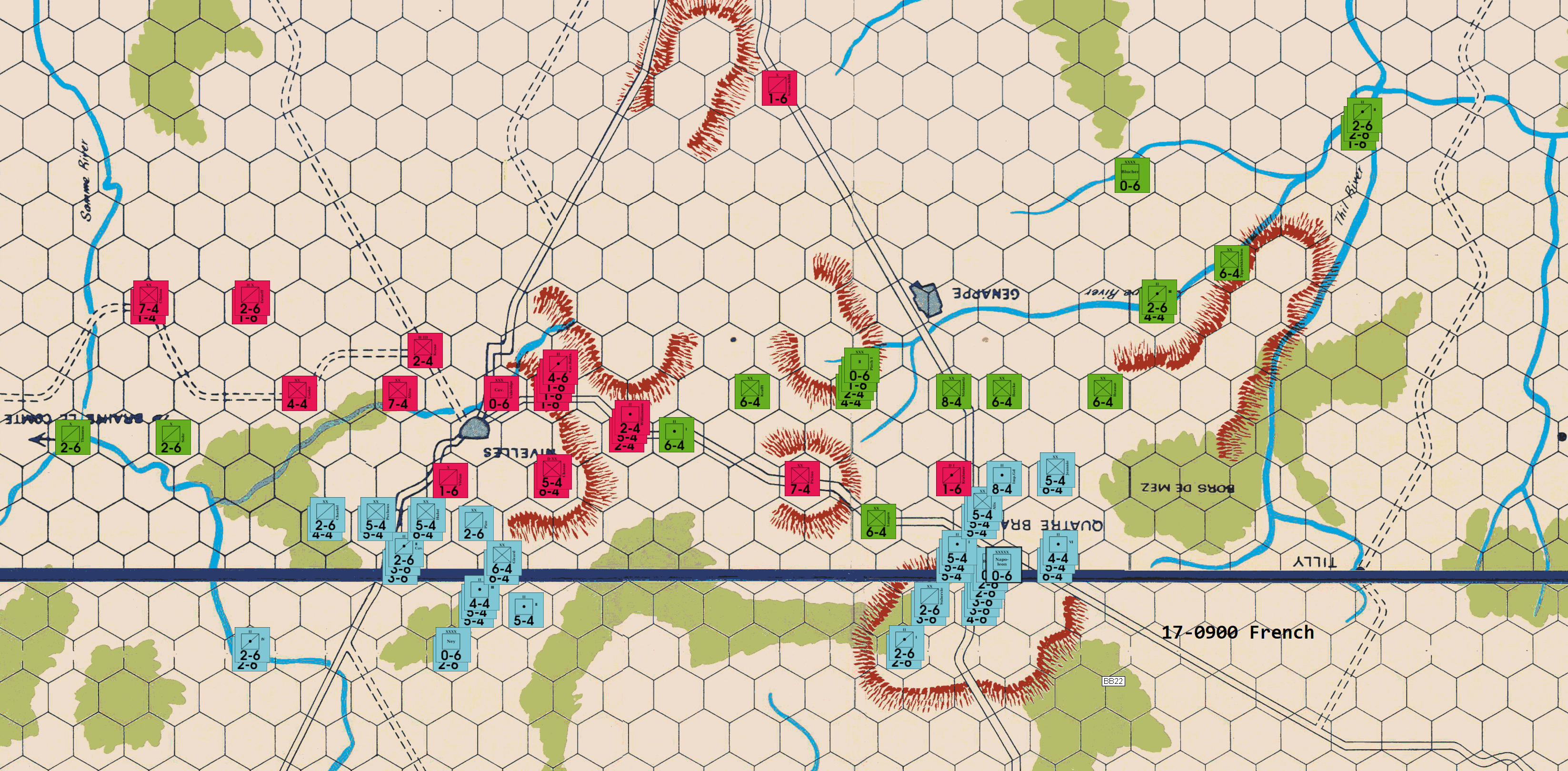
"He who makes war and has never made a mistake, has not made war very long." Napoleon Bonaparte
I was curious to see whether Richard would "bank his (French casualties) winnings," or whether he would decide to continue the increasingly-expensive fight at Nivelles for another turn. I now have my answer. Interestingly enough, I would also have had the PAA brake off contact with the French Left Wing on this turn, as staying around to pick off a few of Ney's exposed cavalry units would – at least in my view – have needlessly put some of the "best" Anglo-Allied units at risk for a minimal return. More to the point, the Allies have lots of "force-multiplying" terrain to their rear and a formidable stable of combat units available in the battle area, so it really makes very little sense for them to continue to fight the French, on even terms, in the open. Unfortunately for Napoleon, this turn's carefully-staged Allied withdrawal means that he is going to have make some exceedingly tough choices in a turn or two.
Nivelles: The early French positional error in the lead-up to the battle for Nivelles continues to plague the French. Had Ney not squandered a tempo on the morning of the 16th, then it is highly likely that the 1-2 at Nivelles, and the 1-1 at Quatre Bras would have been postponed, at least for a turn. That is not to say that the attacks would not have ultimately been made, but only that a normal flow of events would have allowed for an evaluation of the initial French combat results at Nivelles to occur before the decision – as to whether or not to launch the two low-odds attacks in question – was actually made. Delaying this pair of low-odds attacks might, or might not, have preserved fifteen French combat factors to fight another day; but, in any case, what's done is done.
So far as this turn is concerned: the Allied withdrawal in the west leaves the French Left Wing with few worthwhile targets to its front, so Ney's troops choose prudence over audacity and cautiously push forward in a "chevron' formation, eliminating the British picket at W38 in the process. [I should note that this type of advance does not preclude an Allied attack against Ney's vanguard units, but it does attempt to make the "opportunity cost" of such attacks as high as possible.] Besides the Allied 1-6, the only other PAA target that really recommended itself was the British 7-4 at U40. This "high value" unit could have safely been attacked at 1-2, 1-1 or 2-1 ["Safely," in this case, meaning that the attackers would neither be exposed to an Allied riposte if they held their position, or if they were retreated]; however, such an assault would have been a purely "attrition" attack and, as a general rule, I eschew "attrition" attacks if they do not also offer some kind of positional advantage to go along with that of "pure" attrition. Hence, although this particular low-odds attack was very tempting, French possession of V40 one turn earlier than usual is pretty much meaningless and so, somewhat reluctantly, the attack versus Alten was declined.
Quatre Bras: As was the case at Nivelles, the French troops in the center adopt the "chevron" style of advance as they begin to debauch onto the open ground between the Quatre Bras crossroads and the Genappe River. Unfortunately, opportunities for French mischief on this front were few and far between this turn; which is to say: other than the PAA block at W28, the only other potential targets for French attacks were the Prussian 6-4s at U28 and U26, and attacking these two units, even with a pair of 2-1s, would have been far too risky – at least, in my opinion – to the units involved; not only because of the possibility of an A Elim, or a 1/2 A Elim, but also because any French retreats would be almost certain to make one or both of the attacking stacks vulnerable to surrounded attacks by local Prussian units.
Tilly Corridor: While it would have been moderately useful to have continued Grouchy's expedition against Wavre and the Dyle River crossings, the French Emperor – thanks to the heavy commitment of troops, made by both sides, to the fighting at Nivelles – reluctantly decided that he simply no longer had the combat power to spare for such a diversion. Moreover, Napoleon had every reason to believe – rightly, as it turned out – that the Prussian contingent in the west would soon be counter-marching back towards the center so as to reinforce the Prussian units already directly to the French Center's front. In view of all that, the French Emperor decided that any further dissipation of French combat power in the center and east would be imprudent, if not foolhardy.
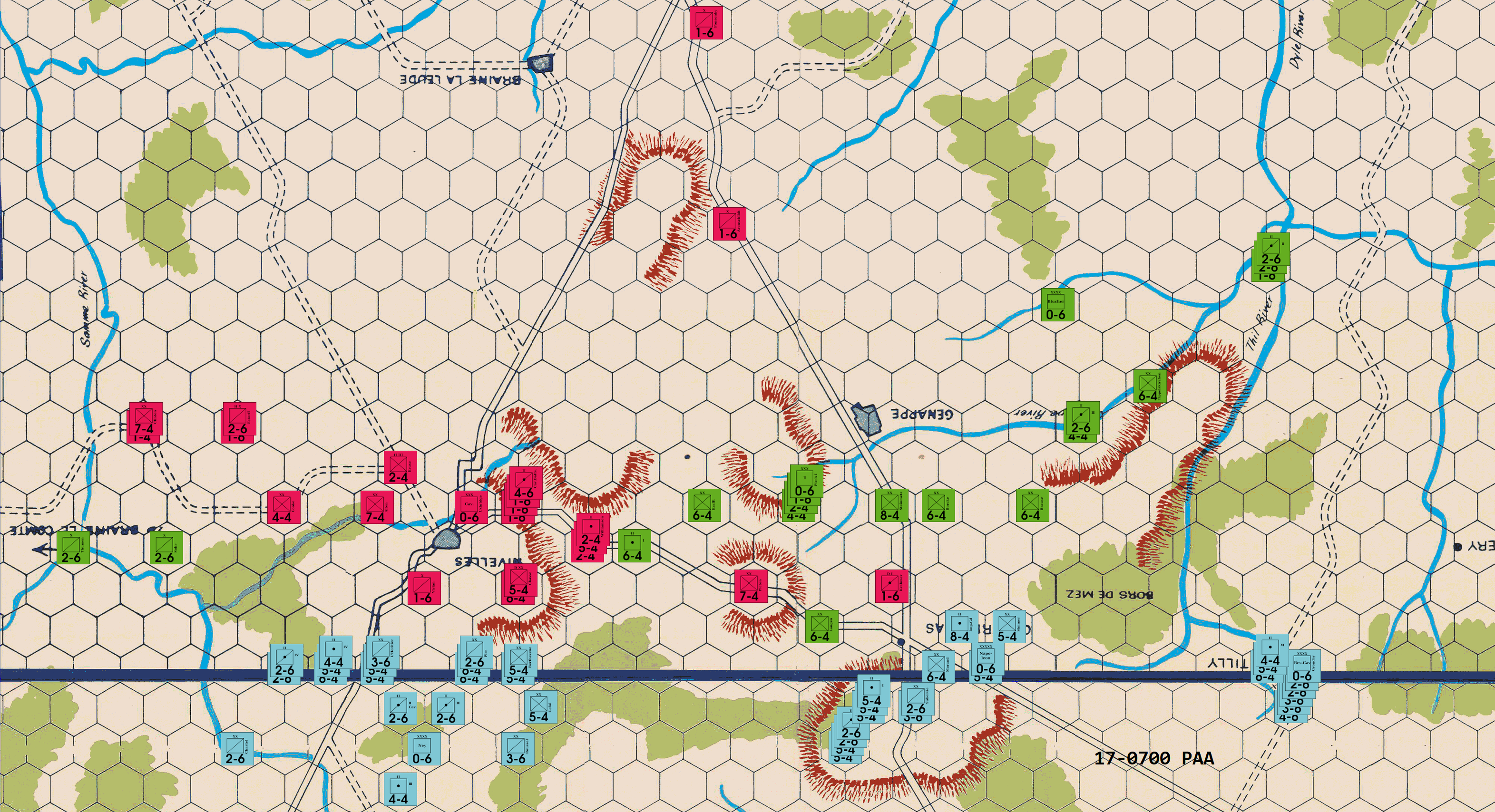
After some ugly French DEs on 3:1s this turn, the PAA has to pull back and play a more patient game while taking advantage of some of the terrain in the center of the board. Reinforcements are coming on. TIme is still on the side of the PAA. With the French backing off in the Tilly sector, more focus is placed in the area near Quatre Bras. How aggressive do the French want to be? Will there be more 1:1s and 1:2s coming?
Between hills and rivers, the PAA can slow down the French quite a bit if the French play is conservative over the next several turns. Joe is a strong enough opponent to know that at some point the French have to "push the envelope." Where and when exactly Joe will do it remains to be seen. Tick tock.
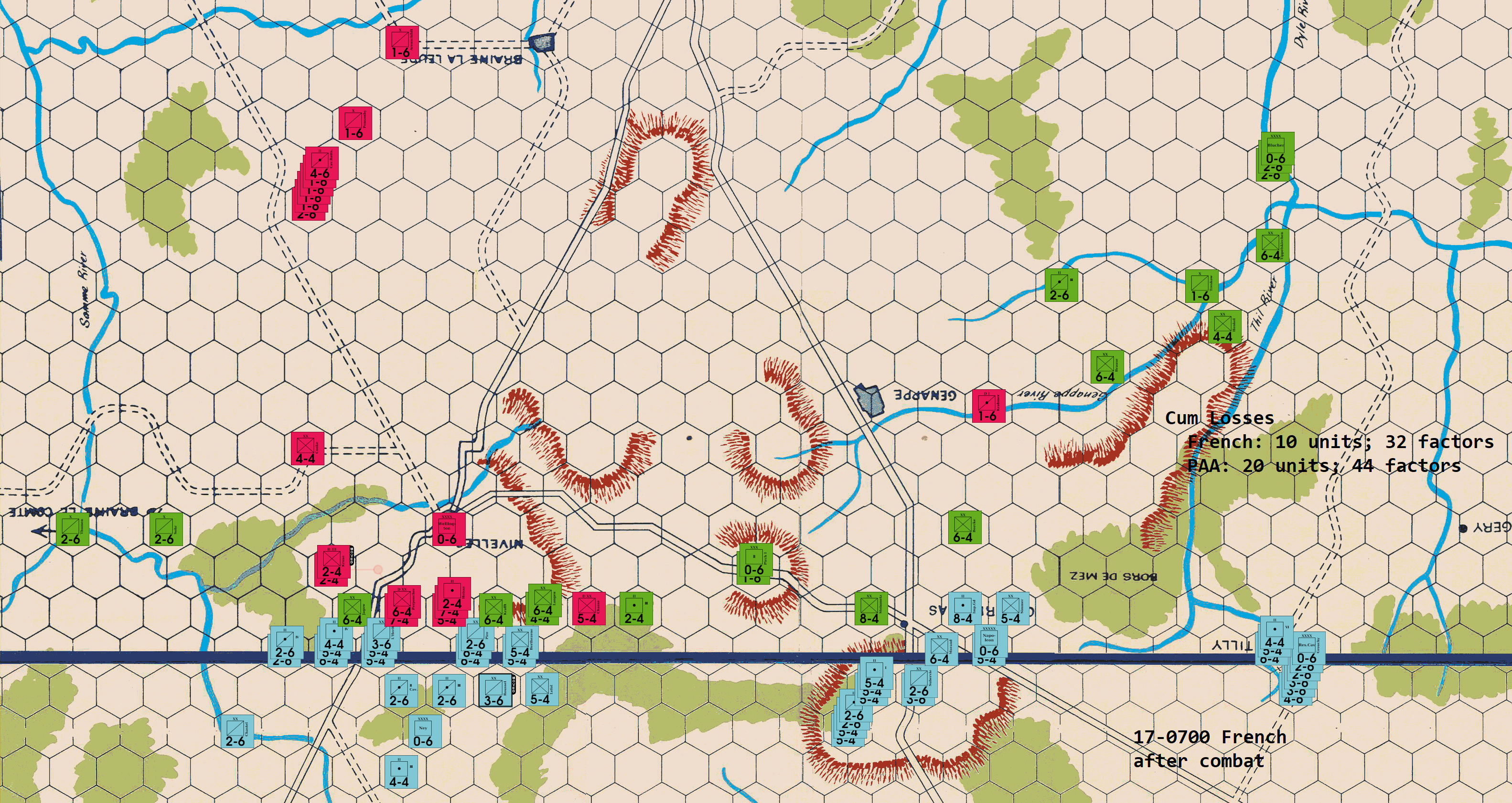
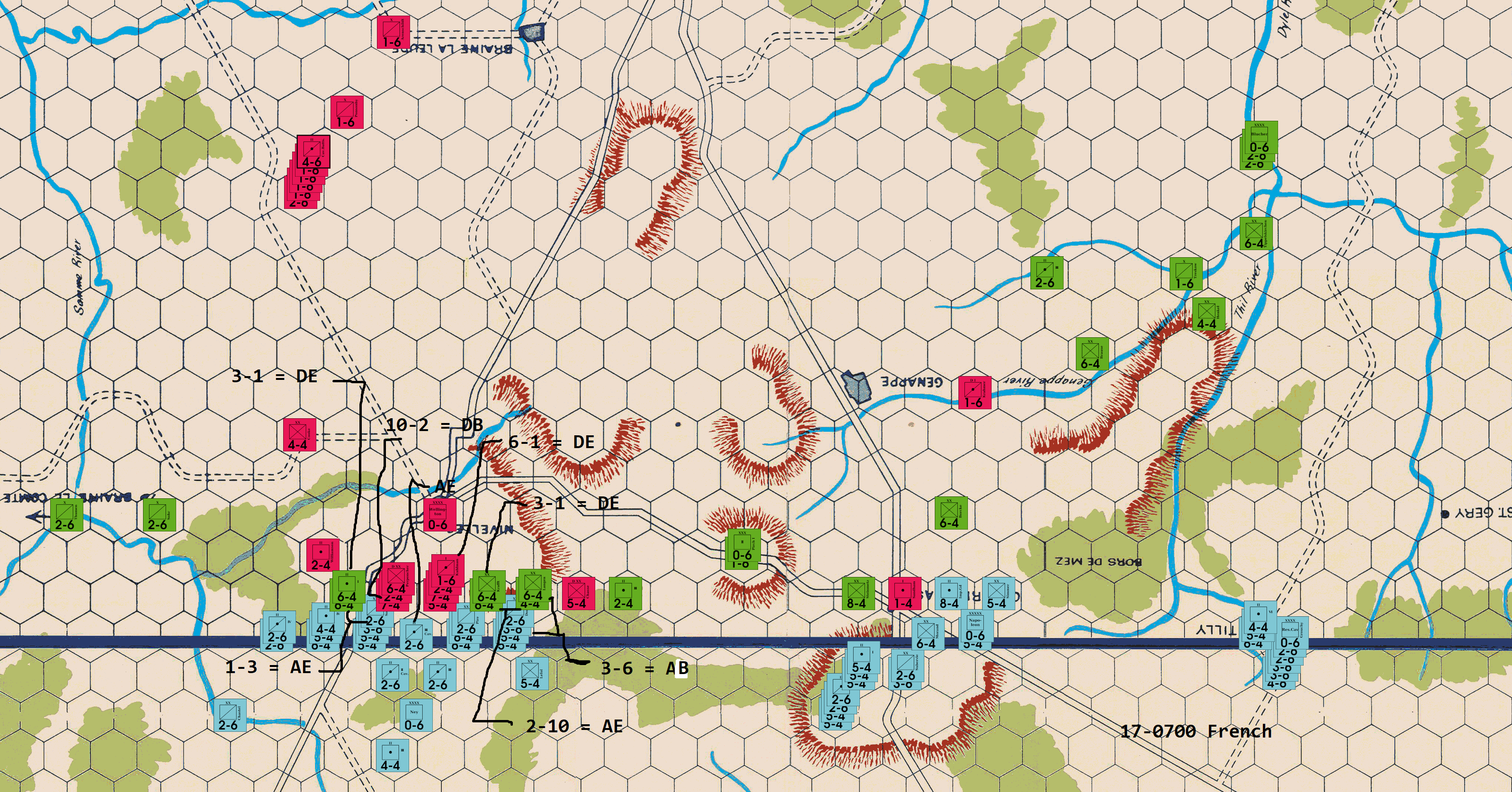
Given the French Army's lackluster combat results last turn, it was no surprise that Richard decided to continue the fight at Nivelles, and to do so by counterattacking a select few French units at odds that incurred no risk of exchange. The miraculous escape of the second French 2-6 from another PAA 6-1 was, of course, gratifying, but hardly significant. Of far greater strategic importance was the utter failure (and complete elimination) of the fifteen French factors that had been committed to a 1-2 at Nivelles, and a 1-1 at Quatre Bras. Needless-to-say, if L'Armee du Nord does not recover some of its offensive elan, and soon, then the Emperor's campaign might not even continue long enough to make it to the 18th.
Nivelles: Thus far, the recent battlefield performance of the "Bravest of the Brave" has not been particularly impressive. The failure of Ney's troops to eliminate Picton last turn with a 3-1 is especially irksome: not only because this 7-4 has survived to fight another day, but also because, as was expected, the Allied commander has taken pains, during his part of the turn, to position Picton and virtually all of the other "high value" Anglo-Allied units in hexes that are – at least for the time being – virtually untouchable by the units of the French Left Wing. And to further add to Marshal Ney's immediate woes, the bulk of the Anglo-Allied Reserve Cavalry will finally reach the Nivelles front on this turn, so Wellington will receive a much-needed infusion of fresh soak-off and delay units just when they will do him the most good. Given the predicament that he now finds himself in, the commander of the French Left Wing does what he usually does in such situations: he orders a broad-front assault against the enemy line directly to his front; and although he could settle for two conservative 4-1s against Prussian 6-4s, he decides to "roll the dice," yet again, on another series of somewhat chancier (and more speculative) attacks. Now, it only remains to be seen whether Marshal Ney can find a little luck to go with his courage.
Quatre Bras: The luckless French assault against Steinmetz, along with its accompanying casualties, has temporarily dissuaded Napoleon from further risky adventures around Quatre Bras. Instead, he sends orders to recall Marshal Grouchy from his sight-seeing tour" of the Tilly Corridor: the French Emperor has decided that, if his army is to regain its offensive momentum, then he will have to insure that he has sufficient combat power available to smash headlong into the Prussian units directly barring the road to Brussels. In the meantime, while Napoleon waits for the Tilly force to move within supporting range of the French troops in the center, he contents himself with clearing away the Allied block occupying the crossroads at Quatre Bras.
The Tilly Corridor: Although Marshal Grouchy had already made his plans for the units of the French Right Wing to advance north against the Thil and Eastern Genappe Rivers, the arrival of two couriers, with orders from the Emperor, oblige him to change his plans. Instead of continuing his march towards Wavre, the Marshal's new instructions are to turn around and to march his troops back towards Tilly.
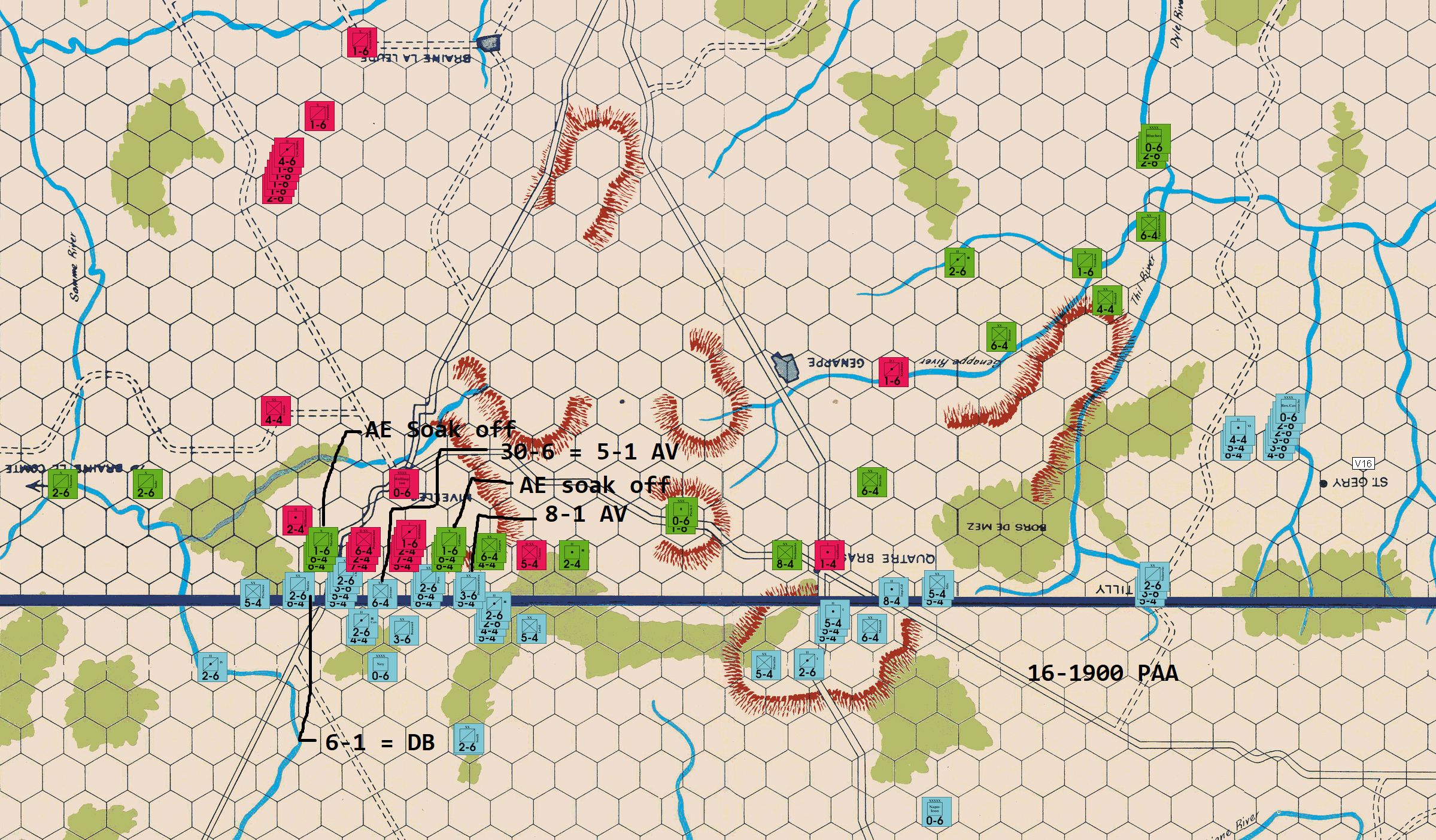
Quite the stroke of luck on the French attacks! The French had some high risk high reward attacks that turn and it didn't quite work out for them. An embarrassing amount of luck means perhaps I should play it safe and retreat with some delay units. However a 6-4 (Jerome) is too good to pass up with their backs to the woods, making them a prime target. The battle at Nivelles rages on.
The PAA goes for high odds 7:1 attacks and 5:1 surrounded here to keep the luck factor down, and prevent any PAA casualties on exchanges while attacking. Although we have to use 2 soak off units to achieve our attacks, we would have had to use at least 1 delay unit if we retreated. The French may make some more low odds attacks near Quatre Bras, but since the PAA is happy with exchanges on those, I am fine to give the opportunity. Although losing the 8-4 in a 1:1 would be painful, the 8-4 is less critical in a brawl type of game with lots of counterattacking than a slow defensive positional game where it is needed to be the keystone of the PAA line.
If the French commit to a full counterattack on the Nivelles front on their next turn, 7am, they will likely need 3 soak offs which gets expensive real quick. I like to try to pick of 2-6s as the PAA when I can because soon the French run out. I hope that a back and forth on the Nivelles front will favor the PAA, but eventually after 2-3 turns the PAA will have to fall back before being enveloped by the French center.

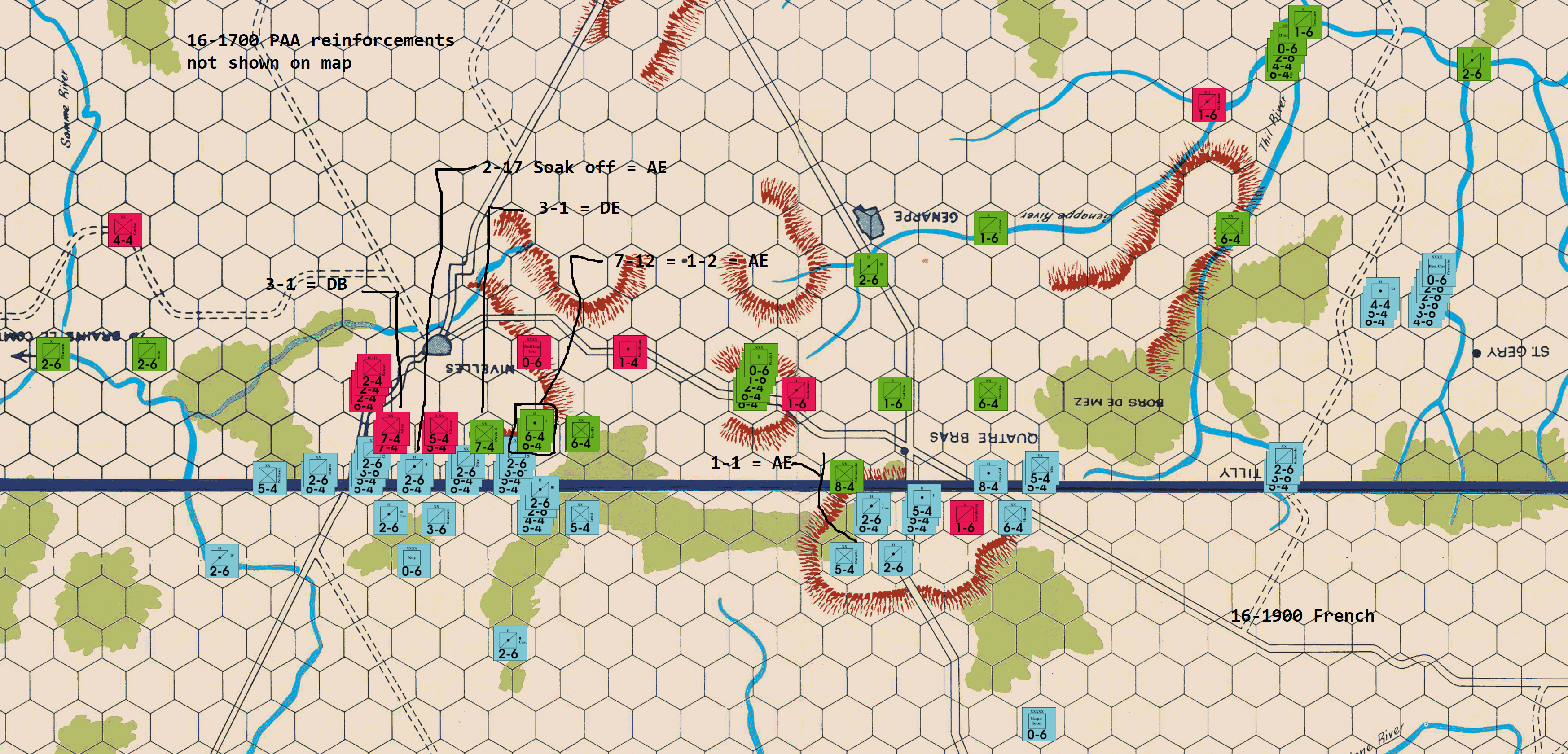
As I predicted, Richard's and my WATERLOOFinals match has, indeed, reached a critical juncture. The local PAA commanders have clearly made their decision: both Wellington's Anglo-Allies, and Pirch I's Prussians have drawn up to offer battle at Nivelles. And as it turns out, Marshal Ney, the commander of the French Left Wing is – perhaps imprudently – also spoiling for a fight. Now, with the fate of Napoleon's campaign hanging in the balance, everything depends on the events that transpire over the next few turns on this particular battlefield; in fact, it is no exaggeration to say that the results of the next couple of rounds of combat at Nivelles will go a long way towards determining both the length, and the trajectory of this contest going forward.
Nivelles: The lost French tempo is really coming back to haunt the Emperor. To make things even stickier for Ney's forces, the defensive line that the PAA player has deployed just south of Nivelles is, as I fully expected, quite formidable. In addition, because Blucher has decided to abandon the defense of the Quatre Bras heights, the Allies also have substantial reserves in the immediate area and, to further add to French woes, the front line Allied units have all been arranged so as to make it exceedingly awkward for Ney's forces to attack more than a couple of them without taking some unpleasant risks; but so be it. After all, Marshal Ney is called "the Bravest of the Brave" for a reason; now, however, he needs to be both brave, and lucky! Moreover, he really has no choice: delay is out of the question as the Anglo-Allied cavalry reserve is already galloping towards the sound of the guns from the northwest, and additional British reinforcements will be entering on the nearby Braine le Comte Road next turn. As things currently stand, the total combat strength of L'Armee du Nord outnumbers that of those Allies at the front by more than sixty factors, but that advantage will soon shrink by at least a third just as soon as these newest incoming PAA reinforcements reach the Nivelles battle area.
Of course, once the decision has been made not to waste any effort against the Samme River defenses or the Braine le Comte Road, but, instead, to hurl most of the French Left Wing straight at the Allied line, the question then becomes: how should such an assault be organized? Since Ney's troops will have the advantage, such as it is, of striking first, the French goal – at least in my view – must be to try to inflict as much damage as possible on the Allies before they get a chance to counterattack. This being the case (and because the French drive against Nivelles is already a turn behind schedule), I have chosen what I consider to be the most prudently aggressive approach (discounting the "big 1-1 versus Picton and Alten, which was considered but discarded); to wit: Picton and Pirch II will both be attacked at 3-1; the II Corps Hrs. Arty will be sacrificed in a soak-off against Alten, Brunswick and Chasse; and Jagow and the I Corps Foot Arty will be attacked at 1-2. [This last pair of attacks will probably raise a few eyebrows among our readers, especially as it is perfectly feasible for the French to attack Pirch II at 4-1 and soak-off at 1-6 against the two Prussian 6-4s. My reasoning, in this case, is fairly straight forward: the 4-1 has exactly the same 70% chance of eliminating the Prussian 7-4 as a 3-1 but, unlike the 1-6 (which has no possibility of eliminating anything, but itself), the 1-2, while a little risky, has a 20% chance of eliminating two Prussian 6-4s . In addition, I should probably also note that, odd as this may sound, this particular 1-2 actually yields a slightly better statistical outcome than any of the traditional soak-offs; to illustrate: projected losses for 1-6 (1.6 factors); 1-4 (1.5 factors); 1-3 (1.2 factors); 1-2 (3.5 French factors/2.4 PAA factors) for an aggregate differential of 1.1 factors.] In short, this initial set of French attacks may not be optimal, but at least they give Ney a small chance of getting lucky.
Quatre Bras: Richard's decision to completely abandon the Quatre Bras position without a fight, although a bit unusual, was not totally unexpected. And although such a precipitate withdrawal might seem premature, it is good to remember that, when facing this type of balanced French offensive, the Allies can really only expect to fight effectively on one front; hence, it is probably not a bad strategy, should the PAA commander decide to fight at Nivelles and not at Quatre Bras, for him to "go big, or to not go at all." In addition, I suspect that – given that additional Anglo-Allied reinforcements would soon be entering play in the Nivelles sector to join with the sizeable British contingent already there – my opponent decided that a major action in the west, using both Anglo-Allied and Prussian units to power his attacks, offered him the best prospect of inflicting a major defeat on the Left Wing of the still widely-separated French Army. The French problem in this sector is that, unless Napoleon takes some aggressive action now, the Allied commander will be able to inexpensively clog the narrow corridor north of Quatre Bras with 1-6s for two or three turns. For this reason, and because this may be the last opportunity to attack Steinmetz in the open, Napoleon decides to order a chancy 1-1 against the one and only Allied 8-4. Obviously, risking eight French factors on a speculative attack like this is not a trivial matter; on the other hand, both a D Elim and an exchange (20% chance for each) help the French cause during the middle game, and even a DB2 has some utility in this instance. Needless-to-say, an A Elim would be painful but, at least in this situation, the attacking French cannot be retreated anywhere too dangerous if their offensive gamble misfires and they roll an AB2.
The Tilly Corridor: The Allied player has finally decided to pull back in order to conserve his remaining 1-6s on this front: a course of action that is both perfectly reasonable and expected. The French response is to finally order the larger part of Grouchy's command to advance into the Corridor and towards the eastern Genappe and Thil River crossings to the north. A small reserve force (ten factors) has been left at Y19 on the chance that the Prussians might unexpectedly double back to the center, and the French contingent on the Quatre Bras front should then suddenly find itself in need of reinforcements.
Epilogue: I had actually composed this commentary before I received the French combat die rolls for this player turn, and had only delayed sending it because I wanted to make a few minor edits. In the interim, I received my combat results. Needless-to-say, things could have gone a little better for both Ney and Napoleon and, while Pirch II was eliminated with a D Elim, the British 7-4 was retreated, and both low-odds attacks generated A Elims. These were disappointing outcomes, to be sure; on the other hand, I am not prone to ex post facto analysis, and "outcomes based" evaluations of a specific move tend, I believe, to almost always be counterproductive in the long run. That said, the French will "suck it up," and hope for better luck in the future.
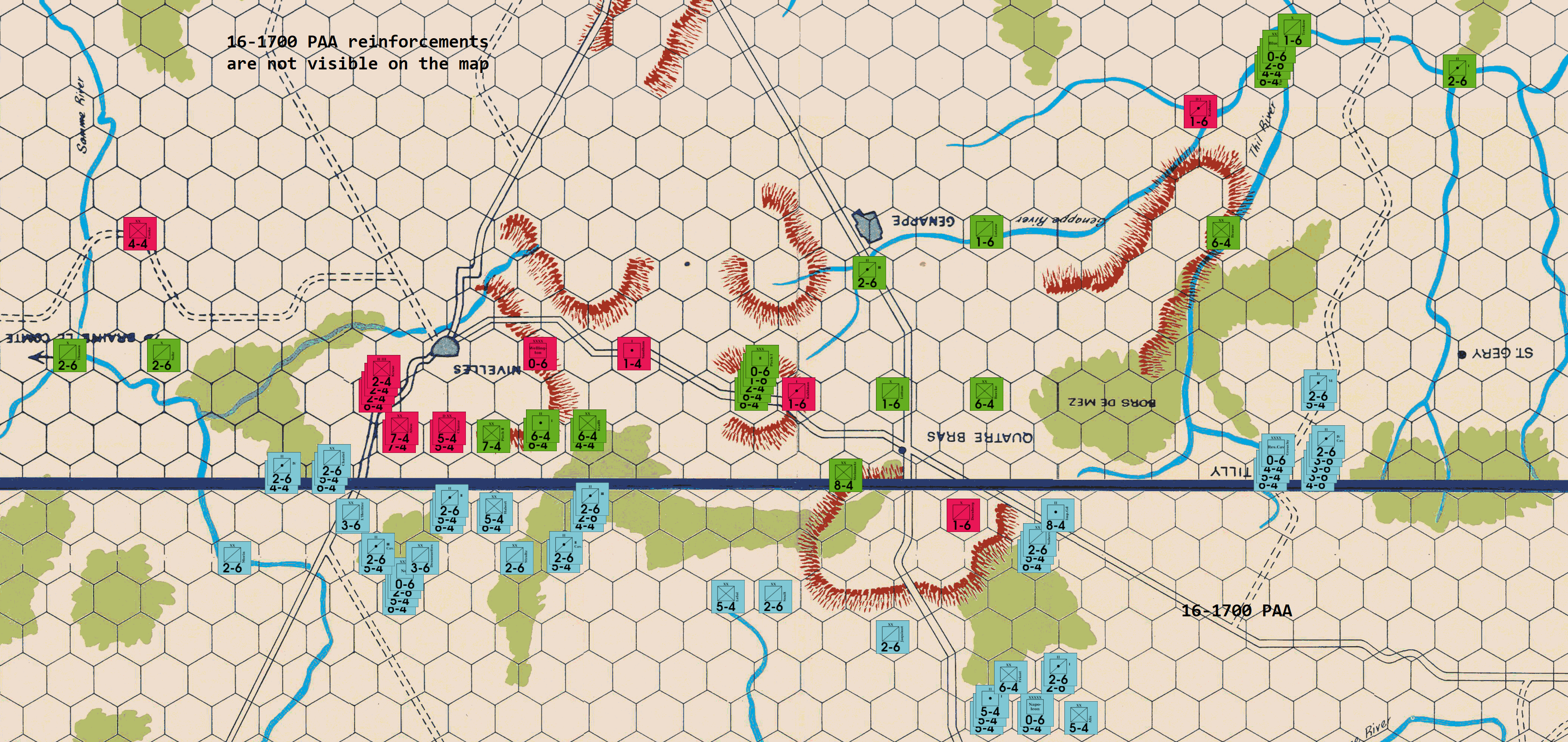
The French are all set up to come through the woods in front of Nivelles. We cannot stop 3:1s any longer without lots of delay units. However with the bulk of PAA forces nearby, and woods to the backs of the French, a PAA counterattack here could be very costly for the surrounded French. In addition, many French soakoffs will be required to get those 3:1s. Unfortunately I had to give up the heights as I could not stop 3:1s. I have a couple of turns at least of being able to mostly hold up the French with a single delay unit in that corridor however, so I may do that depending on the situation at Nivelles. The Tilly corridor is open to the French for now. However the French will need to make some allocation decisions between the Quatre Bras gap and the Tilly corridor. Will the French take a 2:1 at Quatre Bras, maybe? It would be a somewhat awkward 2:1 in this position as the French factors would have to pull Cavalry from Tilly or risk more than 6/12 factors on a 1/2 AE or AE.
Time is on the PAA side, but it is still early. How hard will the French push at Nivelles?
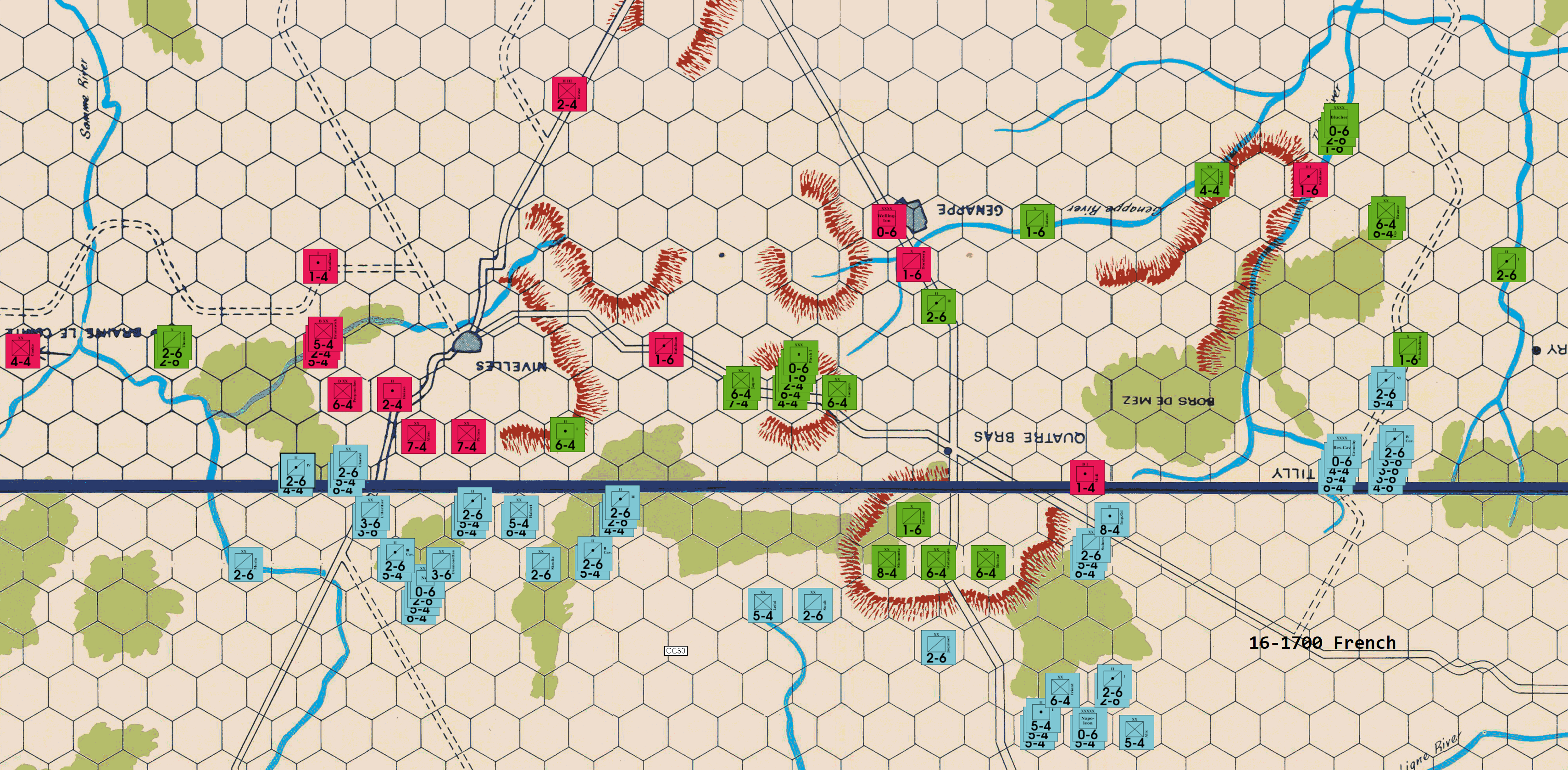
The game – at least in my view – has now arrived at its first truly critical juncture. With Ney's units preparing to debauch out of the forest corridors just south of Nivelles, and the Imp. Gd. Foot Arty pushing forward towards the northern end of the Quatre Bras Gap, the Allied player will very soon have to decide whether or not to attack the advancing French, and if so, where: Nivelles or Quatre Bras? Needless-to-say, this means that, if he does decide to attack, then the PAA player will be the one to initiate combat wherever he chooses to strike and hence, will have the advantage in the early stages of the battle. Moreover, to add to Napoleon's worries, the eight units of the Anglo-Allied cavalry reserve (including six precious 1-6s), also enter play in the northwest corner of the game map on this game turn. And although the "Road to Hal" entry hex is about as remote from the current battle lines as it is possible to get, these fresh Allied units will still be able to reach the Nivelles sector in three turns, and the Quatre Bras front in four.
Nivelles: I was a bit disappointed, but not surprised, that my opponent declined to attack last turn in this sector. Instead, and much as I expected, Richard decided to pull his western defensive line back to the "X" row, and to concentrate almost every local Prussian unit not directly involved in the defense of the Quatre Bras Heights into a large (thirty-two factor) central reserve on the primary road near W31. This is a popular practice with experienced PAA commanders, and justifiably so: it both preserves and 3-1 proofs the Nivelles defensive line (at least for one turn), and it also allows a formidable Prussian force to occupy a position from which it can move either back to Nivelles, or to Quatre Bras in one bound. Since there is nothing that I, as the French player, can do to interfere with this move, I have no choice but to "suck it up," and then to wait to see what the Allied commander ultimately decides to do.
So far as this turn's French unit dispositions in the Nivelles sector are concerned, they are about as balanced – and (hopefully) awkward for the PAA player to attack – as I can make them. The downside of this particular approach, I have to admit, is that it pretty much precludes Ney's forces from exerting significant pressure against either the Samme River defenses, or the "Braine le Comte" entry hex, at least temporarily. One final observation that I think warrants inclusion in this commentary is that, because of the complex terrain in the Nivelles sector, I believe that it is absolutely essential for the French commander to maintain a robust reserve force that can switch east or west in a single game turn. If he does not, then he runs the risk of sitting by helplessly while he sees one part of his force defeated in detail.
Quatre Bras: This is the first time – since the opening turns of the game – that there actually exists the possibility, however small, of an Allied attack versus one or more of the French units in the center. I personally believe that, because of the limited attack frontage that the current French position in the Gap offers, the PAA commander will bide his time until the Imp. Gd. Foot Arty has advanced one hex farther north; nonetheless, the possibility needs, at least, to be considered. That said, it is more likely, I think, that my opponent will reinforce the Heights – because of the threat against AA25 and Z25 posed by the French stack in AA23 – but otherwise temporarily refrain from attacking on this front. Of course, I could always be wrong: Richard has certainly surprised me before. And thus, instead of him holding the bulk of his reserve in readiness for a turn, my opponent could well decide that he has waited long enough, and move to either attack at Quatre Bras, or to double back to Nivelles in order to support a British counteroffensive on that front. Only time will tell.
The Tilly Corridor: The Allied commander has left another
delay unit – this time a Prussian 1-6 – in his ongoing campaign to stall French
progress into the Tilly Corridor; and like the previous Anglo-Allied blockers,
the Prussian cavalry unit is also dispatched with a minimum of fuss. This
particular situation – at least in my view – illustrates, very nicely, why I
personally think that the PAA player should commit at least twenty-seven (if not
more) factors to the early defense of this sector. As things currently stand,
the Allied Tilly contingent in this match – which presently totals only
seventeen factors – is too weak to attack even a single French 6-4 at 3-1, and
is also poorly suited even to attack an exposed seven factor French stack
composed of a 5-4 and a 2-6. I can guarantee that, if twenty-five or so Prussian
factors had been lurking within supporting distance of the delay unit, then the
French force advancing to eliminate the unlucky Allied 1-6 would have been a lot
stronger than seven factors. As things currently stand, the bulk of Marshal
Grouchy's detachment can stay where it is – within range of both the Quatre Bras
Gap and the Corridor around St. Gery – for a game turn, and not really pay much,
if any movement penalty, when it comes time for it to resume it's push north
towards Wavre.
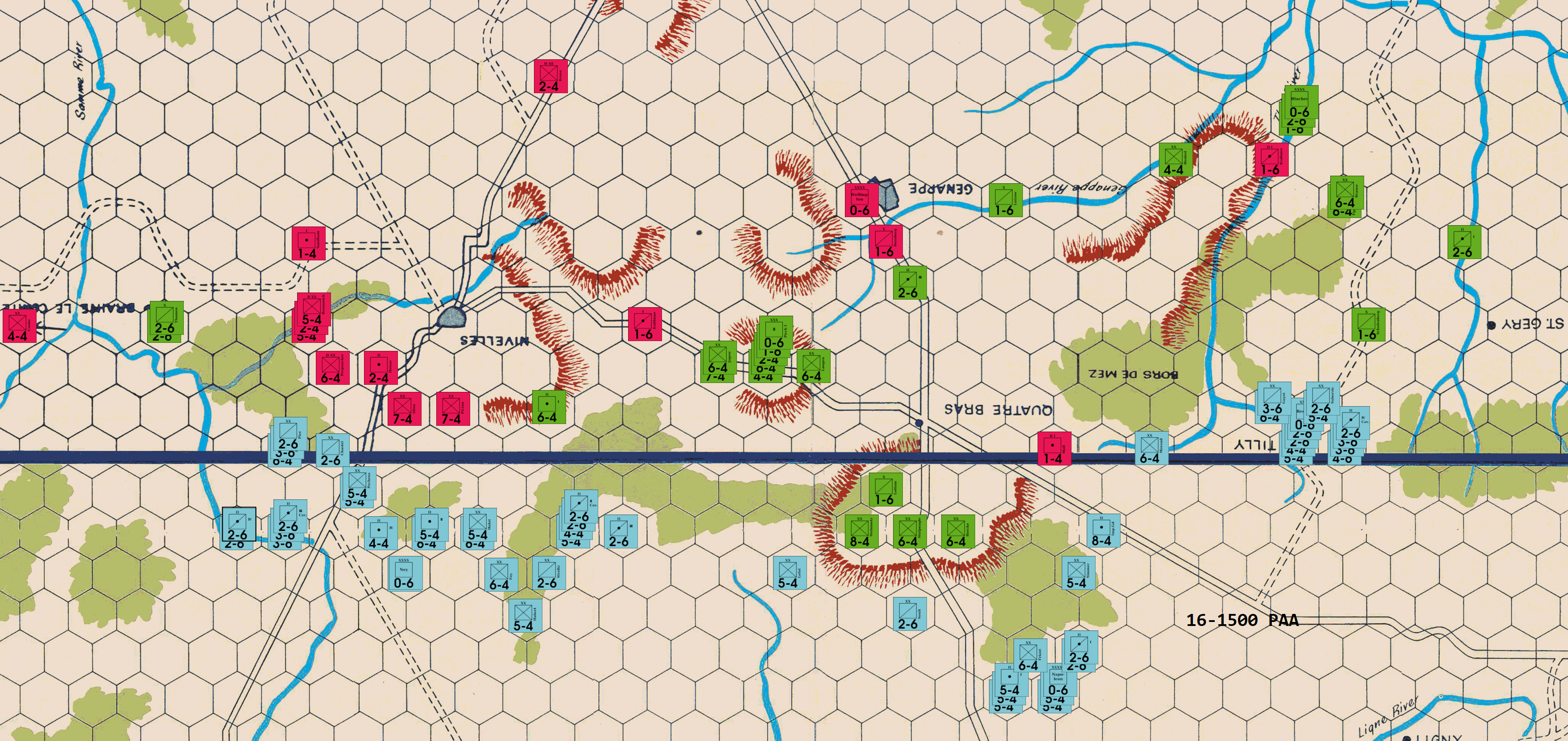
As unfortunate as it is to have the French cavalry escape, that is a relatively minor roll in the grand scheme of things. The French commitment to the woods South of Nivelles is quite large. What counterattack opportunities will the French decide to give the PAA at Nivelles in order to push their way through? Blucher prepares for a withdraw in the Tilly corridor, looking to preserve some 1-6s for later instead of using them all right now. With this last delay position, his cavalry will still be 7 hexes from the rivers to the north, enabling the PAA 2 turns still on that front. The French have abstained from low odds attacks so far and have been very patient. I hope that continues.
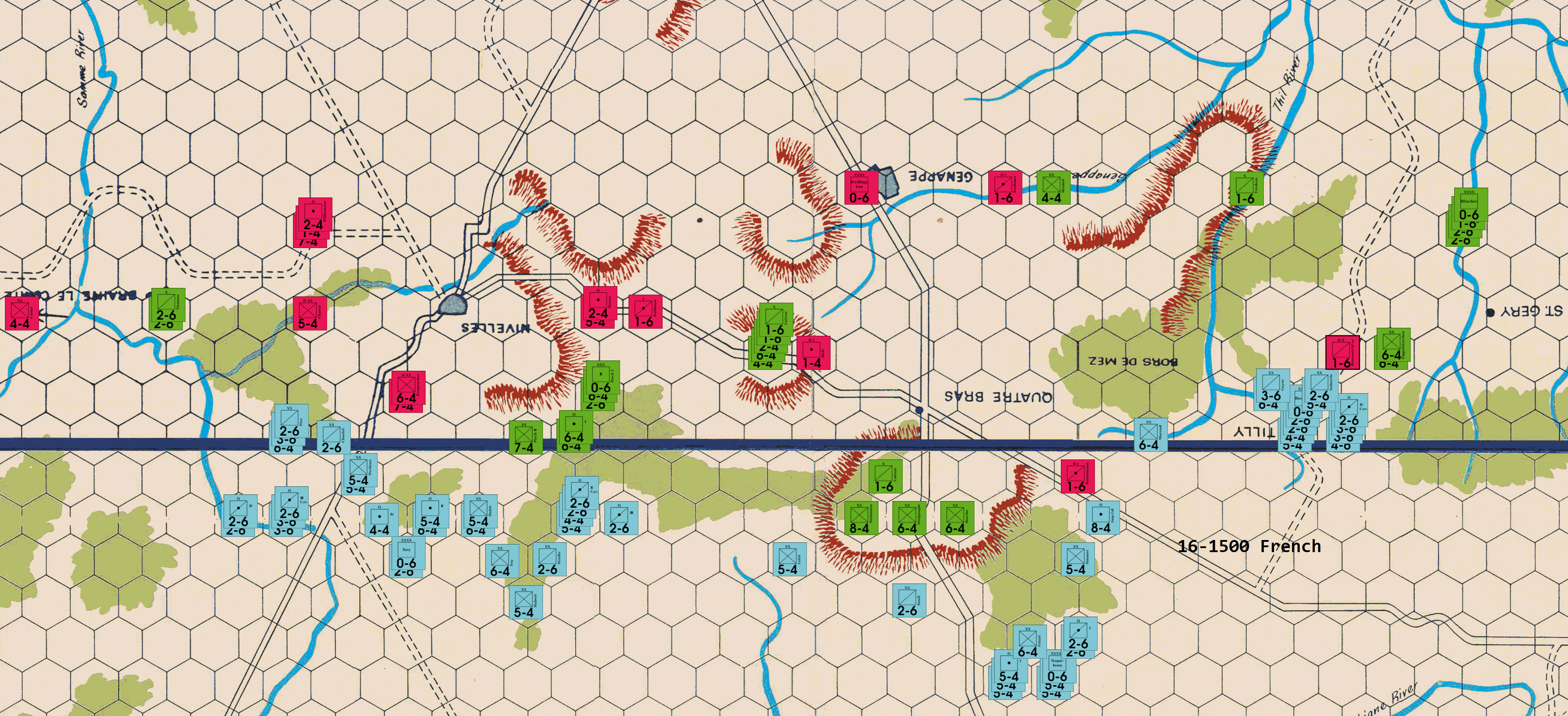
Some of the French units in the "33" file are currently recovering from a spoiling attack delivered by Blucher's forces last turn. The good news is that the French cavalry unit, Domont, which was the focus of the Prussians' ire managed to catch a break when it escaped destruction at the hands of the Prussians; the bad news is that Napoleon's Left Wing is now behind schedule in the west, and that unwelcome development is very likely going to create problems for L'Armee du Nord in other sectors of the battle area as the first day of the campaign moves from afternoon to evening.
Nivelles: Because of an unforced French error, Ney's western detachment is already at least one full tempo behind in its offensive operations against the Allied Right. This probably needn't have been the case, as the origin of this setback: the deployment, on the 1300 game turn, of eleven French factors at Z33 was – at least in my view – a worthwhile gamble, especially considering the fact that, if successful, it would have had the potential to apply real pressure against any Allied units at X35on later game turns. Unfortunately, after planning the move with Division Foy and two cavalry units stationed at AA33 [I was, I should note, acutely aware that there were several Allied 7-4s lurking in the immediate neighborhood], I inexplicably decided (at the last moment, naturally) to move the 6-4 from AA33 to the switch hex at CC33. This was an inexcusable mistake – especially against a player of Richard's caliber – as it allowed my PAA opponent to block the forest corridor southeast of Nivelles with the 3-1 proof Pirch II during his portion of the game turn. And because of this serious French lapse, the presence of an Allied 7-4 at Y35, not only meant that Ney could no longer safely take possession of Z36 – because any units in that hex would be vulnerable to a surrounded attack – but also that any French units moving into Y39 would be seriously exposed because of the absence of a credible French threat on Ney's right flank.
Looking to the present, the current French move is an attempt to salvage something from Ney's botched advance, and to hopefully get the French drive pushing forward again against Nivelles. Since the local Allied units are, at the moment, all pretty much immune to attack (at least at reasonable odds), the best that I can do this turn is to position the majority of the French units in the west in such a way as to make another PAA spoiling attack awkward. I should probably also add that, while I usually eschew low-odds attacks as a means of retrieving a position after I've made a mistake, I did seriously consider attacking Pirch II at either 1-1 or 1-2. And yes, I think that the opportunity to attack a valuable unit like a 7-4, without having to soak-off, is almost always appealing. [I know many players would have at least considered a 2-1, since the units making such an attack would have had a 70% chance of holding Z35 at the end of their combat phase.] The downside of resorting to a low-odds gamble in this instance – at least as I see it – was not the 30% possibility of an A Elim, but the nontrivial possibility of an AB2, which, I was sure, would see a French retreat into Z36, with all of the problems that occupying such an exposed hex would create for Ney's Left Wing on the 1700 game turn.
Quatre Bras: As I expected, Richard decided to reinforce the Prussian line on the Heights, by moving a 6-4 into AA26 last turn: this move, by the way, does nothing to really strengthen the Heights, but it does modestly increase the "opportunity cost" of a French surrounded 1-2 versus Steinmetz. Elsewhere, the units of Napoleon's central reserve continue to cluster together in hexes from which some or most can move, in one bound, against either the Quatre Bras Heights, or against the Gap. And barring some unexpected development, the positions of these reserve units probably shouldn't change much in the short-run. A little farther to the east, the Imp. Gd. Foot Arty continues it's steady one-hex-per-turn advance ever deeper into the Quatre Bras Gap. This advance currently presents virtually no threat to Blucher's defenses in the center and hence, it is pretty much being ignored by the Allied commander for the time being; this current lack of interest on the part of my opponent, however, will almost certainly change in the next few game turns.
The Tilly Corridor: Grouchy's contingent (the French Right Wing) remains stalled – much as it has been for the last couple of turns – at the southern end of the Tilly Corridor. Only this time around, instead of doling out a delay unit, the PAA commander has deployed a delay unit along with his two local 6-4s, in hopes of picking up a French soak-off unit on the cheap. This is a ploy used by some seasoned Allied commanders which, when sprung on some French players, will occasionally work. In my case, not so much. To be fair, I will admit that, if the Allied Tilly force were considerably stronger than it currently is, then I might consider risking a French 3-6 to a 1-4 soak-off; as things stand in this game, however, rather than risk the soak-off, I have instead decided to offer Richard a surrounded attack on one of the units in X19. If I were in Richard's shoes, I wouldn't risk such an attack; we will soon see if my opponent sees things the same way that I do.
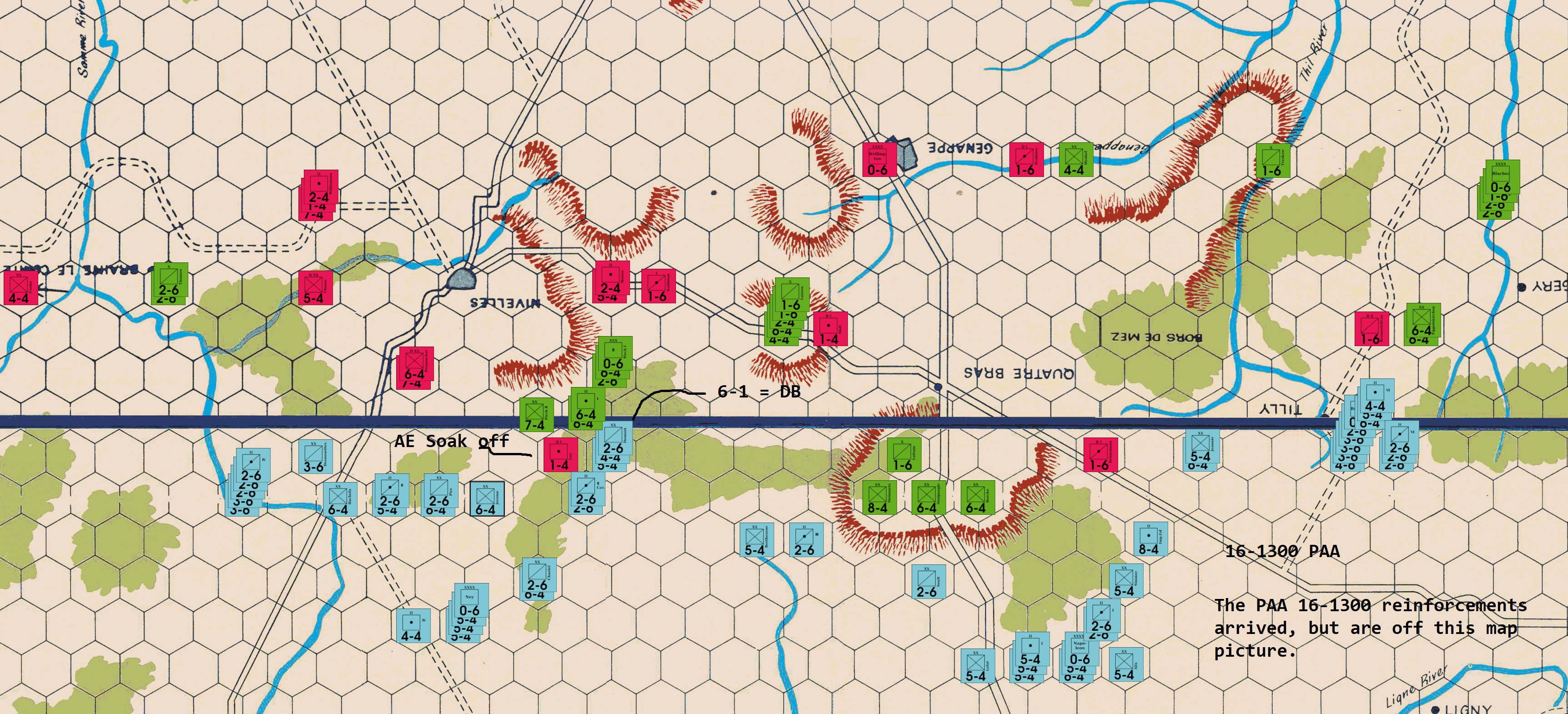
The woods south of Nivelles can be tricky. I decided to try a counterattack to attempt to spoil the French progress here. It will be interesting to see if the French devote any forces to the west edge of the board, near the road to Braine le Comte. This would spread the PAA thin but would take away from the attack south of Nivelles. In the center, I feel the French may be getting frisky with a 1:2 or a 2:1, so I decided to make it more expensive for him to take that gamble. We are running out of delay units in the Tilly corridor. The French are pressing us hard and it is no longer possible to avoid contact along most of the board. How hard will the French push for objectives over the next 3 turns? Uxbridge's cavalry corps is needed soon.
Joe is being more cautious than I expected. I am tempted to counterattack but I await a better opportunity to go all in. For now I will have to keep reserve counterattack force positioned in the right spot and wait. The PAA is at it's weakest on the front right now, as the French are fully developed but the PAA reinforcements have only started to trickle in.
Wellington's afternoon briefing, Genappe Headquarters
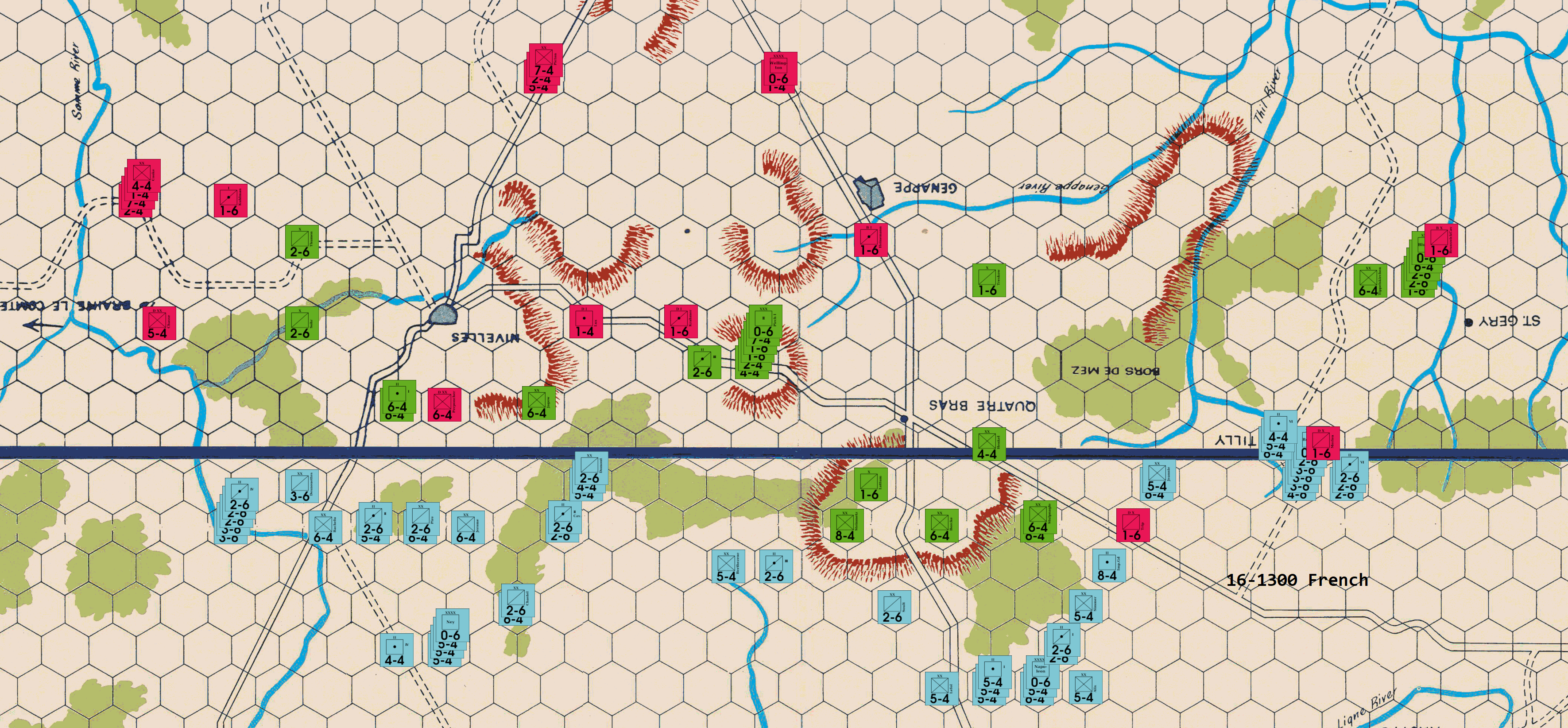
Nivelles: Based on Allied dispositions, it is here that I am convinced my opponent will make a major effort to inflict early damage on the French army. The roughly forty Prussian factors currently within striking distance of the Nivelles battle area, combined with the steadily increasing combat power of the local Anglo-Allied contingent, will provide him with an impressive "first strike" capability when Ney's Left Wing finally begins its advance into the forest corridors south of the town. Which, I should note, is why I often commit eighty + French factors to this front: Ney's force has to be able to absorb a couple of PAA attacks, and still be strong enough to strongly punch back. The good news for the French, such as it is, is that the PAA "Non-cooperation" rule makes coordination between the two Allied forces awkward, and once the PAA commander commits his units to battle, the Prussian "2" value units will be easy (and obvious) targets for the French.
My approach to French operations in the Nivelles sector on the 16 Jun 1300 game turn will vary depending on just how large the Prussian commitment is to this front. When faced with a smaller Prussian contingent (e.g., less than thirty + factors), I will usually push the newly-arriving units of the IInd Corps immediately into the forest gaps to occupy hexes Y39 (two 3-6s and a 2-6), Z38 (one 5-4), Z36 (one 6-4 and a 2-6), and Z35 (one 6-4). Against this many Prussians, however, such an advance is a bit too audacious for my taste, especially as my opponent would then be able to easily (and inexpensively) attack both of the eastern 6-4s at 3-1, or probably more likely, one 6-4 at 5-1, with a single Anglo-Allied soak-off (from Y37) relieving the Allied player of having to use one of his precious Prussian 1-6s. That said, I have opted to form the French battle line one hex row farther to the south. This line can still be attacked at reasonable odds by the Allied player, but at least those attackers will then be exposed to a powerful French riposte. I should also probably note that Desnouettes (on hex Z39) has been deployed in this exposed position so that the Allied commander cannot move a single PAA "1" into Y39, which would be a very economical way of stalling the French advance in this sector for another game turn. The reason that the 3-6 has been chosen is that it requires the attacker to commit fifteen factors for a 5-1, and twenty-one factors for an AV; and usually the PAA player will have better things to do with his units.
Quatre Bras: Napoleon's central force has been deployed so as to prevent Steinmetz from vacating AA27, while also applying pressure in the Quatre Bras Gap. I usually power the French push into the Gap with the Imp. Gd. Foot Arty because this unit can only be attacked at 3-1, from two hexes, and it is also awkward for the Prussians to attack and to exchange against.
The Tilly Corridor: As is Richard's usual practice, the Allied presence in the Tilly Corridor is a little weaker than in most games. I know that my opponent wants to retain as much Prussian combat power on the main Nivelles-Quatre Bras Fronts, but the failure to include even a single 4-4 with the Allied contingent – in my view, at least – diminishes the counterattacking possibilities of the Prussian Tilly force dramatically. In any case, since there is very little else for them to do just yet, I have mobbed the entrance to the Corridor with a force of thirty-six factors. The key to this move, I should note, is not the stack of French infantry at Y19, but the fact that there are currently twenty-one factors of cavalry clustered close to the southern end of the Corridor so that my opponent will have to screen his two 6-4s from attack, at least for a turn.
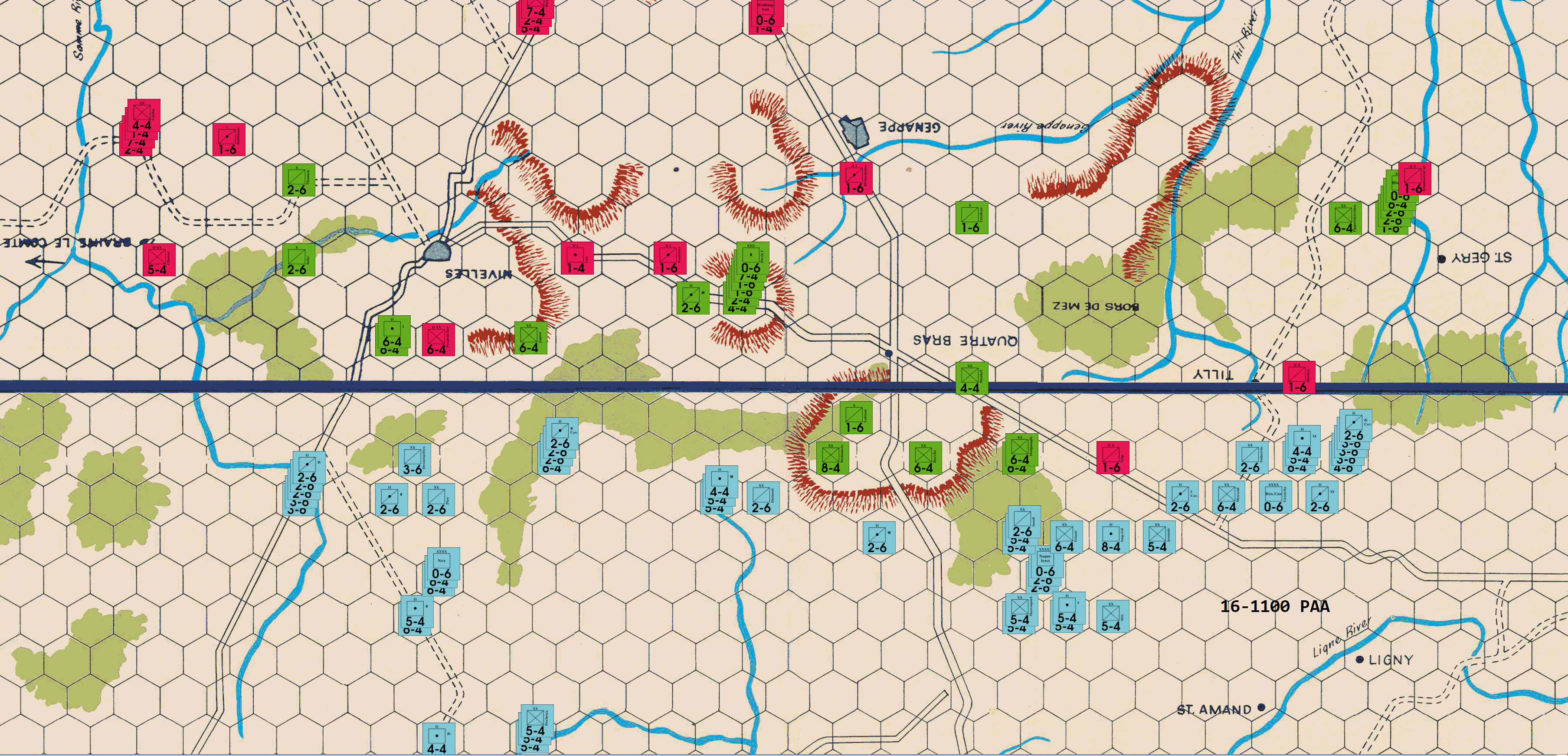
The French clearly are setting up to come through the woods southeast of Nivelles. On the eastern flank, the French are being cautious so far. Delay cavalry in the Quatre Bras gap is buying the Prussia counterattack force some time to check the French advance on Nivelles. It is a critical turn for the PAA. After the next PAA move the British forces on the board will be consolidated around Nivelles and can concentrate for counterattacks. It is unclear how much force the French will send down the Tilly corridor, but we certainly don't want to allow the French cavalry in that sector too much freedom of manoeuvre just yet.
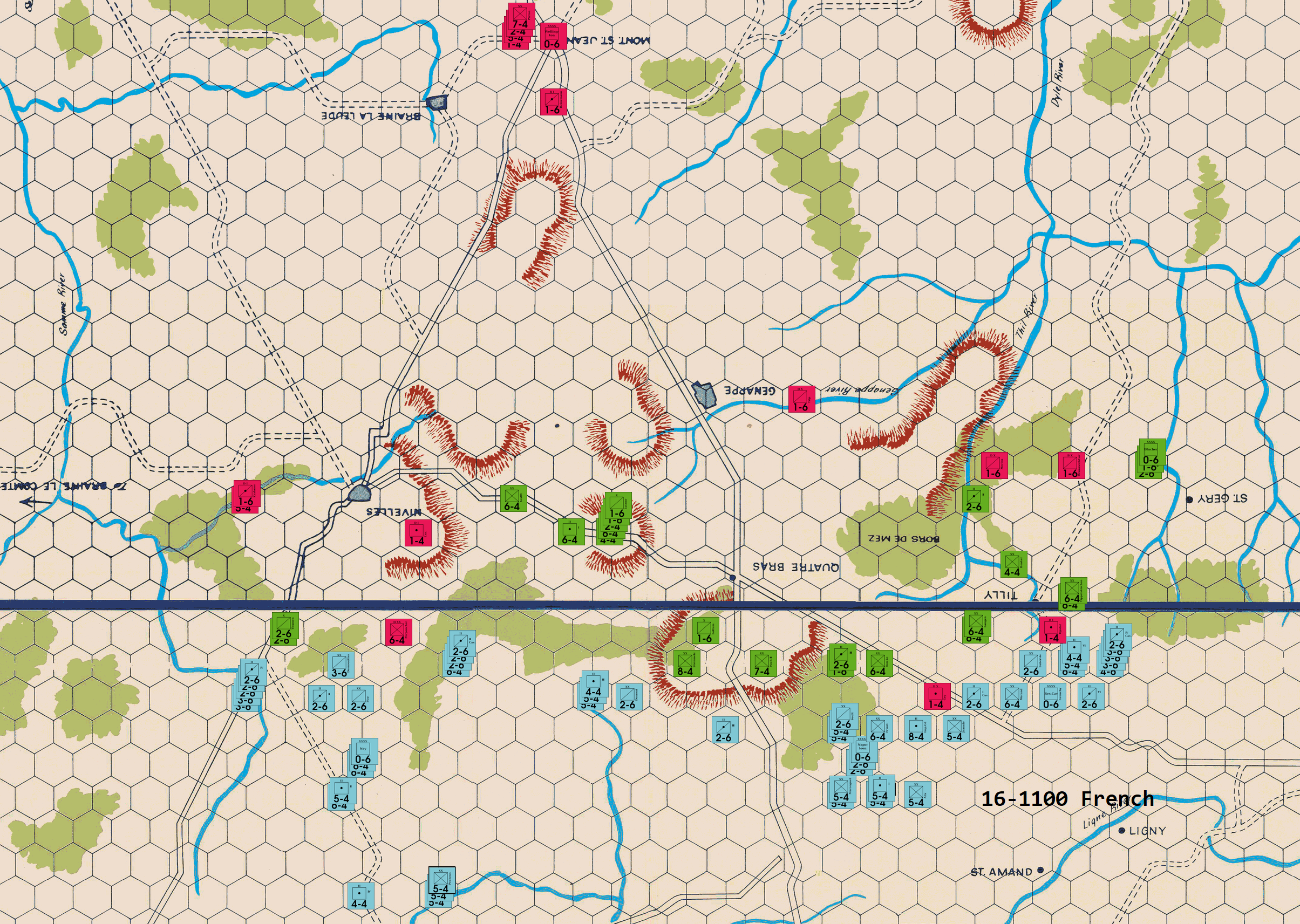
On the whole, the game is developing along fairly conventional lines.
Nivelles: My opponent has, as expected shifted more of the Prussian Army west to support the outnumbered Anglo-Allies around Nivelles. The one irritant is that Richard has had the foresight to deploy two Prussian 2-6s in Z38 which has prevented me from moving Desnouettes into AA38. That being the case, the early arriving French cavalry have to content themselves with occupying AA36 while they await the immanent arrival of the first wave of French infantry coming from the south. In addition, elements from the French forces in the center have shifted west into the "33 hex file," so as to put pressure on any Allied units attempting to block the forest corridor southeast of Nivelles. Ultimately, I will probably commit 80 plus French factors to the Nivelles front, as I consider it vitally important for Ney's Left Wing to win this fight and for that force to clear the forest corridors south of the town early enough for Ney to batter his way into Nivelles by the end of the 16th. I don't expect much to happen on the PAA portion of the 1100 turn, but things could well "heat up" on the 1300 turn.
Quatre Bras: Richard has stripped off – temporarily, I expect – some of the Prussian infantry that were previously defending the Quatre Bras Heights. So long as the Prussians scattered along the primary road, from V34 to W31, remain within one turn's march of AA27, then this is not as risky as it might initially appear. However, if it looks like the Allied player is going to commit his central reserve to the Nivelles sector, then I will shift one of the Imperial Guard 6-4s currently in Quatre Bras Gap to EE21, so that it can be within a single march of BB26, and hence could help power a 1-2 (Surrounded) against Steinmetz. I should also note that one of the problems that I have with the PAA commander removing the Prussian 5-4 prior to play, is that this tends to improve the defensive power – when exposed to attack from only one hex – of the French 5-4s, especially those 5-4s assigned to the Gap: arranging Prussian stacks of fifteen factors simply becomes both awkward and risky.
The Tilly Corridor: I confess that – at least for the moment – the Allied dispositions in the Tilly
Corridor mystify me. The PAA 0900 move gives every indication that my opponent
intends to divert some of his Tilly combat power back to the center. The
dispositions of the Prussian II Corps Hrs. Arty and Merlin, I find especially
perplexing. I will say that – in my view, at least – there is a critical mass
of combat power that the Allied player should commit to the Tilly sector; if he
does not, then he leave himself especially vulnerable to surprise French
low-odds attrition attacks.
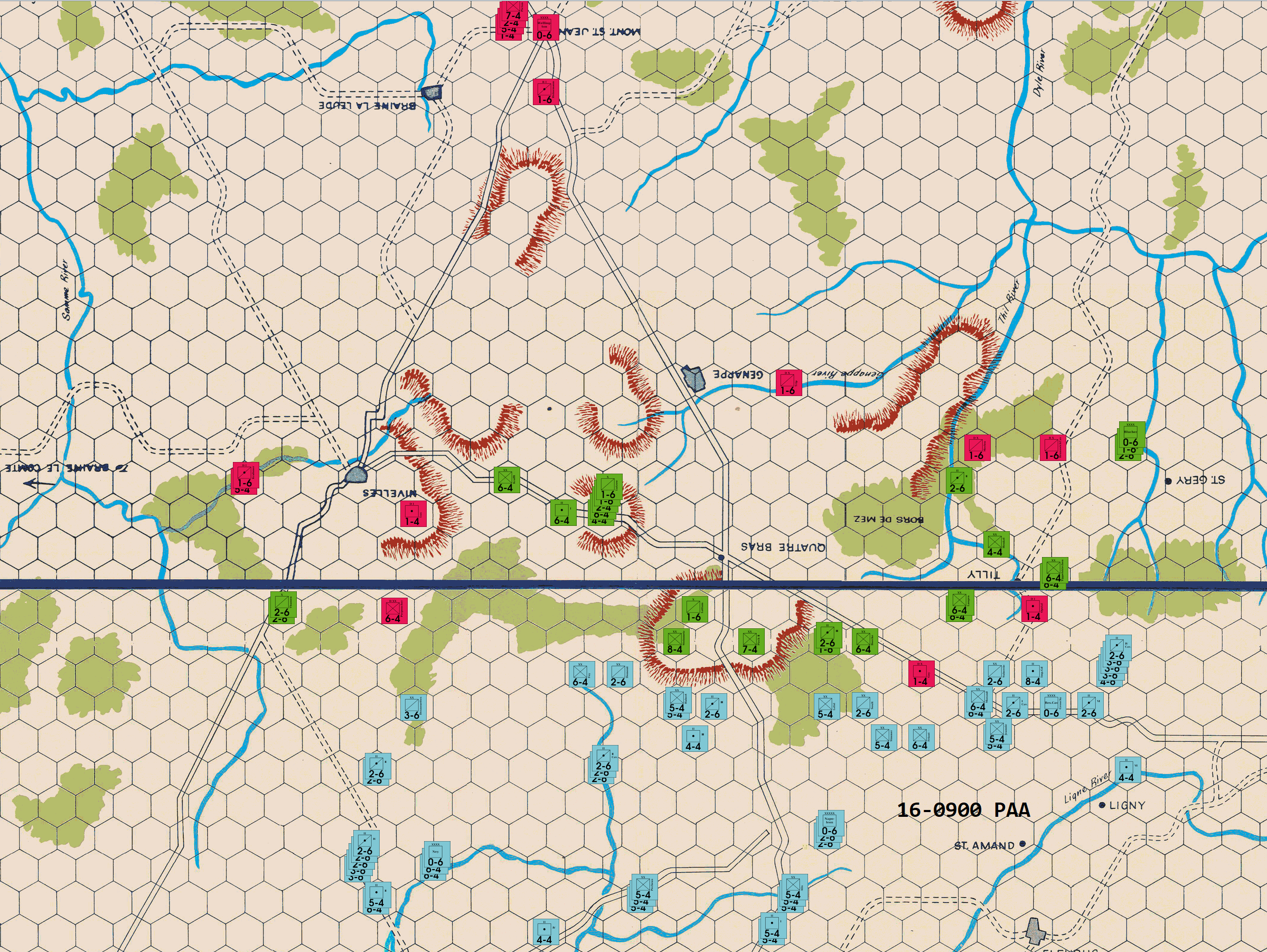
Generally the PAA wants to keep the French as far South as they can afford to early on. Some tough choices this turn, I will very soon not be able to quickly transfer troops between the Tilly corridor and the Quatre Bras heights. I typically don't put out 2 soak offs on the Quatre Bras front every turn. However the French center is aiming at the woodline southeast of Nivelles, and I'm sure it is no accident that Foy (6-4) and some horse artillery (3x 2-6) are exactly close enough to the French side of that woodline this turn. The Prussians have to be ready for some fighting in these woods and we can't have the French advancing too quickly on the other flank while the Prussians are fighting there.
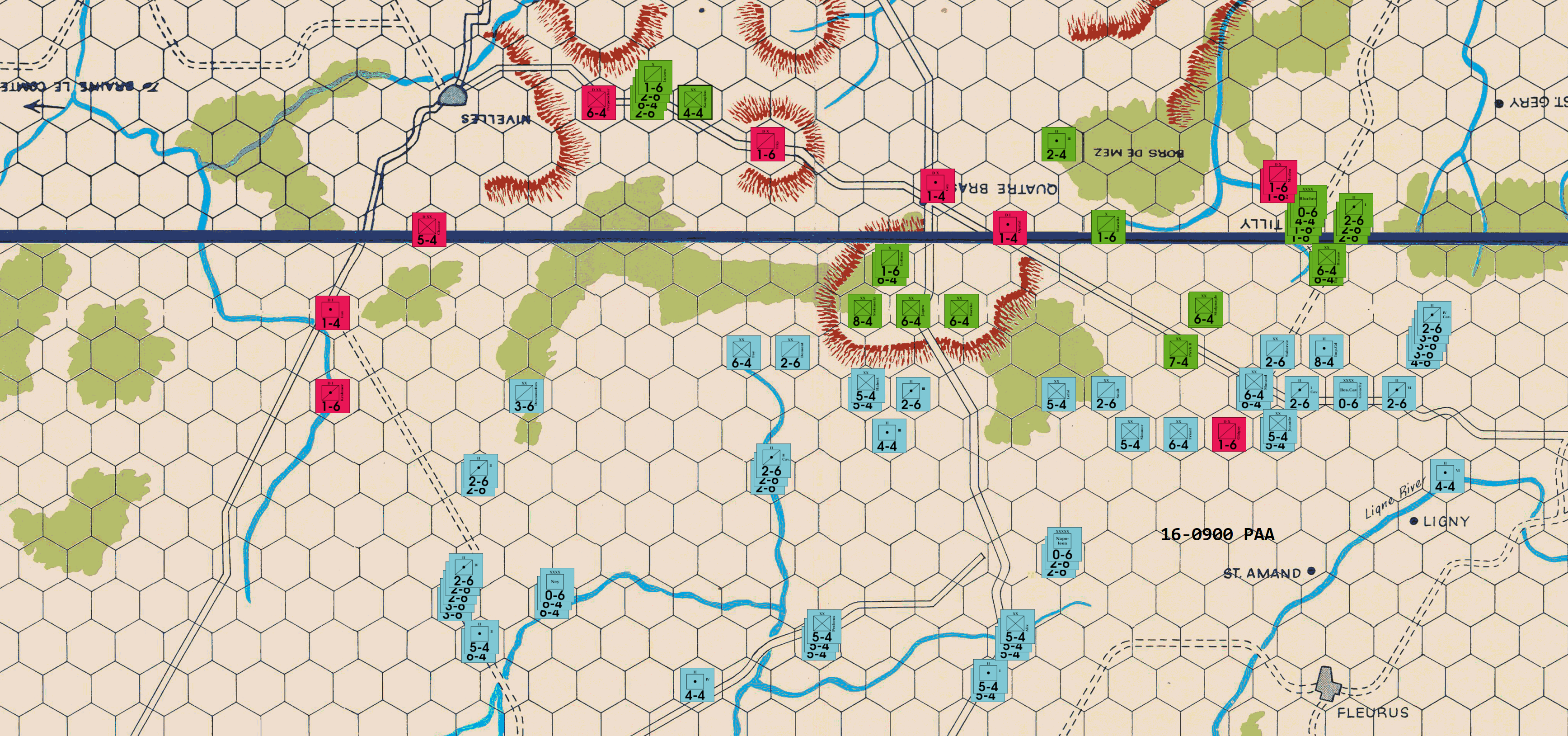
Richard's 0700 move is pretty much what I anticipated.
Nivelles: Fifteen Prussian factors are already marching west to support the Anglo-Allies; however, I fully expect – assuming that neither of us gets adventuresome in the center – that this contingent will ultimately be reinforced to thirty or more factors. Interestingly, Perponcher has stayed on the primary road (which is my own approach), and this means that, if necessary, this unit can quickly move (in one bound) to occupy the useful switch position at V41.
Quatre Bras: My opponent pretty much always takes the early defense of the heights very seriously, which is why Richard has deployed both a 1-6 and a 6-4 at Z27. With these dispositions, the Allied player – if Napoleon gambles on an early 1-2 versus Steinmetz and rolls a DB2 (D Elim) – can immediately, and without exposing any of his units to an undoubled attack, still mount a 3-1 counterattack against any lucky French unit which has declined to advance into AA27 after combat, but has, instead, elected to remain on BB26. Farther to the east, the Allied player has economically delayed the French advance with a single 1-6, and backed up his blocker with Prussian infantry at BB20 (the 7-4) and AA20 (two 6-4s). For those who are curious, the 7-4 is required in this instance because the French dispositions are such that a 6-4 in BB20 can be attacked (with a soak-off) at 3-1.
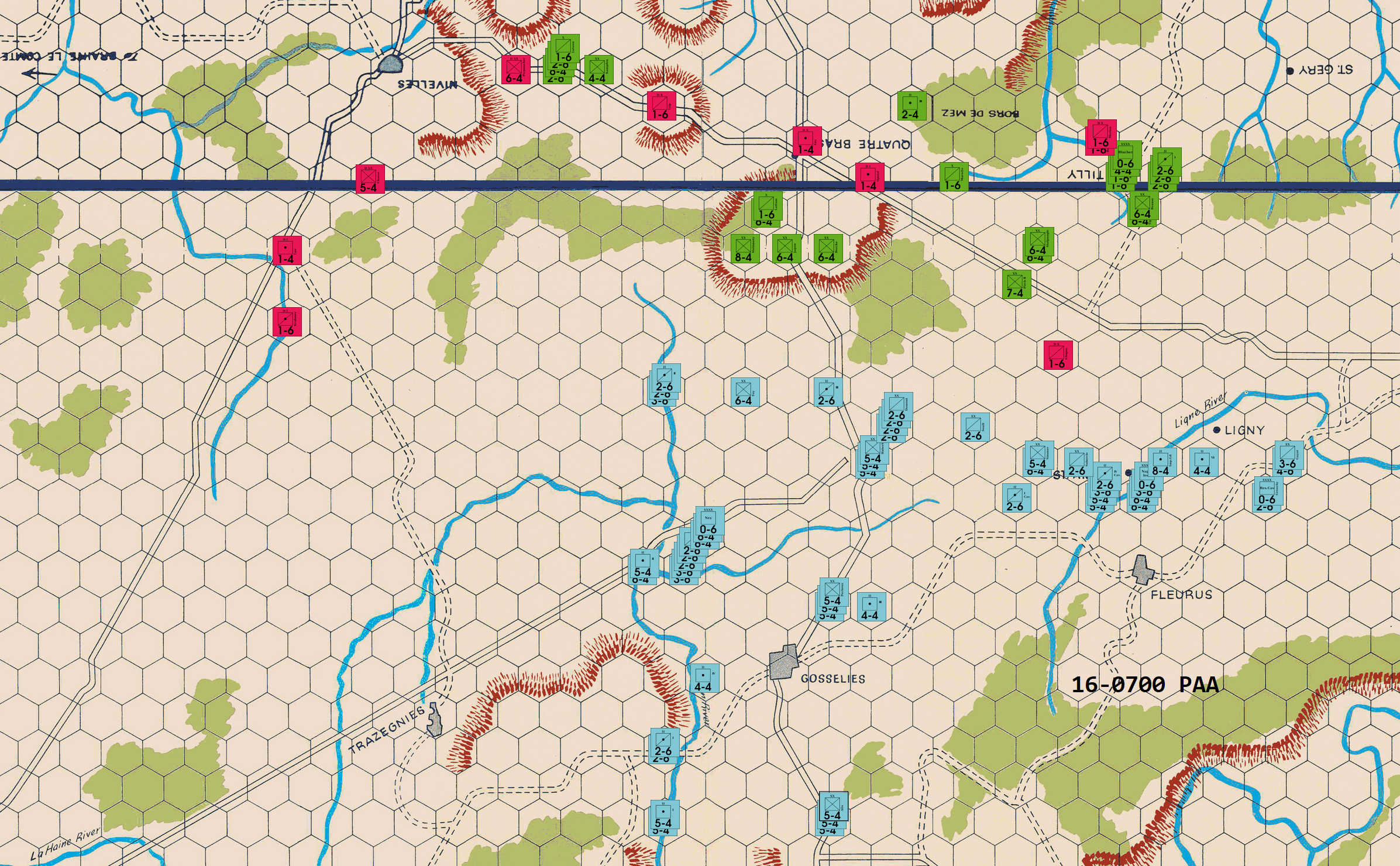
Hi Joe. I appreciate your kindness in viewing my oversight as a gambit. I do think that a long battle in the center with little maneuver on the flanks favors the PAA, it would have been interesting. I have looked at strategies involving the PAA not blocking the road and they aren't bad. I did not intend to do so this time but would not have been too sad to play that version.
As it stands I feel I should be a good sport and at least offer 1 unit to attack safely this turn, to thank him for his pacifist 7am French move.
The French are cautiously advancing. Blucher appreciates all the breathing room afforded to him near Ligny, and has 2 Dutch-Belgian cavalry brigades come over for delay purposes to preserve the valuable Prussian soak offs. The 7 factors of French cavalry from Goseillesare clearly making their way to the woods Southeast of Nivelles. We will need to have some Prussians ready to counterattack if they pressurethe woods gap too quickly. We are happy to give the French their choice of 2:1s in tactically safe situations on the main front.
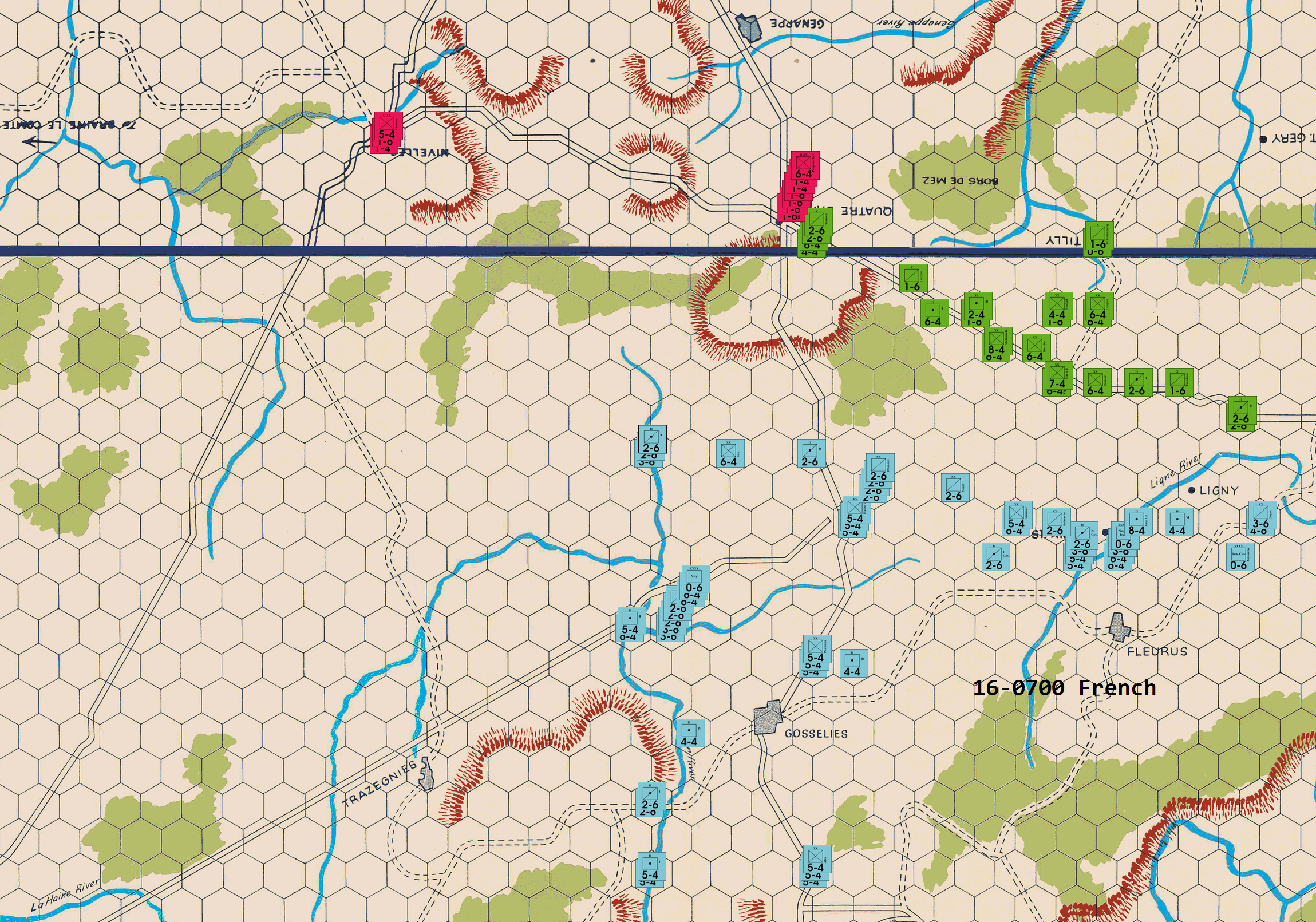
I haven't seen this high risk/high reward PAA gambit in quite a while; as memory serves, it was popular in some circles until the WBC rules changes (and delayed PAA reinforcements) began to see wide use. I confess that, under some circumstances – e.g., if I was in a hurry to finish our match, one way or the other – I might take you up on your invitation, as this gambit (if taken by the French) invariably produces an exciting and usually decisive contest, with an early resolution that often comes on the 16th. The downside for Napoleon, in this situation, is that almost all of the critical action revolves around a bloody multi-round fight for control the Quatre Bras Heights, and this means that most of the French units that would normally power the Nivelles and Tilly drives tend to get sucked into an early massive attrition battle in the center. The French can win, but both the constricted terrain and the enemy's interior lines tend – barring unfavorable dice – to favor the Allies in a protracted fight. In any case, this particular French player is not in a hurry, so I will decline your kind offer for an early fight for the Heights, and instead proceed with my original plan of campaign.
I wanted to add my thoughts about Richard's choice of unit removals.
Although I am sure that the majority of players would probably agree with the
logic of his decision to remove a Prussian 5-4 and 4-4 to satisfy his nine
factor bid, I personally consider this choice to be problematic. In a
nutshell, my main problem with these removals is that – because the PAA
commander starts the game with only one Prussian 5-4 – it's removal actually
disadvantages the Allies when it comes to combat stacking. Now that the
WBC "PAA Non-cooperation" rules are in effect, it turns out that it is actually
surprisingly difficult for the Allied player to arrange "perfect" stacks of
fifteen factors when he sets out to organize his units for combat. All
those Prussian 6-4s are formidable on defense, but their signal disadvantage is
that unlike the French 5-4s, they are really awkward when it comes to arranging
them in stacks of fifteen, and also unlike L'Armee du Nord (which has six handy
3-6s), there are no Prussian 3-6s that might be used to top off a pair of 6-4s.
Hence, if I win command of the PAA with a bid of "9," then my strong
preference is always to remove a Prussian 6-4 and 2-4, and an Anglo-Allied 1-4;
these removals are not quite as economical as Richard's, but they do help to
preserve Allied early and middle game combat stacking.
